Early Los Angeles Street Lights
Historical Street Lights of Los Angeles |
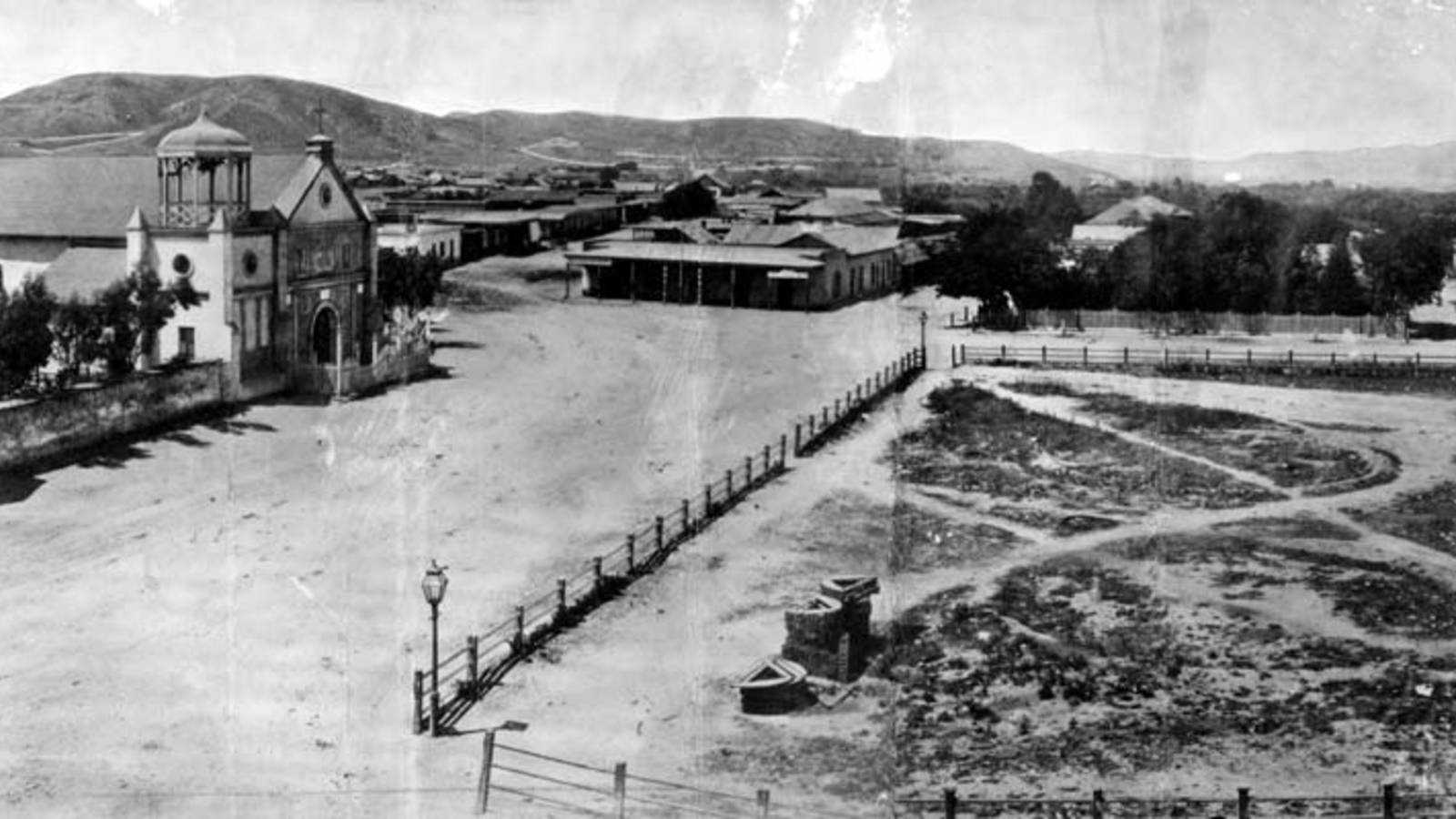 |
|
| (1869)* - View of Calle Principal (now Main Street) looking north with the Old Plaza Church seen on the left. To the right is the Los Angeles Plaza (square at the time) with two gas lamps, one on each of its corners. These were the first gas lamps installed in the City of Los Angeles. |
Historical Notes In 1867, Los Angeles Gas Company, the forerunner of today's Southern California Gas Company, installed 43 new gas lamps along Main Street, making the city safer at night. The gas lighting business was run by five entrepreneurs who manufactured the gas from asphalt, a tar-like substance, and later from oil. |
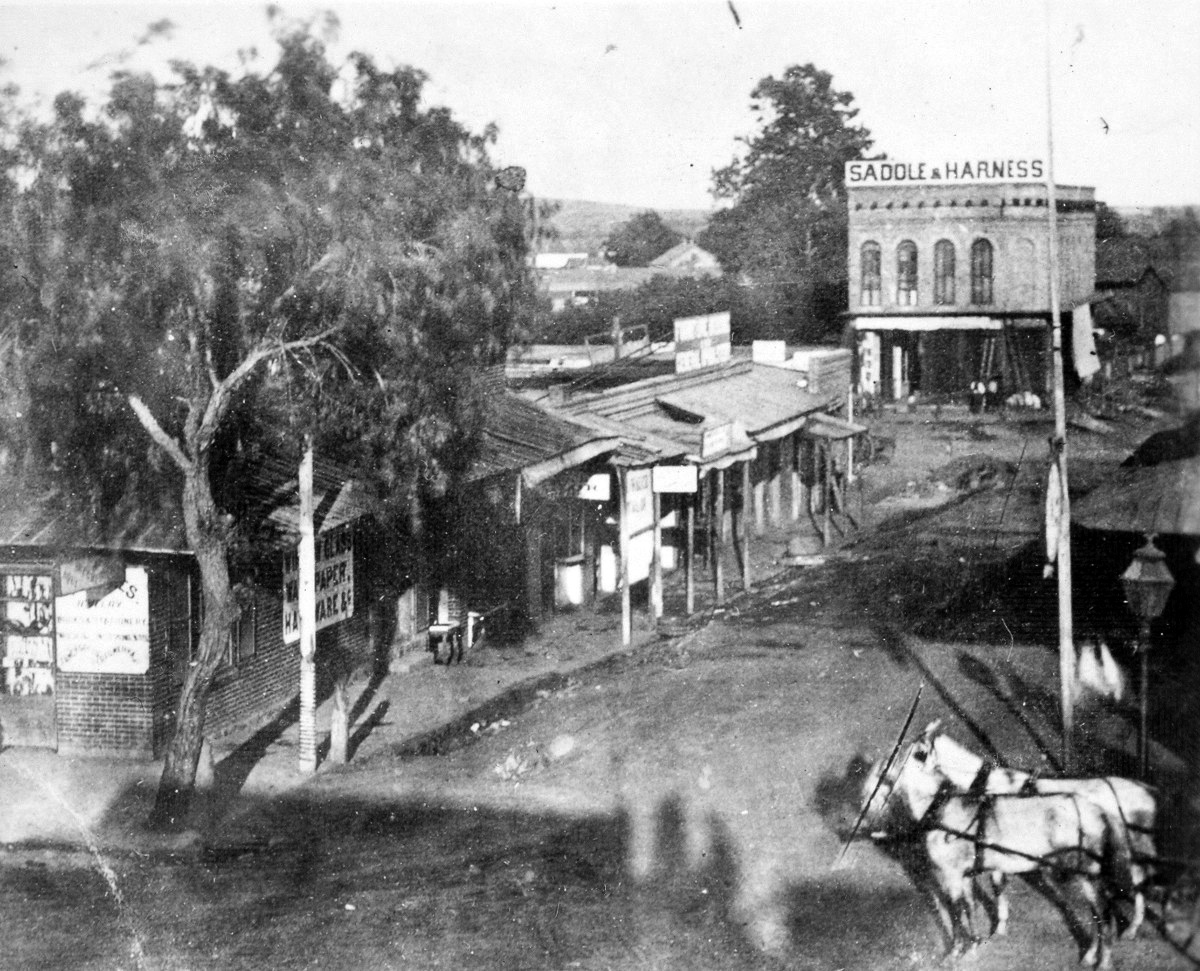 |
|
| (1869)* - Looking east on Commercial Street from Main Street in early Downtown Los Angeles. Note one of Los Angeles’ first gas streetlights at the lower right, behind the two horses. Unsurprisingly, Commercial Street has changed significantly over nearly 155 years. The stretch shown in this photo no longer exists, as the section from Main to Alameda is now occupied by commercial and government buildings. |
Historical Notes The introduction of gas lighting was a significant development for Los Angeles, which at the time had fewer than 10,000 residents. However, gas lighting was expensive, with the city paying $415 (equivalent to about $9,300 today) for a month's supply of gas in January 1870. |
 |
|
| (Early 1870s)^ - San Pedro Street, a muddy dirt street, near 2nd Street in the early 1870s. A gas lamp post can be seen standing in a pool of water. |
Historical Notes A lamplighter on horseback rode down the street at dusk to light the streetlights. By 1873, about 136 gas lamps provided the outdoor night lighting for the City. |
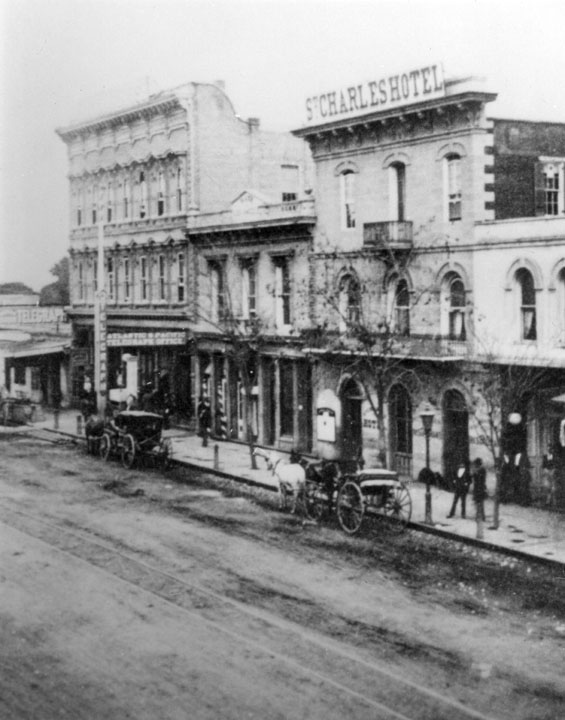 |
|
| (1880)* - View looking northeast on Main Street showing one of the City’s first gas street lamps standing in front of the St. Charles Hotel, originally the Bella Union Hotel^. |
Historical Notes The gas company was enjoying modest success until Thomas Edison introduced his electric light in 1879. In 1882 electricity was introduced to Los Angeles. That year 3,000-candle power arc lamps were lifted atop seven 150-foot poles. The state of the art at that time encouraged the use of a few tall standards with high illumination.** ^The Bella Union Hotel was considered the first hotel in Los Angeles. It became the Clarenden in 1873 and the St. Charles in 1875. |
* * * * * |
LA's First Electric Street Light
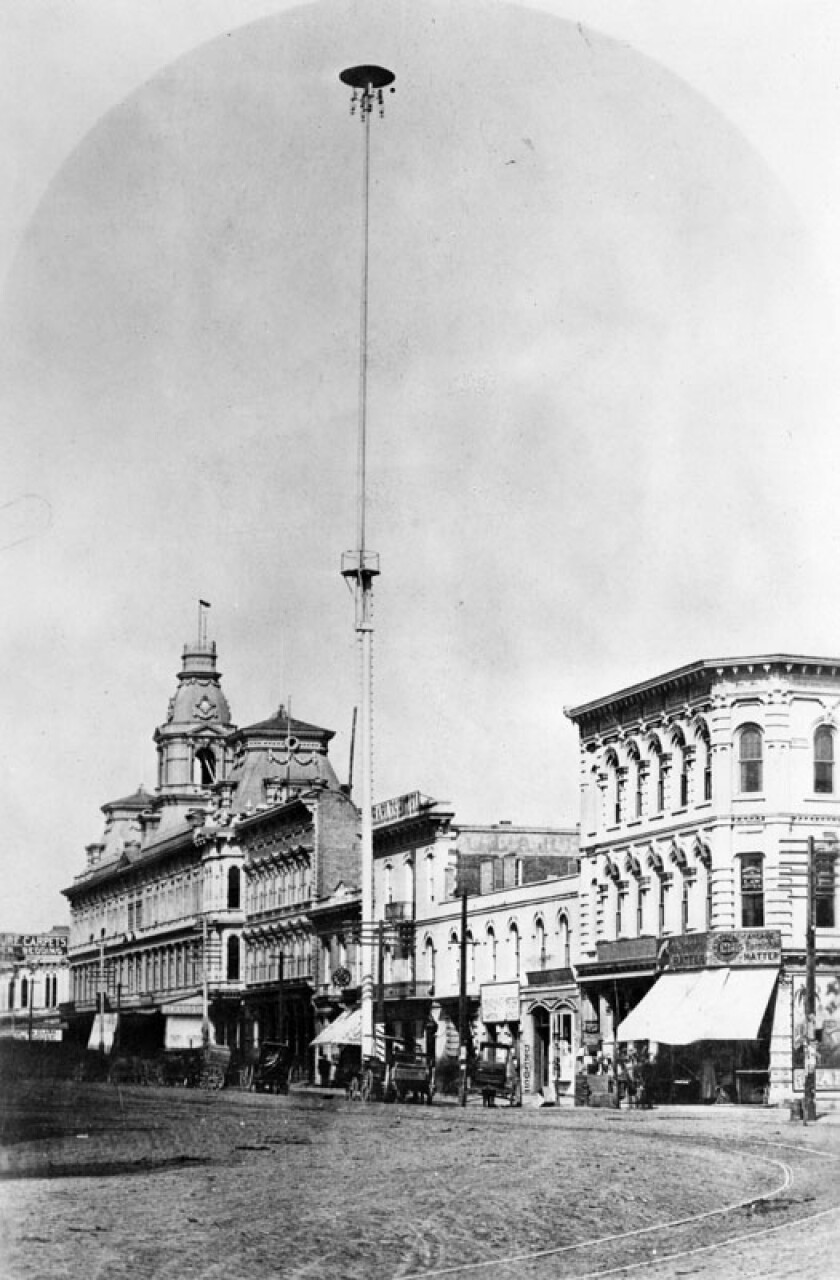 |
|
| (ca. 1882)* - One of the first of seven electric street lights installed in the City of Los Angeles, located on the east side of Main Street, just north of Commercial Street (300 block of Main St.) The street light stood 150 feet tall and was situated in front of the St. Charles Hotel where one of the city's first gas lamps once stood (see previous photo). |
Historical Notes In 1882, C. L. Howland installed seven 150-foot tall streetlight masts, each carrying three carbon-arc lamps of three thousand candle-power. He also installed a small power plant to provide the electricity for his new street light system. The following year Howland and other investors would go on to form the Los Angeles Electric Company. It was the first electric utilty in Los Angeles. Click HERE to see more in First Electricity in Los Angeles. |
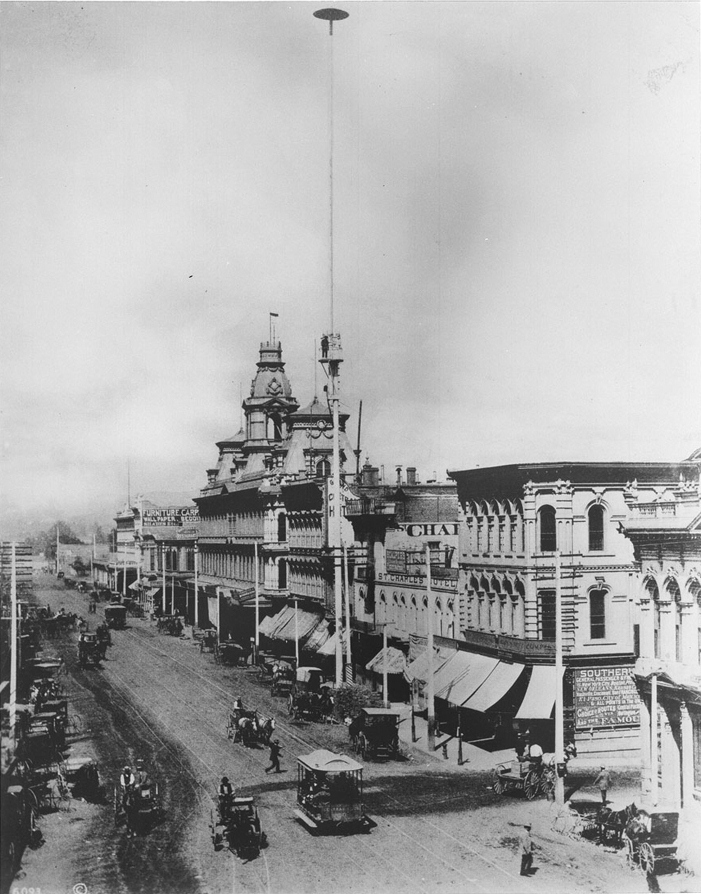 |
|
| (ca. 1882)* - Another look at one of LA's first electric light poles. View is of the buildings on the east side of North Main Street at Commercial Street at near right, looking toward the Baker Block. A man can be seen standing on a platform half way up the street light mast. |
Historical Notes Approximately 30, 150-foot tall poles with carbon-arc lamps were installed in Downtown Los Angeles between 1882 and about 1885. These were reported to provide illumination equal to the level of a full moon. |
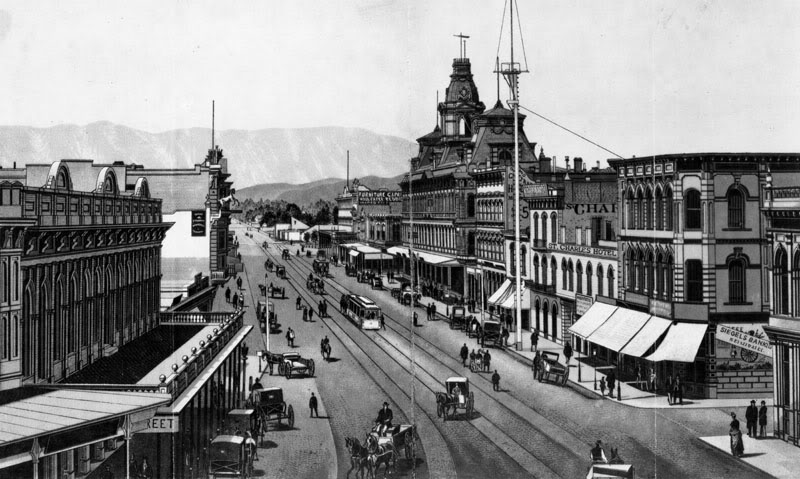 |
|
| (1880s)^ - Photo of a drawing showing Main Street looking north from atop the Temple Block. Baker Block is just right of center. This vantage point is now occupied by City Hall. This gives a good view of where one of the first 150-ft. tall street light poles stood. |
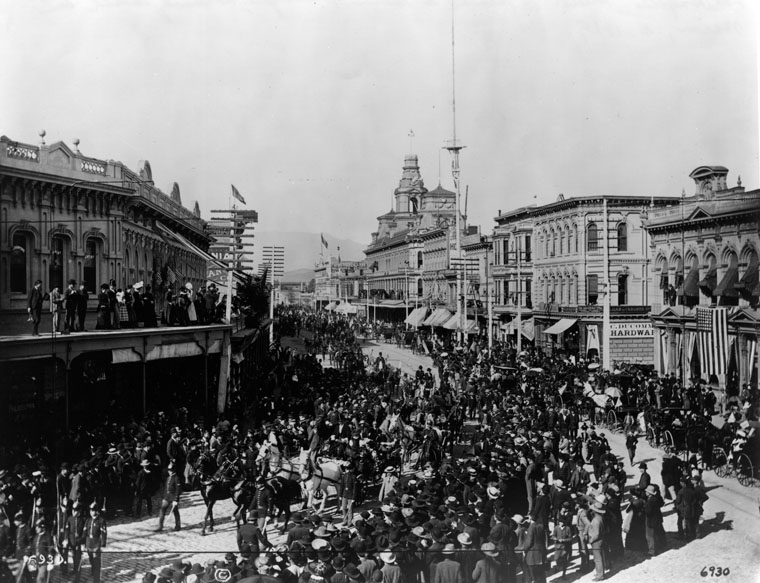 |
|
| (ca. 1889)^ - A parade on Main and Temple streets, looking north. The City's new 150-foot tall electric light pole can be seen in the center of the photo. |
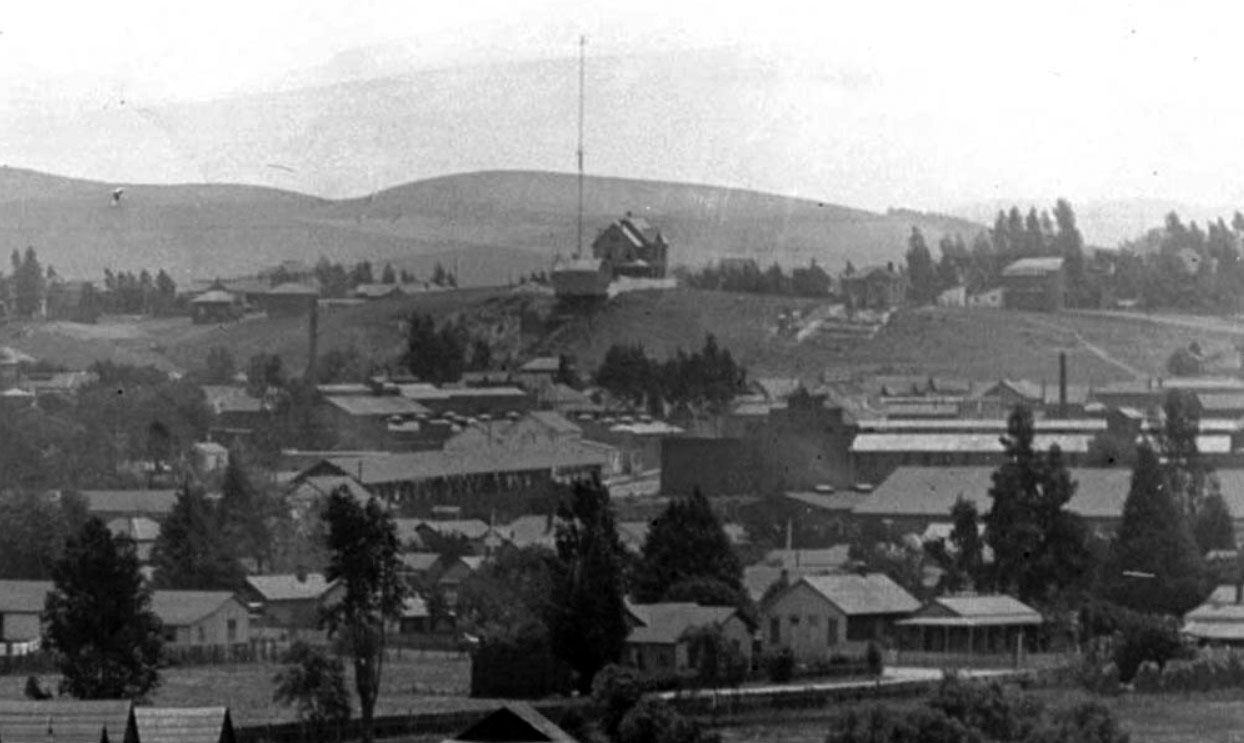 |
|
| (ca. 1890)* – Close-up detail view showing a 150-ft tall streetlight in Boyle Heights. |
Historical Notes On New Year's Eve of 1882, with much less reportage and ceremony, and only twenty-four hours after electric lights were introduced to Los Angeles, the electric light mast at First Street and Boyle Avenue was switched on. There were four other locations in Boyle Heights and East LA. (Using present-day street names) they were Avenue 22 and North Broadway in Lincoln Heights (the area was then called East Los Angeles), First Street and Central Avenue, Fourth Street and Grand Avenue, and Sixth and Main streets. |
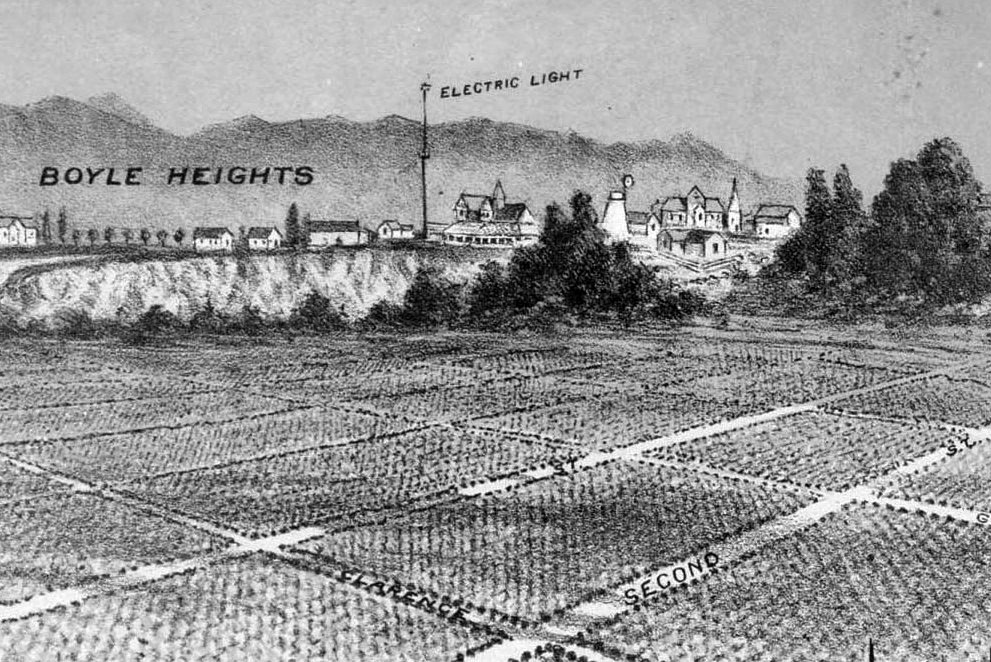 |
|
| (1889)* – Sketch found on a map published in 1889 of the William Workman property and vineyards in Boyle Heights. The “Electric Light” mast is plainly seen and identified on the upper left. |
Historical Notes These maps were generally produced to promote a subdivision, neighborhood or city and prominent features, like the light mast, were given attention as part of selling a well-planned and suitably outfitted area for potential buyers of property and structures. |
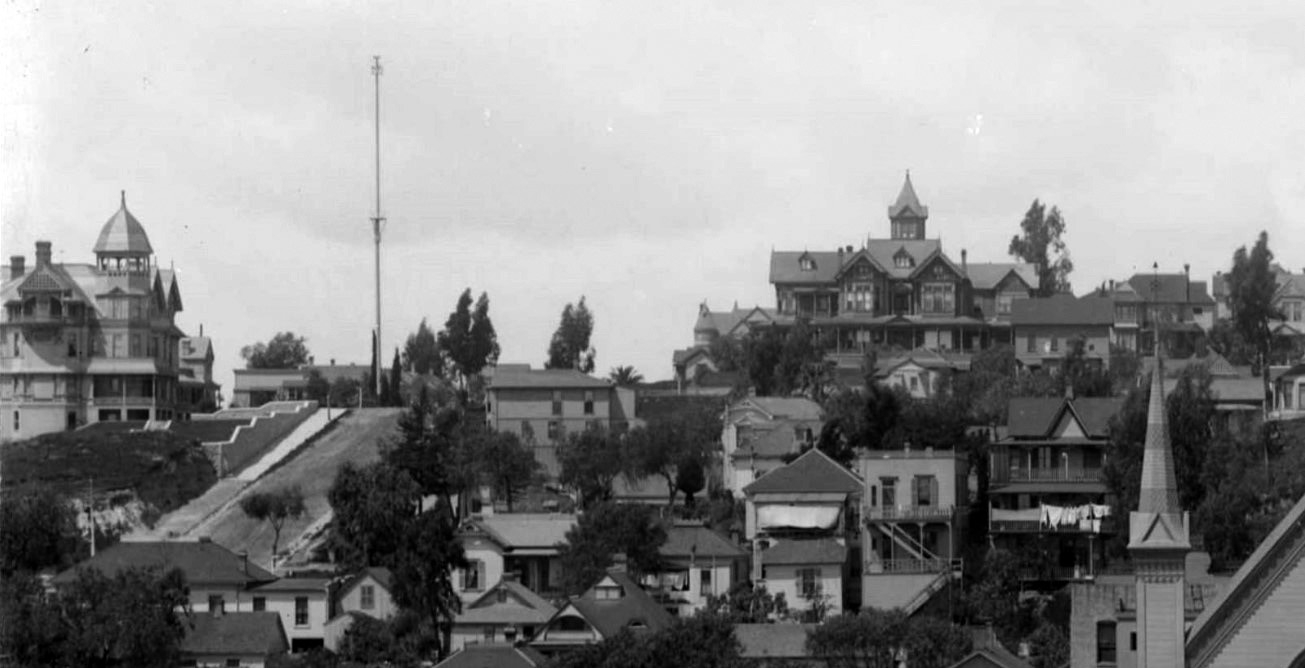 |
|
| (ca. 1890)* – View looking west toward Bunker Hill showing the impressive Brunson Mansion at center-right with the Rose Mansion at far left. Note the 150-ft tall streetlight at center-left. |
 |
|
| (ca. 1892)^ - View showing one of the City's 150-ft tall streetlights in the residential area of Orange Street (later Wilshire Boulevard) at Lucas Avenue. |
Historical Notes By the mid-1880’s there were over 240 of the new electriic 150-ft tall streetlights throughout the city. |
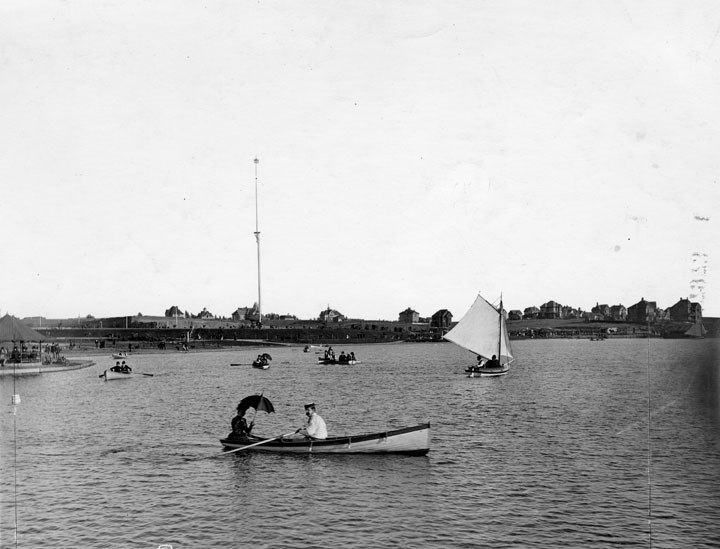 |
|
| (1890s)^ - A sailboat and several row boats are seen on the lake at the City's new park, Westlake Park (now MacArthur Park). The hillside is beginning to be filled with new homes. The very tall pole in the background is one of the City’s new streetlights (150-ft tall). |
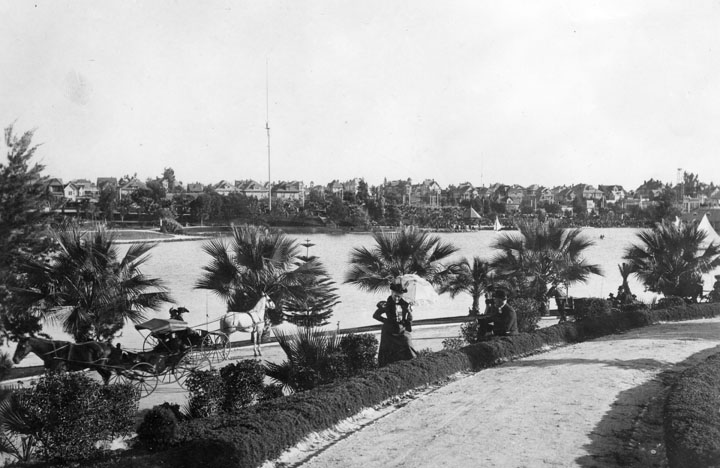 |
|
| (ca. 1895)^ - View of Westlake Park (now MacArthur Park) circa 1895. Transportation was still by horse and carriage (lower left of picture) and ladies carried parasols to shade themselves from the sun. The tall pole seen on the other side of the lake is one of the City's first 150-ft tall electric light poles. |
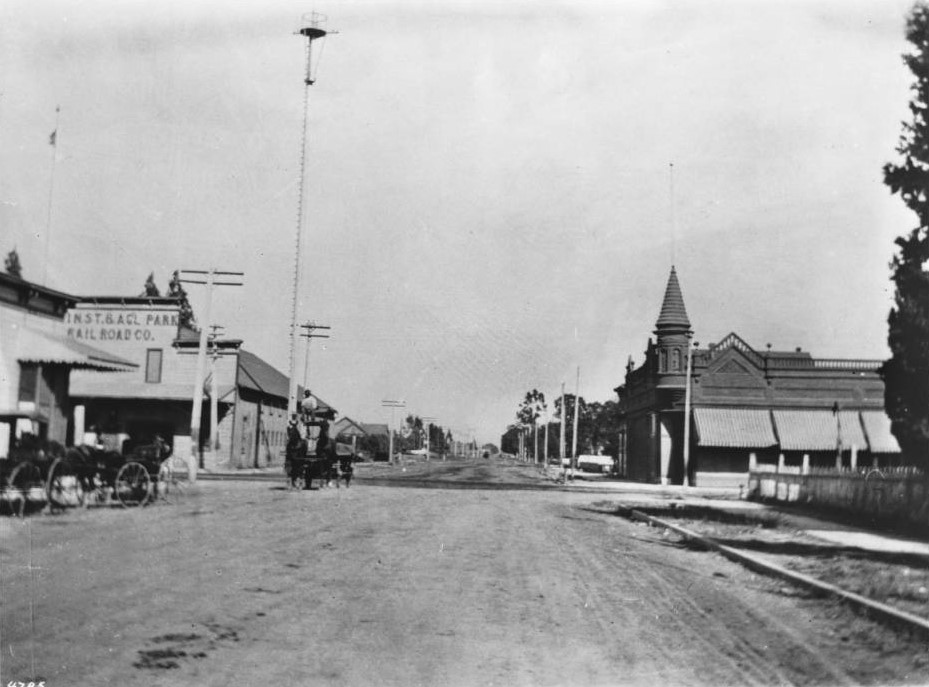 |
|
| (1896)* - View is looking east at Washington Boulevard from Main Street. There are storefronts on both sides of the wide dirt road. Horse-drawn carriages can be seen on the left as well as a very tall white streetlight with a small platform at the top. The platform is actually in the middle of the pole. |
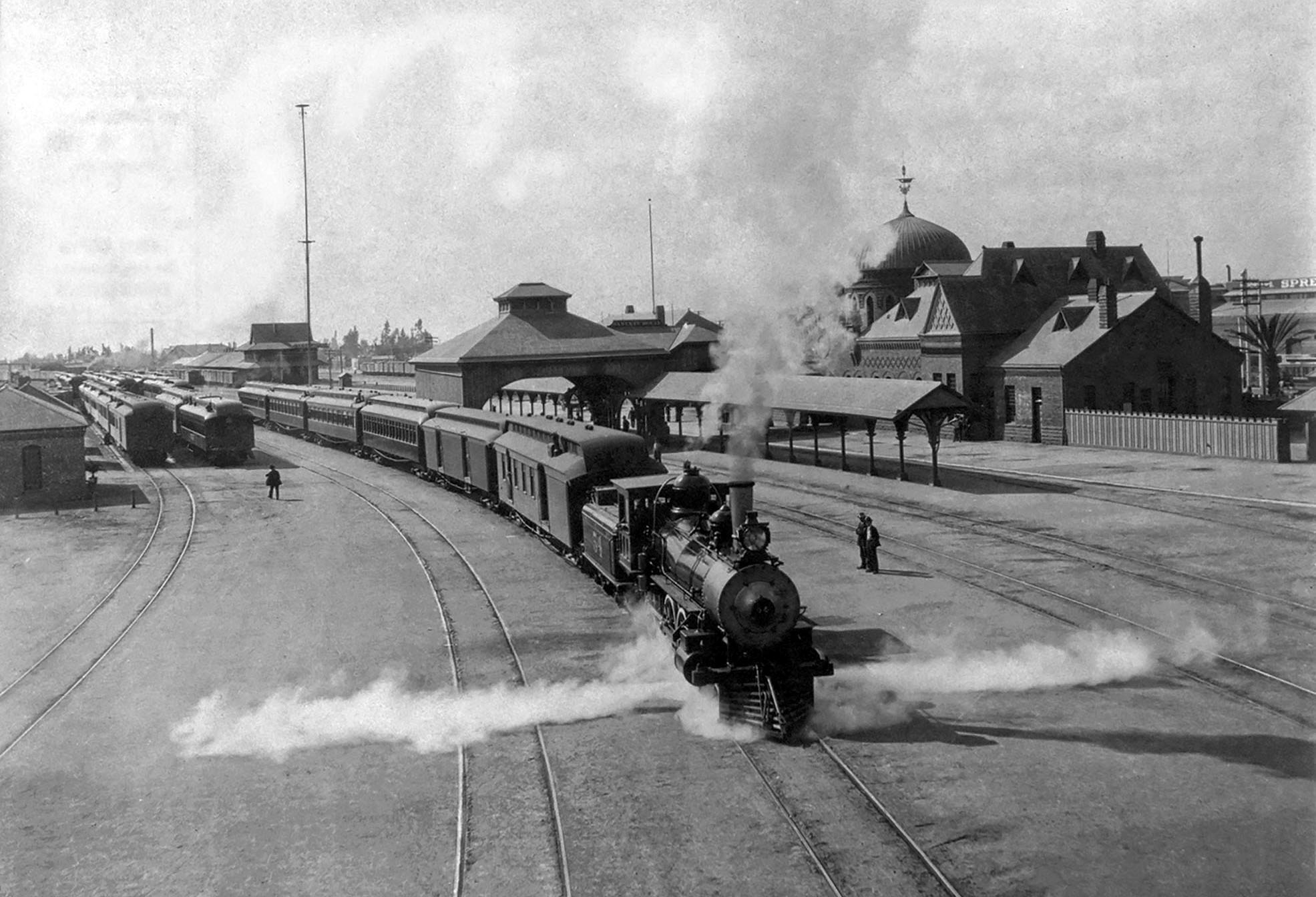 |
|
| (1899)* – Panoramic view showing a train leaving the La Grande Santa Fe Station. Standing tall In the background (center-left) is one Los Angeles’ first 150 ft. streetlights, installed to illuminate the railroad yard. |
Historical Notes Over time, difficulty with maintenance and the undependability with lamps on 150-foot “masts” encouraged engineers to improve lighting technology so more pole locations could be used economically with shorter poles and less energy requirements. |
Then and Now
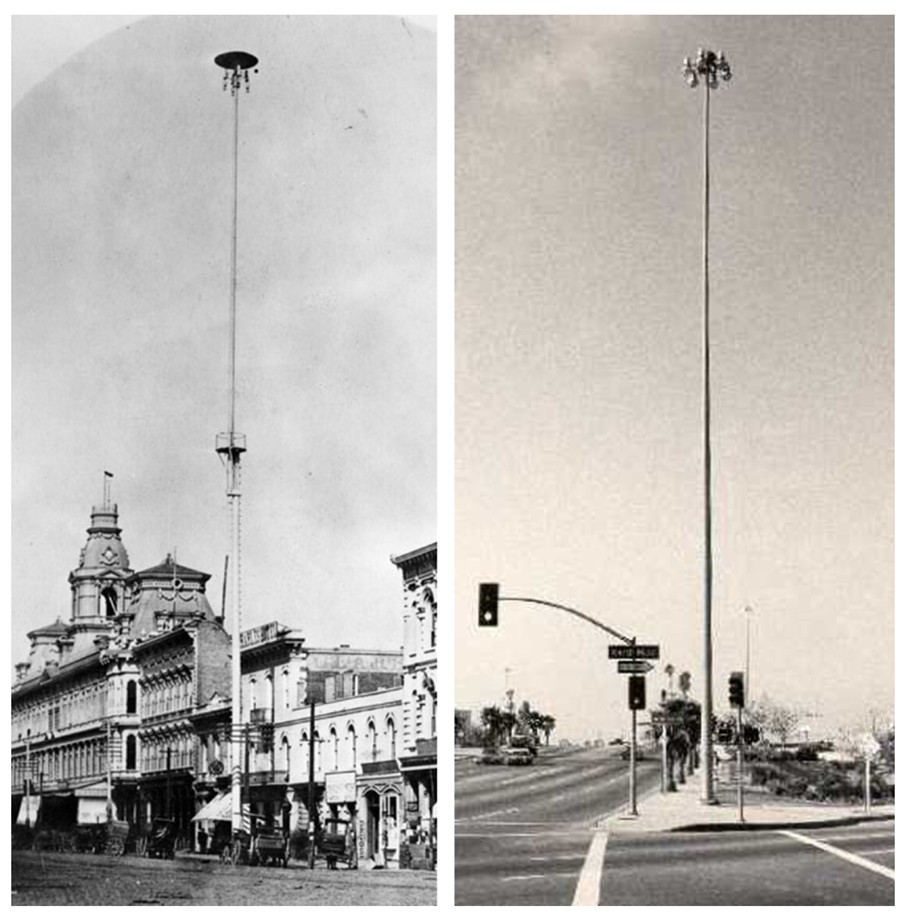 |
|
| (1882 vs. 2000)* – A ‘Then and Now’ comparison of Los Angeles' first electric streetlight, installed on the 300 block of North Main Street in early downtown Los Angeles, juxtaposed with a contemporary streetlight at the northeast corner of Valley Circle Boulevard and Avenue San Luis in Woodland Hills. In a way, we've come full circle with these towering lights—though the original stood at 150 feet, today's version reaches only 100 feet, 27 miles away. Photo comparison by Jack Feldman |
* * * * * |
LA's First Electric Light Power Plant
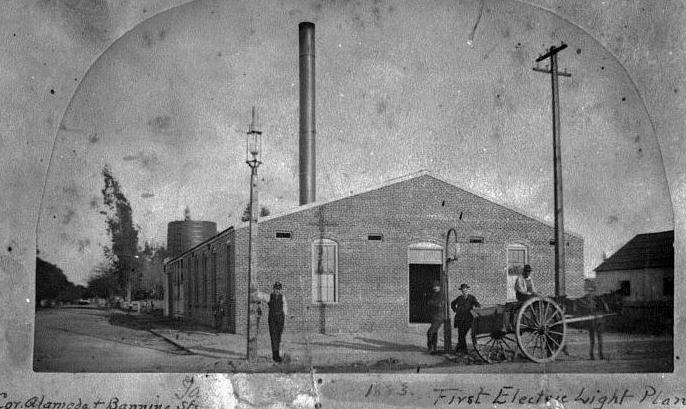 |
|
| (1883)* - The first electric light plant in Los Angeles was built in 1882 by C. L. Howland (Los Angeles Electric Company) on the corner of Alameda and Banning Streets. |
Article from LADWP's Historic Archives “Los Angeles City is famed not only for its climate and for its oranges, but its electric light comes in as its crowning glory . . . "
|
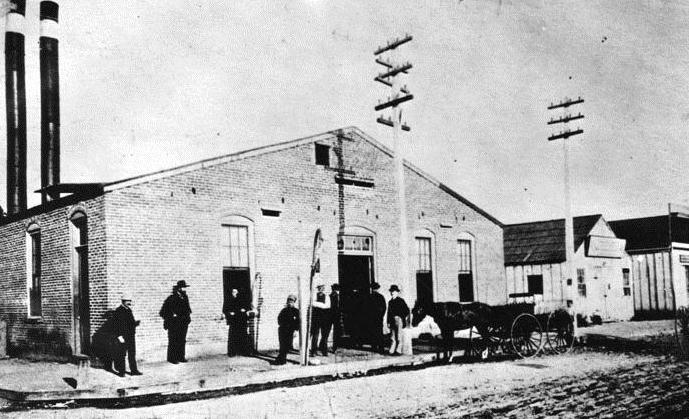 |
|
| (1888)* - Banning Street Electrical Plant now showing two smokestacks. It appears that the building as been enlarged from its original footprint as seen in the previous 1883 photo. Click HERE to see more in Early Power Generation in Los Angeles. |
* * * * * |
Early Utilitarian Streetlights
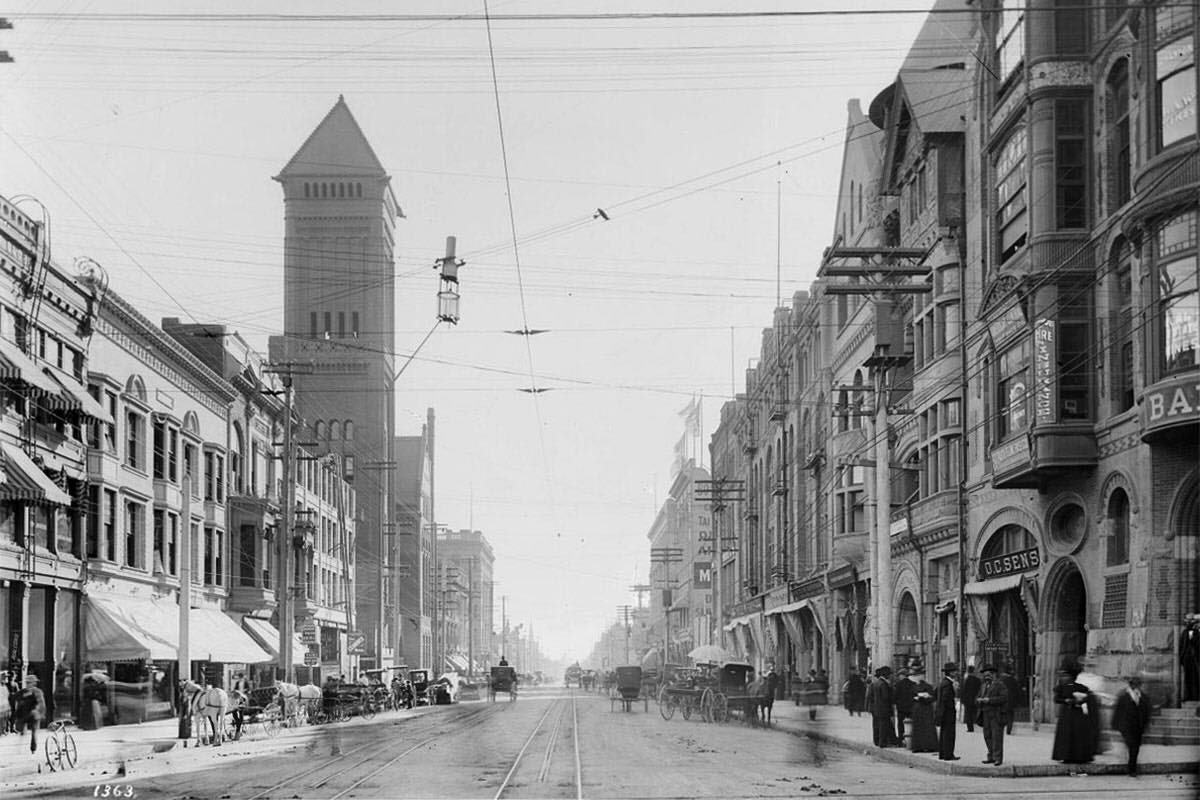 |
|
| (ca. 1904)* - Broadway looking south from Second Street. A double carbon arc lamp utilitarian streetlight is hanging from wire in the center of the intersection. The tall tower in the distance is the 1888-built City Hall. It would stand there until today's City Hall was built in 1928. |
Historical Notes "Utilitarian" Streetlights are lamps attached to an overhead wire or to a power pole. |
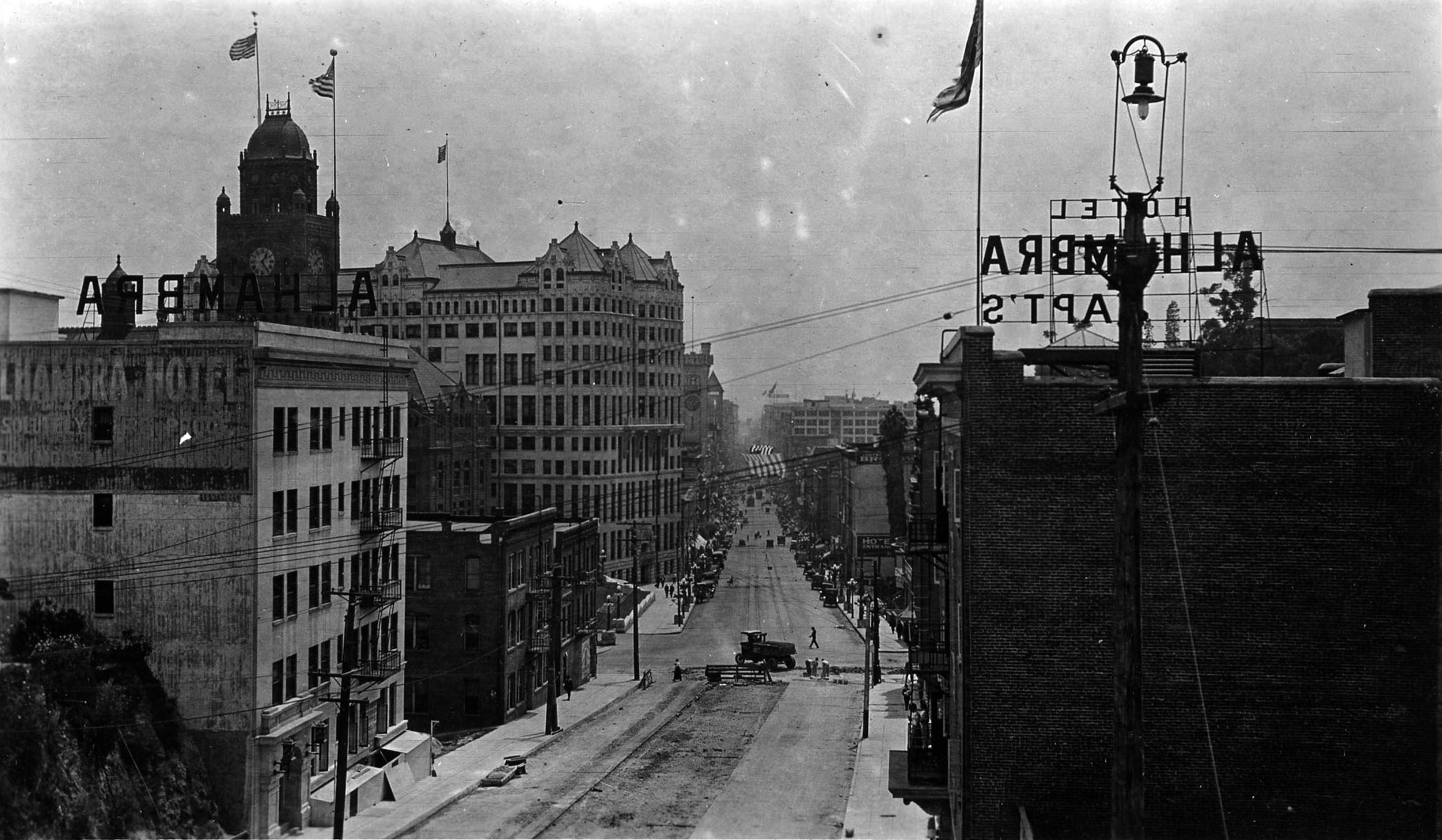 |
|
| (1920s)* – View looking south on Broadway from the top of the Broadway Tunnel toward Temple Street. The LA County Courthouse, Hall of Records, LA Times Building, and City Hall (built in 1888) can all be seen in the background on the east side Broadway. The Alhambra Hotel is in the left foreground and the Hotel Alhambra & Apartments Annex is across the street on the right. In front of the Annex can be seen a very tall power pole with a utilitarian streetlight mounted on top of it. |
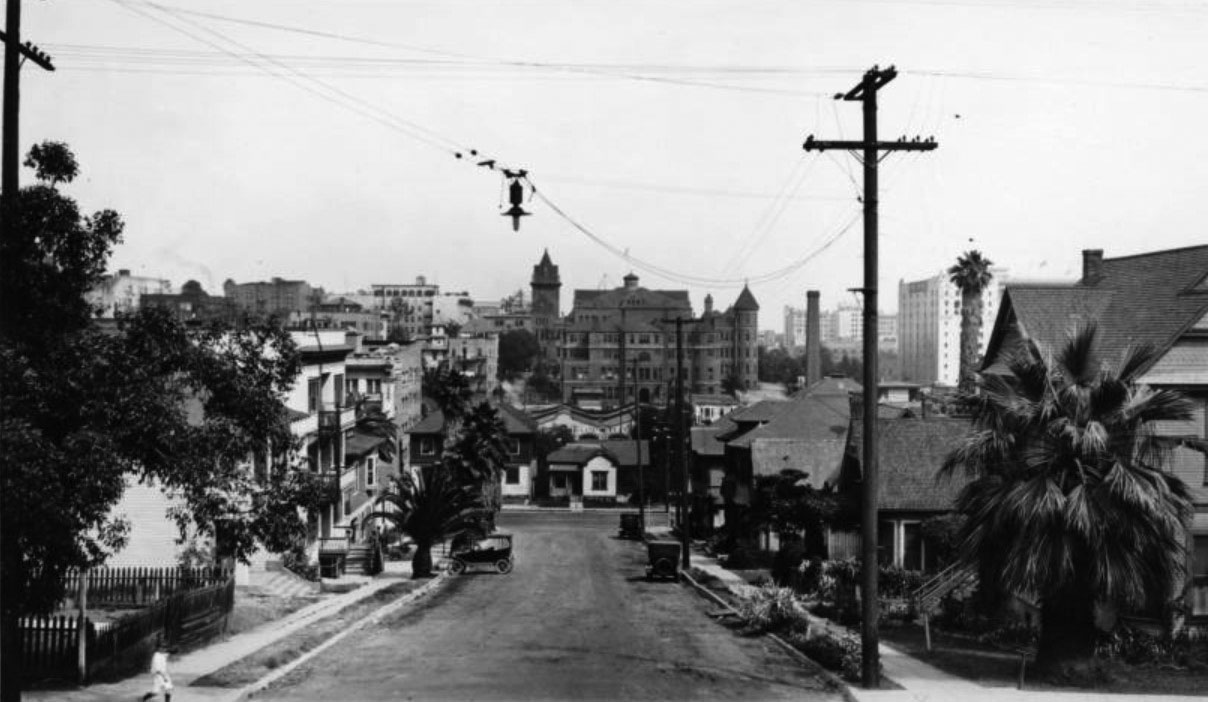 |
|
| (1922)* - Utilitarian streetlight hanging from wire that straddles 5th Street. View is looking east on 5th Street toward Figueroa Street. |
Historical Notes Top photo shows the State Normal School sitting atop the last knoll of Bunker Hill, aptly dubbed "Normal Hill." In the mid-1920s the school would be demolished, Normal Hill would be leveled, 5th street would be extented through to Grand Avenue, and the LA Central Library would be constructed where the old school once stood. |
 |
|
| (ca. 1920s)* - Early LA residential street light installation. Note the Utilitarian streetlights. |
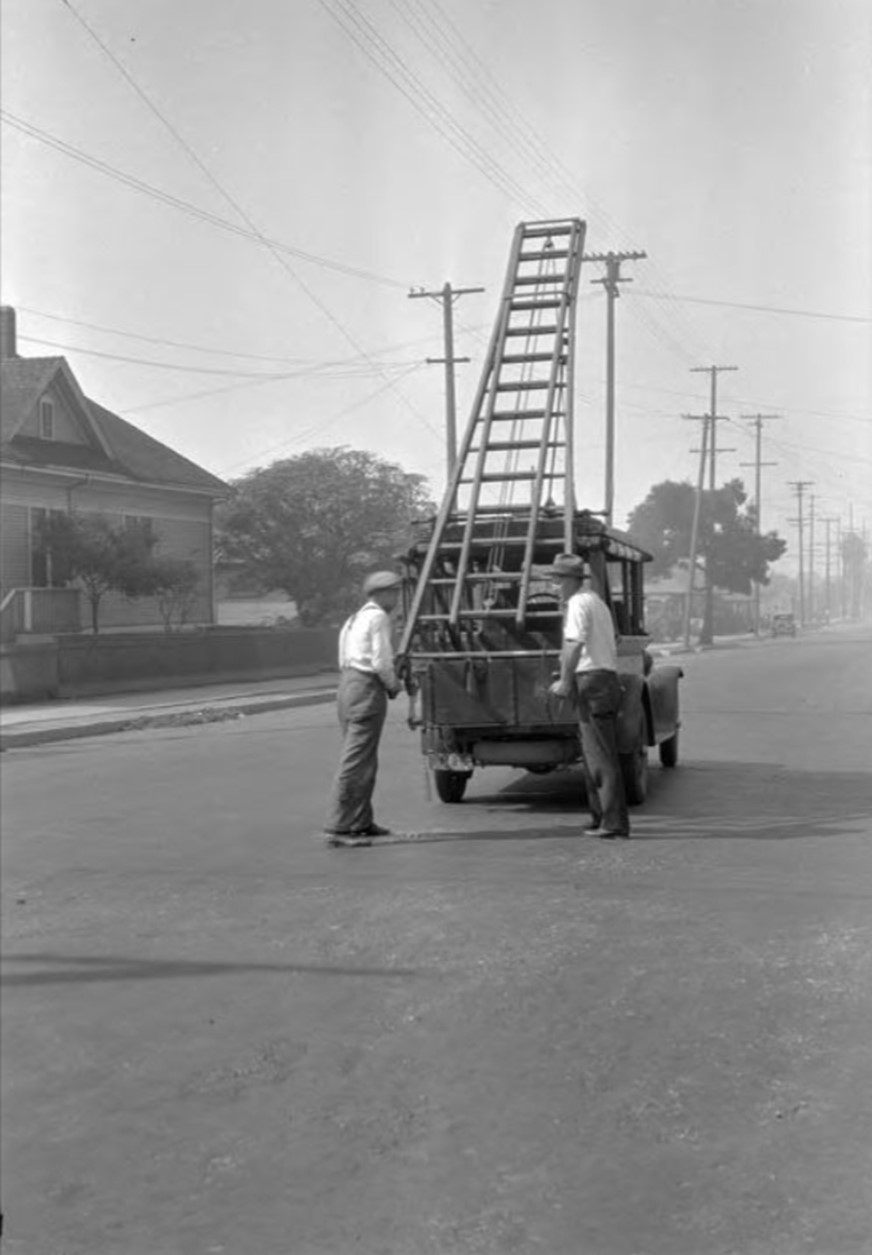 |
|
| (1920)* – A Buarau of Power and Light crew preparing to replace an overhead streetlight lamp (‘Utilitarian’ streetlight). |
Historical Notes "Utilitarian" Streetlights are lamps attached to an overhead wire or to a power pole. |
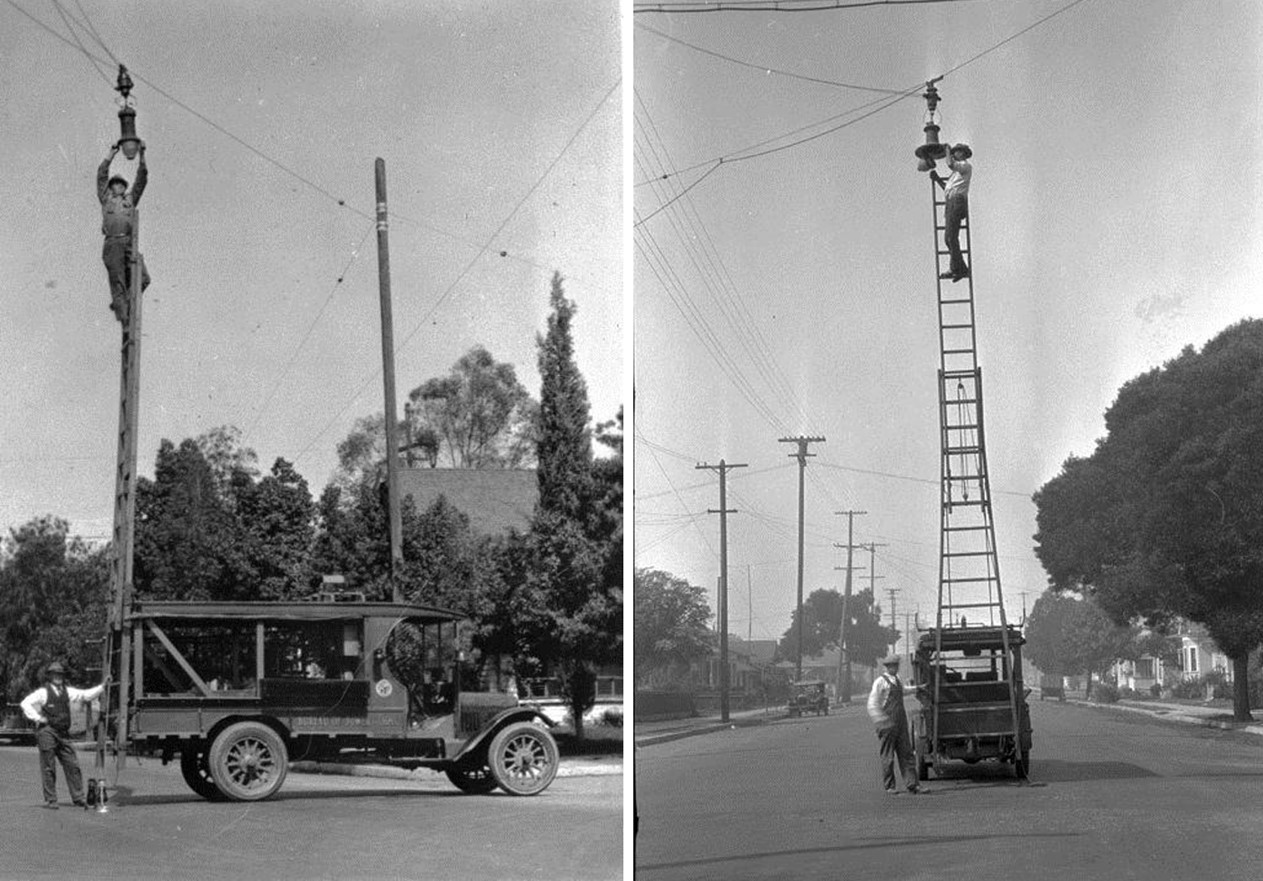 |
|
| (1920s)* - A Bureau of Power and Light worker changing out a hanging lamp in the middle of an intersection. |
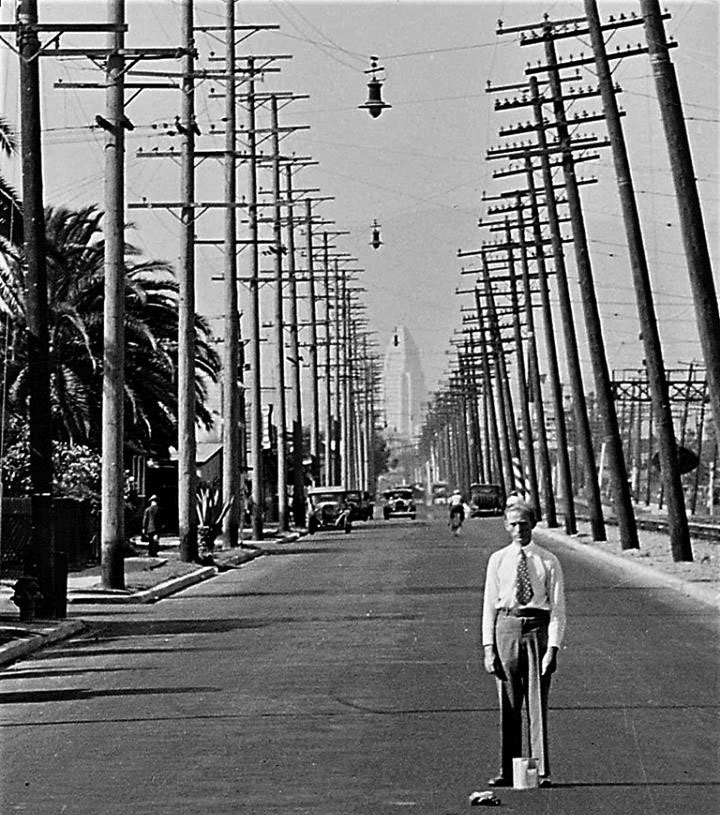 |
|
| (1929)* – View looking north on Long Beach Ave at 42nd Street, showing a very serious looking man standing in the middle of the road. Overhead lines run up and down both sides of the street (power lines on the left and telephone lines on the right). Overhead utilitarian streetlights straddle the street between the lines. Railroad tracks are on the right and City Hall (built in 1928) can be seen in the distance. Click HERE to see contemporary view. |
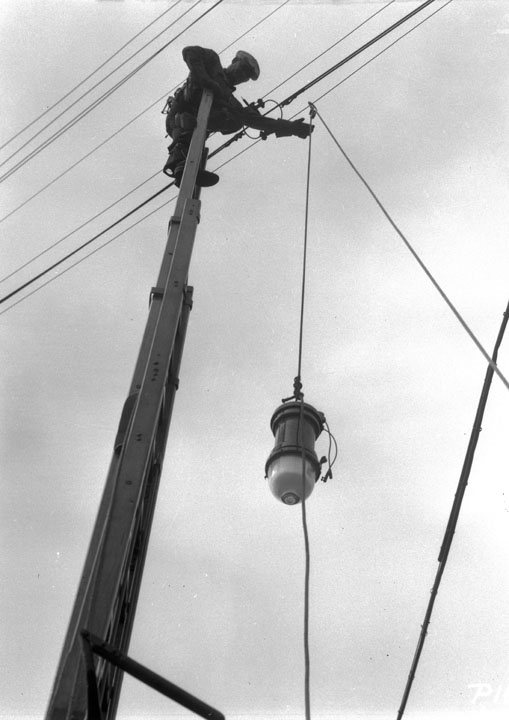 |
(Early 1930s)* - New street light being pulled up for installation.
|
|
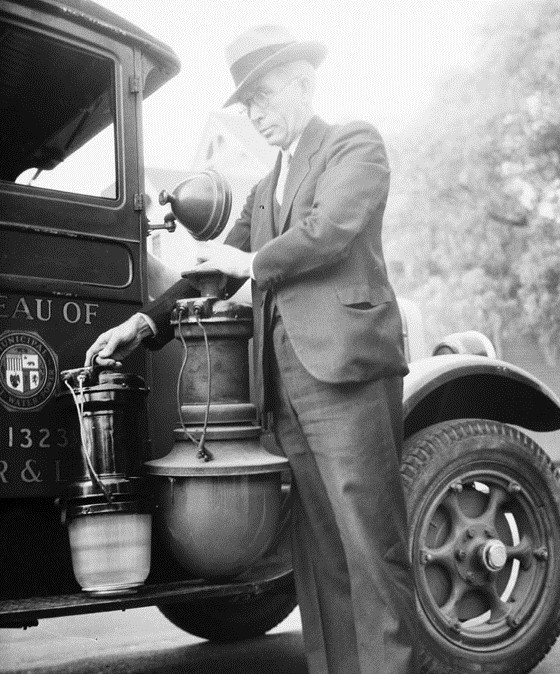 |
(1933)* - L. G. Gould with a new and an old incandescent lamp at 30th and Trinity Streets.
|
Historical Notes This marked the close of another era in the development of Los Angeles. The last arc light in the City was removed November, 1933 by L. G. Gould's street lighting section and replaced with a modern incandescent lamp.* |
 |
|
| (1928)* – View showing a "Utilitarian" Streetlight attached to a wooden pole located at the apex of the intersection of Beverly Boulevard and N. Virgil Avenue. On the right is Jake's Market Fountain Cafe. Across Beverly on the left is the American Storage Building . Barkies Sandwich Shop can be seen in the background where Beverly intersects with Temple Street. |
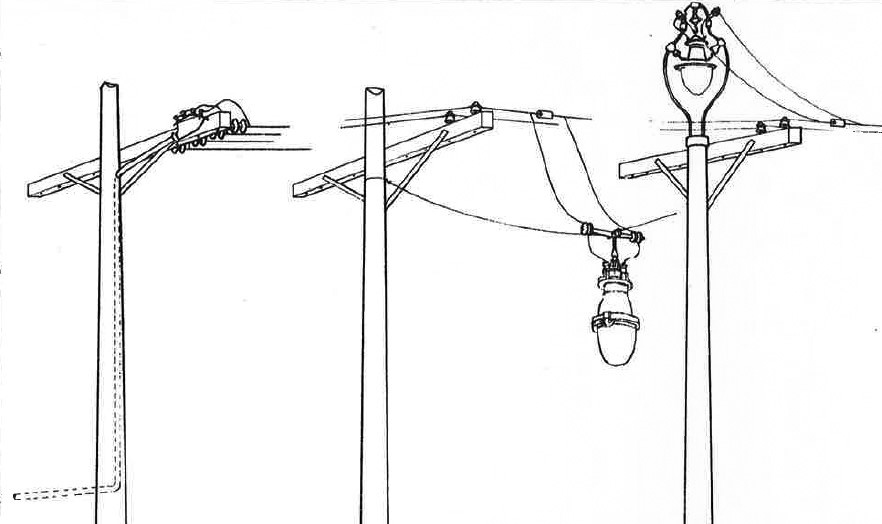 |
|
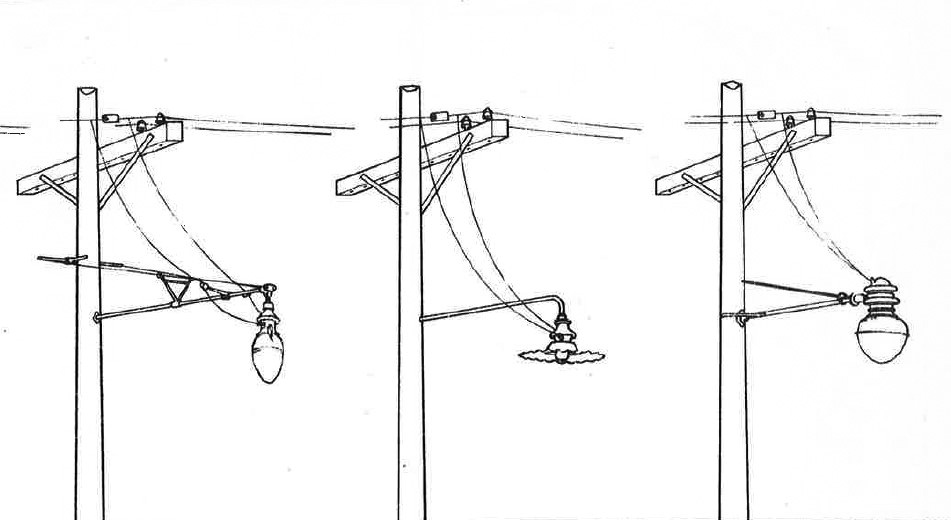 |
|
| (1947)* - Sketch showing a variety of Utilitarian Streetlights as seen in a DWP Streetlight Manual issued in 1947. |
Historical Notes Early Utilitarian Streetlights were served through two types of circuits - multiple and series. The multiple circuits are the same as ordinarily used in house lighting and employ a constant voltage of 120 volts, two wire or 120/240 volts, three wire. In the series circuits, the lamps were connected in series and the same current passed through all lamps. The current was maintained at a constant value and each circuit was individually regulated by a constant current regulating transformer. The voltage of the circuit at the supply point was equal to the sum of the voltages across each lamp pluse the line drop. Utiltarian Lights still exist today, however, they are all served by 120/240 volts wire. Click HERE to see the 1947 DWP Streetlight Manual. |
* * * * * |
Early Streetlight Electroliers
Streetlight "Electroliers" are defined as free-standing streetlights generally on their own posts. The second period of street lighting in Los Angeles took off in the early 1900 and lasted until just before the Second World War. During this period street lighting used vertically mounted incandescent lamps (electroliers) which were relatively low in height, placed close together, and often highly ornamental. |
Broadway - 7-Globe Electrolier
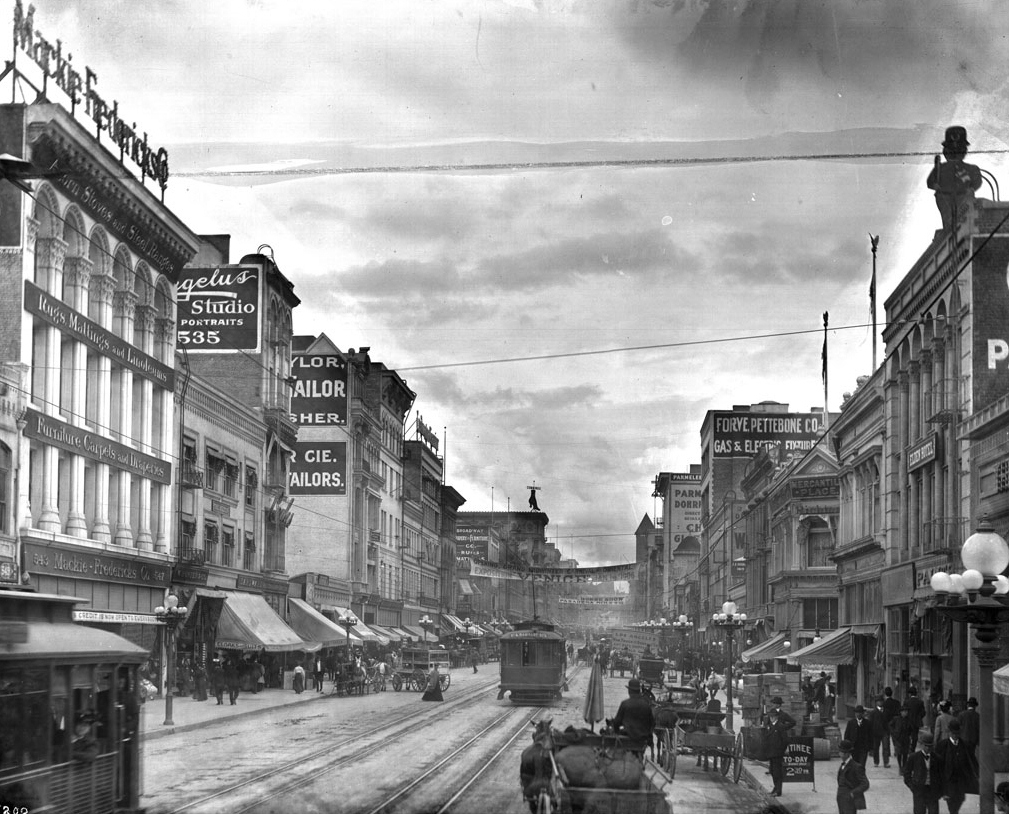 |
|
| (ca. 1905)* - View of Broadway looking north from Sixth Street. The 7-lamp ornate streetlights that ran along the sidewalk curb consisted of a large round bulb surrounded by six smaller ones. |
Historical Notes In May 1905, the first ornamental post system in the city was introduced on Broadway between First and Main Streets. This installation consisted of 135 posts each equipped with six small glass globes, enclosing 16 candle-power amp, and one large glass globe, enclosing a 32 candle-power lamp. This system operated until 1919 when it was demolished to make way for a more modern system. |
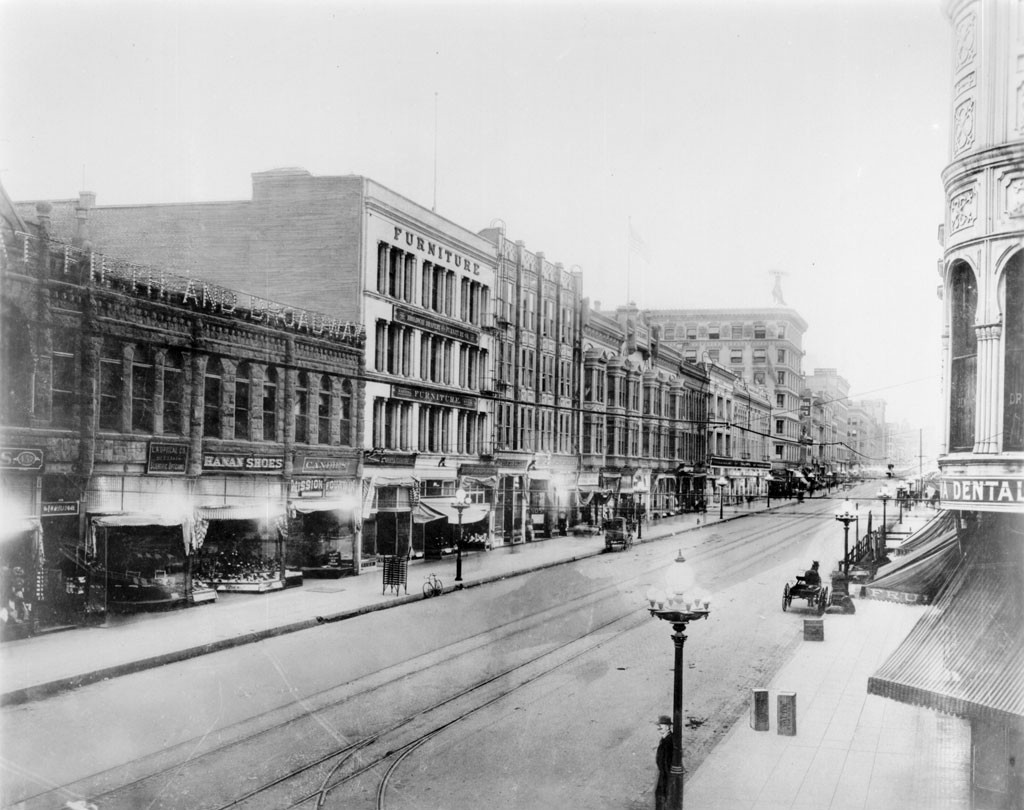 |
|
| (1907)* - View looking north on Broadway near 5th Street at dusk or dawn. Beautiful 7-lamp streetlights are illuminating the nearly vacant street. |
Historical Notes Even with multiple lamps, the light given off from these new Electroliers was not great. Most had a single large globe that gave off 32‐candle power, and two to six smaller globes that each produced 16 candlepower. This was in contrast to the 3000 candle power of the Brush arc lights. Therefore, electroliers had to be placed relatively close together. Nor could they be tall.* |
 |
|
 |
|
| (1909)* - Source: The City Beautiful aka Report of the Municipal Art Commission for the City of Los Angeles. |
Historical Notes Supplying these lamps to Los Angeles was the Llewellyn Iron Works. The company fabricated a variety of electrolier configurations featuring a single large globe and two to six smaller globes. All followed the classical treatment of a heavier base and a more slender shaft. All the globes were spherical, but the seven‐lamp form could be provided with a finial atop the large globe. |
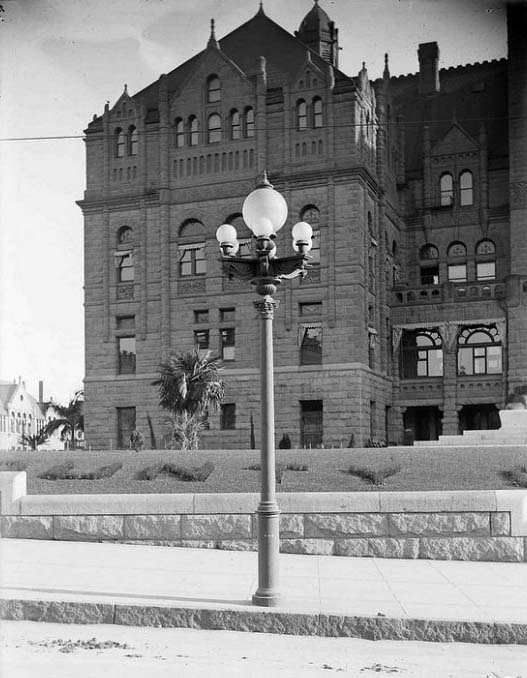 |
|
| (1910)* - A 7-bulb decorative streetlight with finial atop the large globe stands in front of the LA County Courthouse located at Broadway at Temple Street. |
Historical Notes The popularity of the electrolier soon spread to other Downtown streets. Within a year Hill, Main and Spring Streets had installed Llewellyn fixtures. They were typically five‐globe rather than seven, allowing Broadway to maintain its image as the brightest of the Great White Ways. Eventually other Downtown and neighborhood commercial districts gained Llewellyns. |
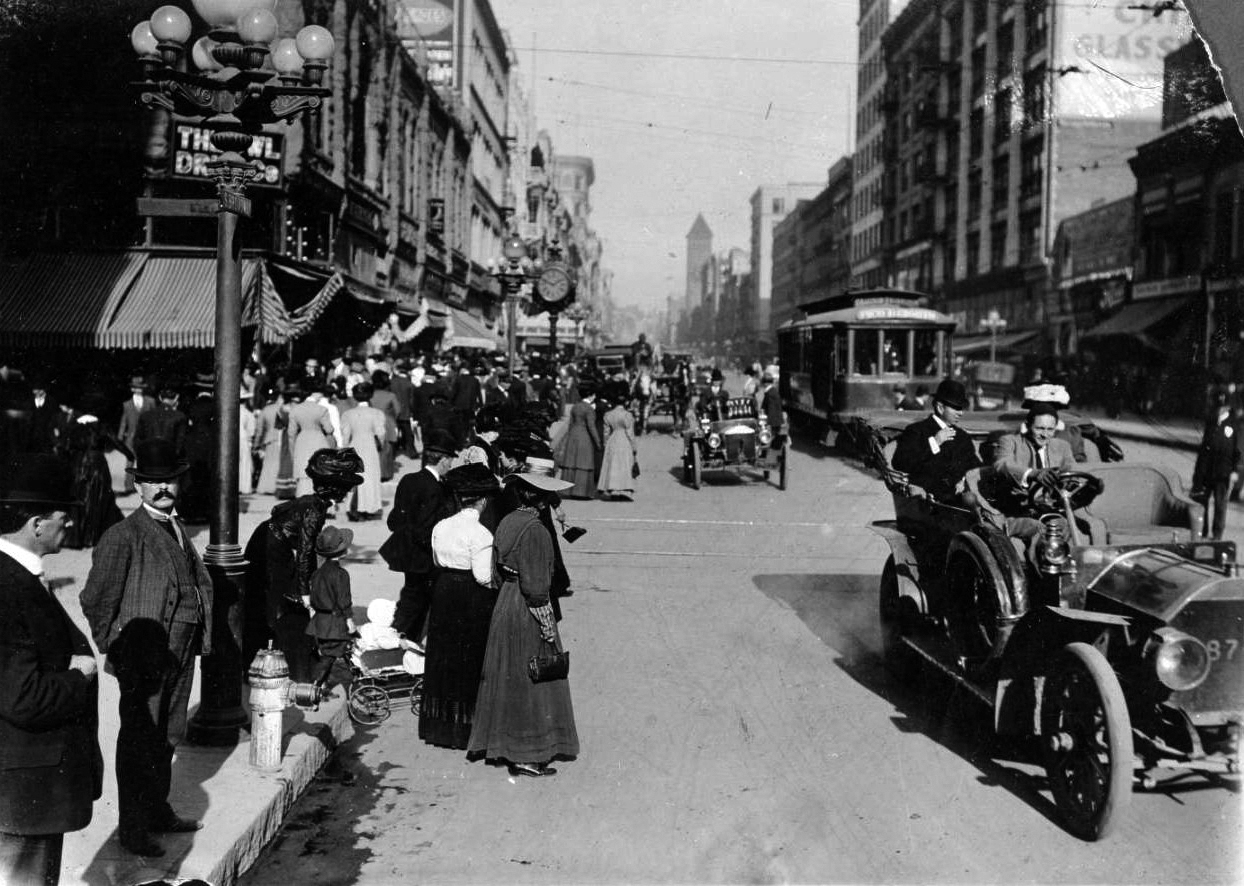 |
|
| (ca. 1908)* – Looking north on Broadway at 5th Street, the busy street is shared by cars, streetcars, and even a horse-drawn wagon, while pedestrians fill the sidewalks. There's a lot to take in here: the beautiful 7-bulb decorative streetlights lining both sides of the street helped maintain Broadway as the brightest thoroughfare in downtown. The tall tower in the distance was L.A.’s City Hall from 1888 to 1928. Also note the steering wheel on the car in the foreground is on the right-hand side—typical of early automobiles before Ford’s Model T popularized left-hand drive. |
Historical Notes Financed by the Broadway Boulevard Improvement Association, 135 cast-iron electroliers were installed from First Street to Main Street in 1905. Each featured a cluster of six smaller globes topped by a larger one, creating a distinctive design that earned Broadway the nickname "the Great White Way". The Llewellyn Iron Works fabricated these ornate fixtures, which became a hallmark of early 20th-century Los Angeles. |
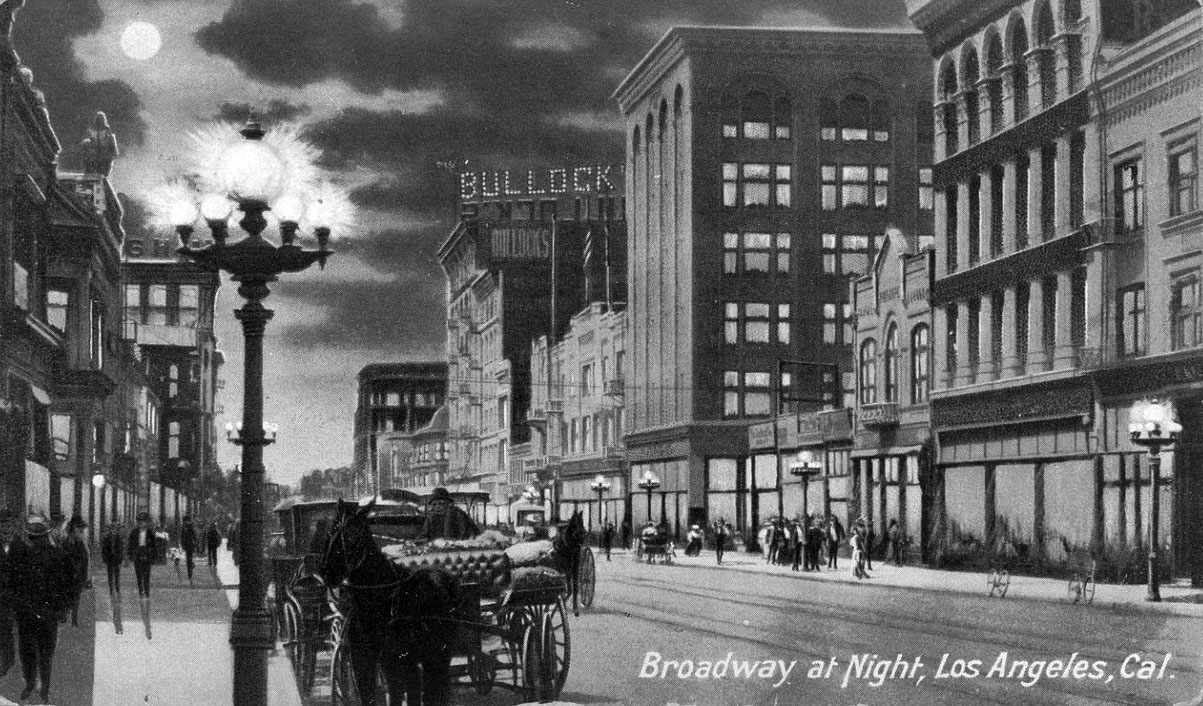 |
|
| (ca. 1908)*– Postcard view looking south on Broadway at night with the Bullock's Department Store building in the background. An ornate 7-bulb lamp stands tall in the foreground adjacent to a horse-drawn wagon. |
Historical Notes The seven-globe electroliers were notably brighter than residential three-globe variants, solidifying Broadway as the city's most illuminated street. Their design influenced later installations on Hill, Main, and Spring Streets, though these used five-globe clusters to maintain Broadway's prominence. The lights were initially powered by private business associations, with municipal power not arriving until 1916. |
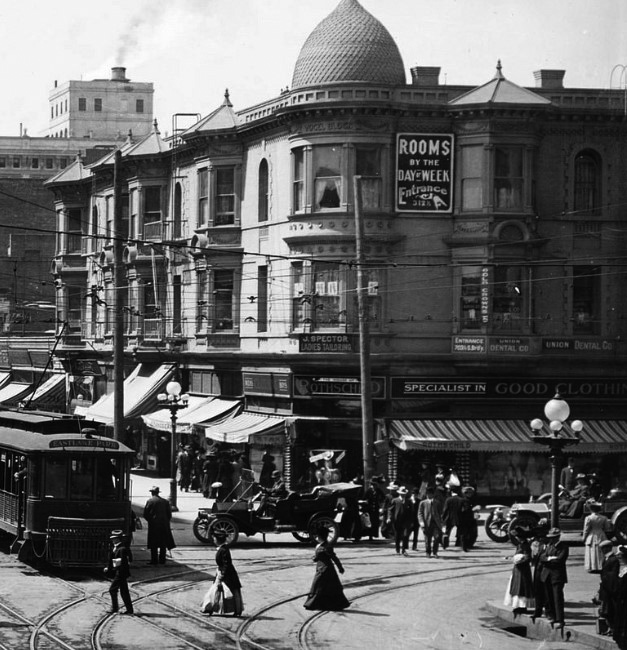 |
|
| (1910)* - View looking at the southwest corner of Broadway and 7th Street showing two ornate 7-bulb lamps on the corners with the Vogel Building and its onion-shaped tower in the background. |
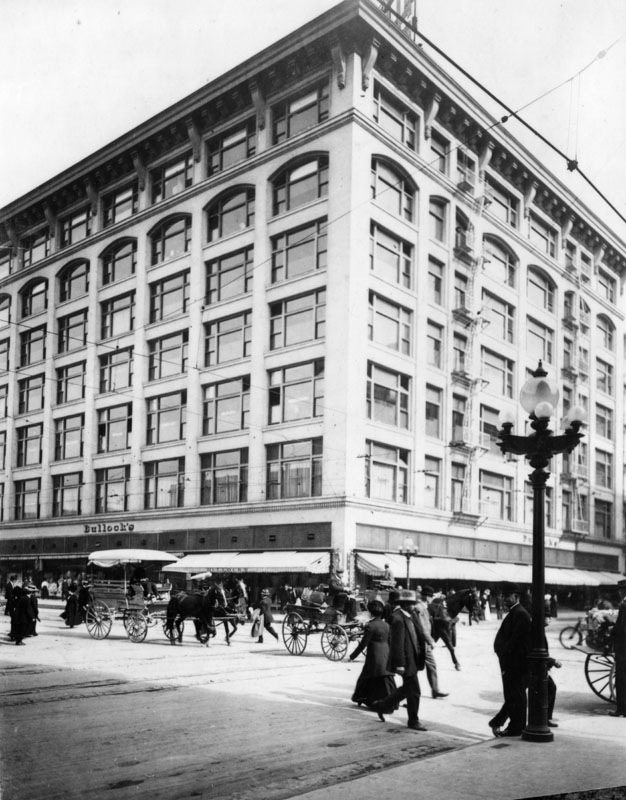 |
|
| (1910)^ - At right, a man stands under a multi-bulb electrolier located on the southeast corner of Broadway and 7th Street. Horse-drawn carriages and pedestrians share the road at the intersection and Bullock's Department Store can be seen across the street. |
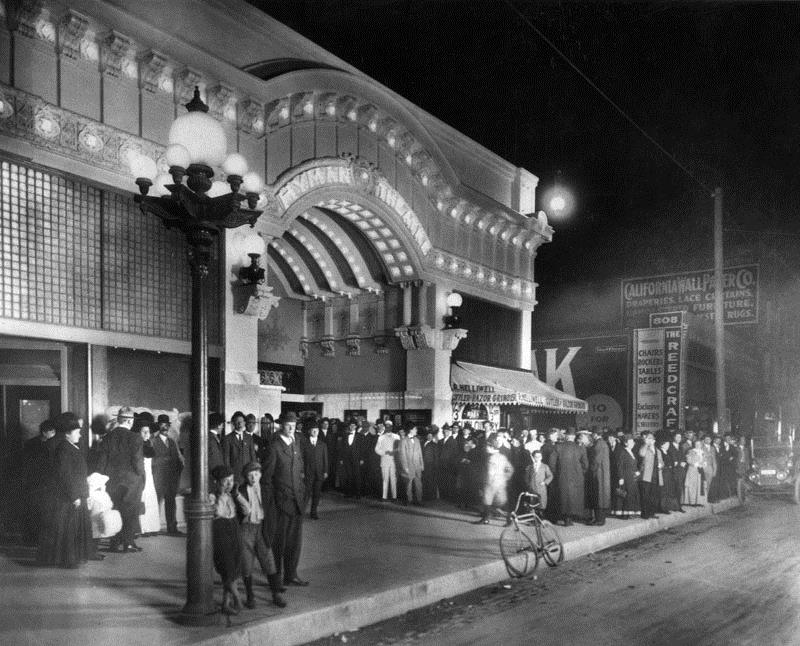 |
|
| (1910)^ - An evening crowd gathers under the marquee of the Hyman Theatre at 802 S. Broadway, on the southwest corner of 8th and Broadway. Two boys stand under an ornate 7-bulb streetlight, one leaning on it. |
 |
|
| (1915)*– 7-bulb electroliers light up both sides of the 800 block of Broadway in front of Tally's Theatre. |
* * * * * |
Five-Globe 'Winslow' Llewellyn Electrolier
 |
|
| (ca. 1910)* - Looking west from 5th and Hill streets. Ornate 5-bulb Llewellyn 'Winslow' Electroliers appear as far as the eye can see. The trees of Pershing Square are visible on the left, and the State Normal School, on the present site of the L.A. Public Library, Central Branch shows prominently in the background. The building to the right is the California Club. |
Historical Notes Five-globe streetlights (called Llewellyn Electroliers) were originally installed on most streets in Downtown Los Angeles in the early 1900s, (except for Broadway which had the seven-globe lights). This particularly ornate model ("Winslow") seemed to be limited to Hill Street and the streets adjacent to Pershing Square: the one block segments of 5th, Olive, and 6th. Today, the last of these poles are still being used as architectural features in the gardens and malls adjacent to City Hall. |
.jpg) |
|
| (1908)* - Close-up view of the northwest corner of Hill and 5th (same as previous photos), showing the ornate 5-globe corner streetlight in greater detail. This particular Llewellyn streetlight was called the 'Winslow'. |
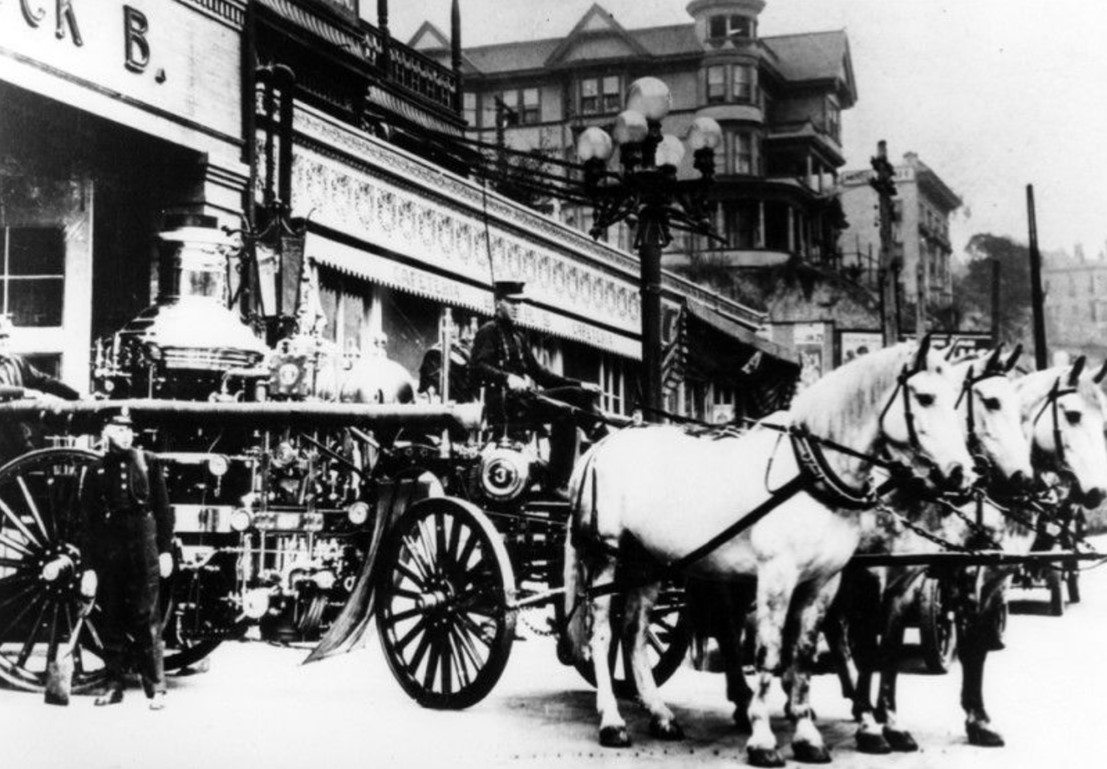 |
|
| (ca. 1910)* – A 5-globe 'Winslow' Llewellyn electrolier stands in front of Los Angeles Fire Department's Engine Co. No. 3 on the west side of Hill Street, just south of 2nd Street. A three-horse-drawn steam pumper stands in front of the station. In the background, the Victorian-style Locke Hotel & Annex sits atop the hill at the northwest corner of 2nd and Hill Streets. |
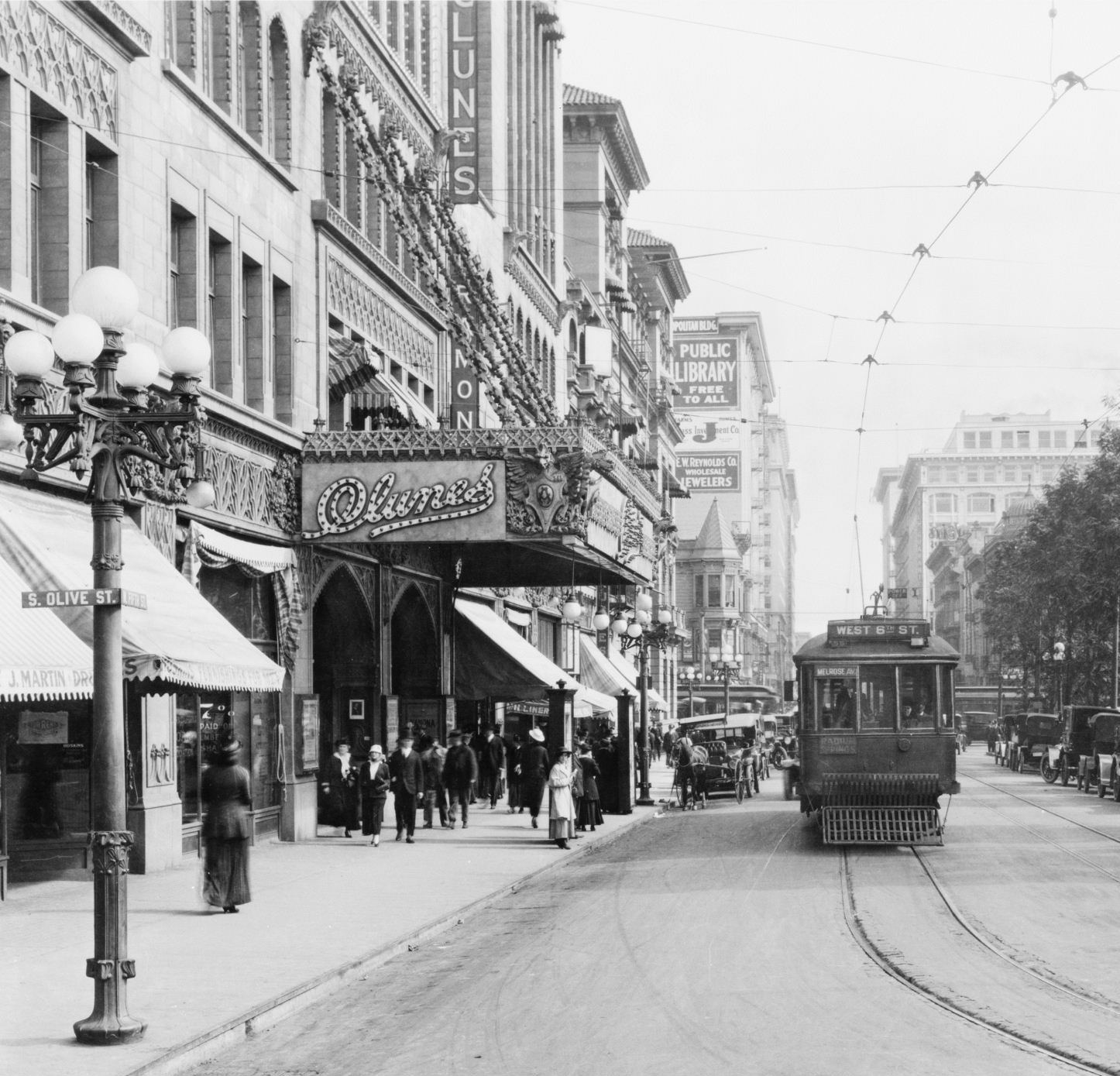 |
|
| (1914)* - A beautiful Llewellyn 'Winslow' 5-bulb electrolier stands on the corner of 5th and Olive streets. The Clune's Auditorium is seen on the north side of 5th Street across from Pershing Square. A horse-drawn carriage is seen parked by the curb while a streetcar is in the middle of the road. |
Historical Notes Click HERE to see more 5-globe Llewellyn 'Winslow' Electroliers |
* * * * * |
Five-Globe Standard Llewellyn Electroliers
.jpg) |
|
| (1905)* – View looking North on Main Street from Fifth Street showing Five Globe Standard Llewellyn streetlights lining both sides of the street. The building with the turret on the right is the Main Street Savings Building, NE corner of Main and Winston streets. In the left foreground is an electric streetcar heading toward the Arcade Depot. |
Historical Notes The most common of the incandescent multiple globe electroliers of the early 1900s were those manufactured by the Llewellyn Iron Works of Los Angeles. The firm became so identified with this style of street light that any multiple globe electrolier became commonly known as a Llewellyn. The Llewellyn Iron Works, founded in 1889‐1890, was one of the largest metal working facilities in Los Angeles. |
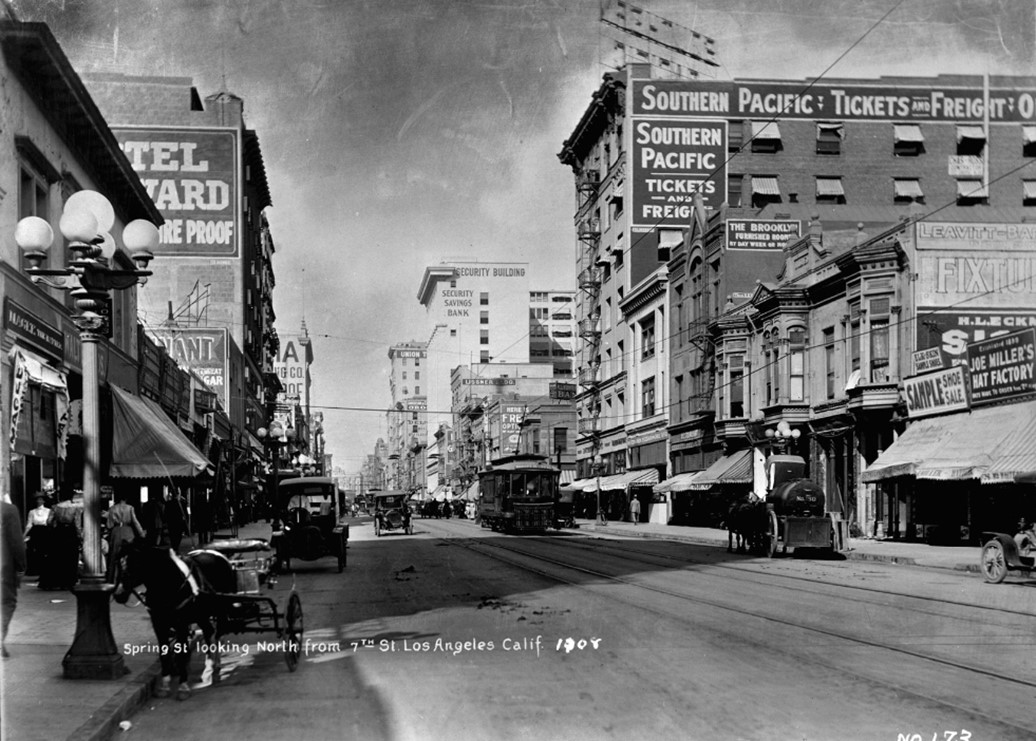 |
|
| (1908)* - Spring Street looking north from 7th Street. Note the horse-drawn wagon parked at the curb under the ornate 5-bulb streetlight. |
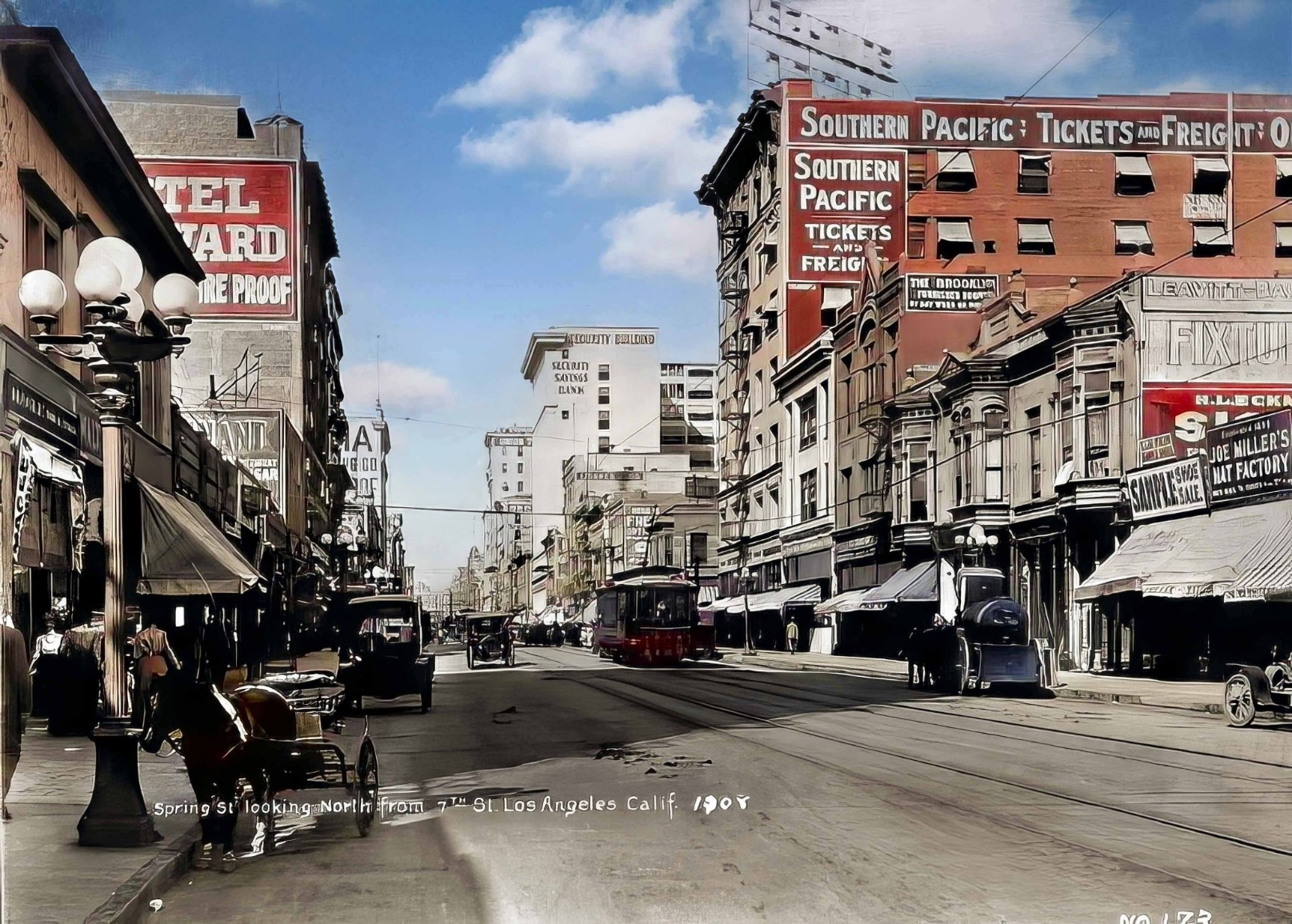 |
|
| (1908)* - Spring Street looking north from 7th Street. Note the horse-drawn wagon parked at the curb under an ornate 5-globe streetlight. Image enhancement and colorization by Richard Holoff. |
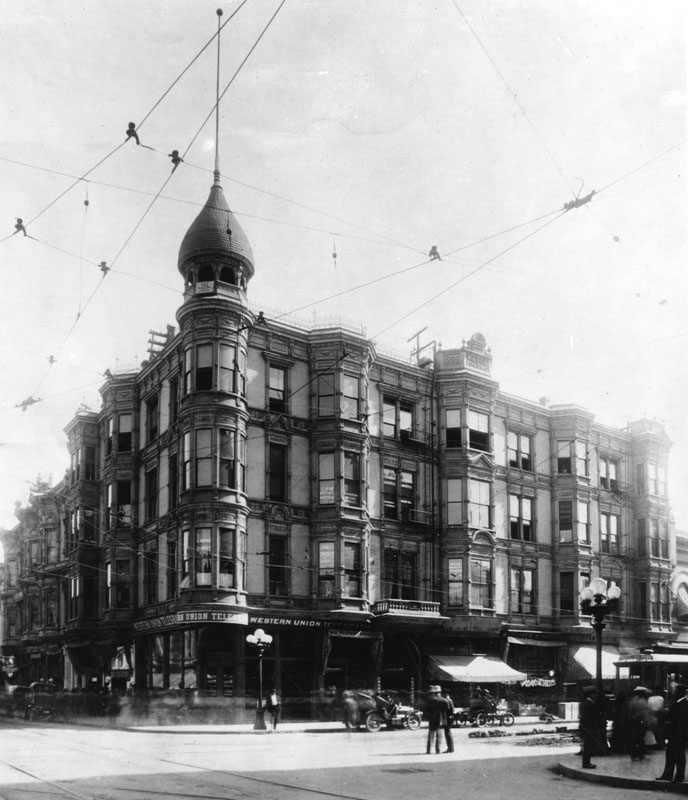 |
|
| (ca. 1910)^ - View showing two ornate 5-bulb streetlamps standing on the corners at the intersection of First and Spring streets. The Wilson Building with its copula is seen on the southeast corner. |
 |
|
| (1919)^ - View showing a multi-globe street light on the corner of 7th Street and Figueroa Street. A small Standard Oil Company gas station is on the corner and behind it is the home of Samuel Calvert Foy, businessman and one-time LA Chief of Police, and also Foy's daughter, Mary E. Foy, the first woman to hold the position of City Librarian in 1880. |
Historical Notes Carrol Avenue in Los Angeles, a two block long street, now has an international reputation for restored Victorian homes, c.1880 - 1910. Three, four and five globe authentic fixtures taken from various locations in the City and which date from that era now grace both sides of Carrol Avenue. Click HERE to see more. |
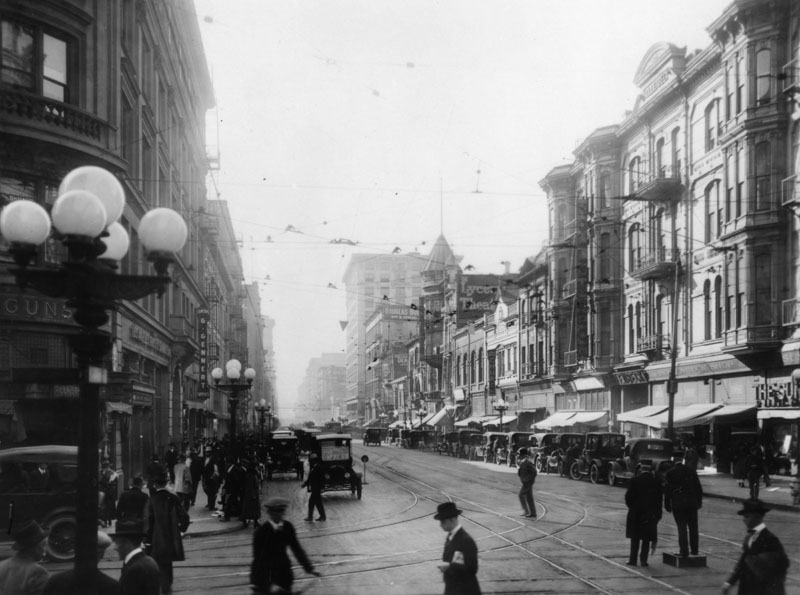 |
|
| (ca. 1920)^ - View of Spring Street looking south from 2nd Street. The 5-globe Llewellyn Electroliers can be seen on both sides of the street. |
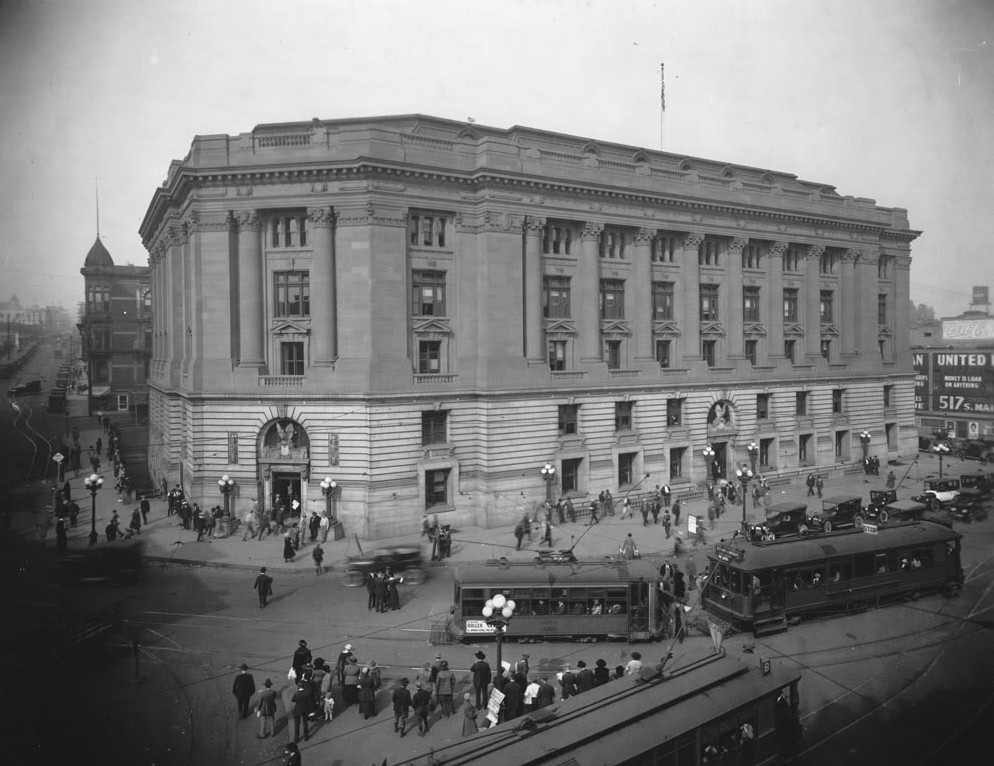 |
|
| (ca. 1920)*^ - A multitude of five-lamp ornate streetlights surround the old Federal Building and Post Office on the corner of Temple Street and Main Street. |
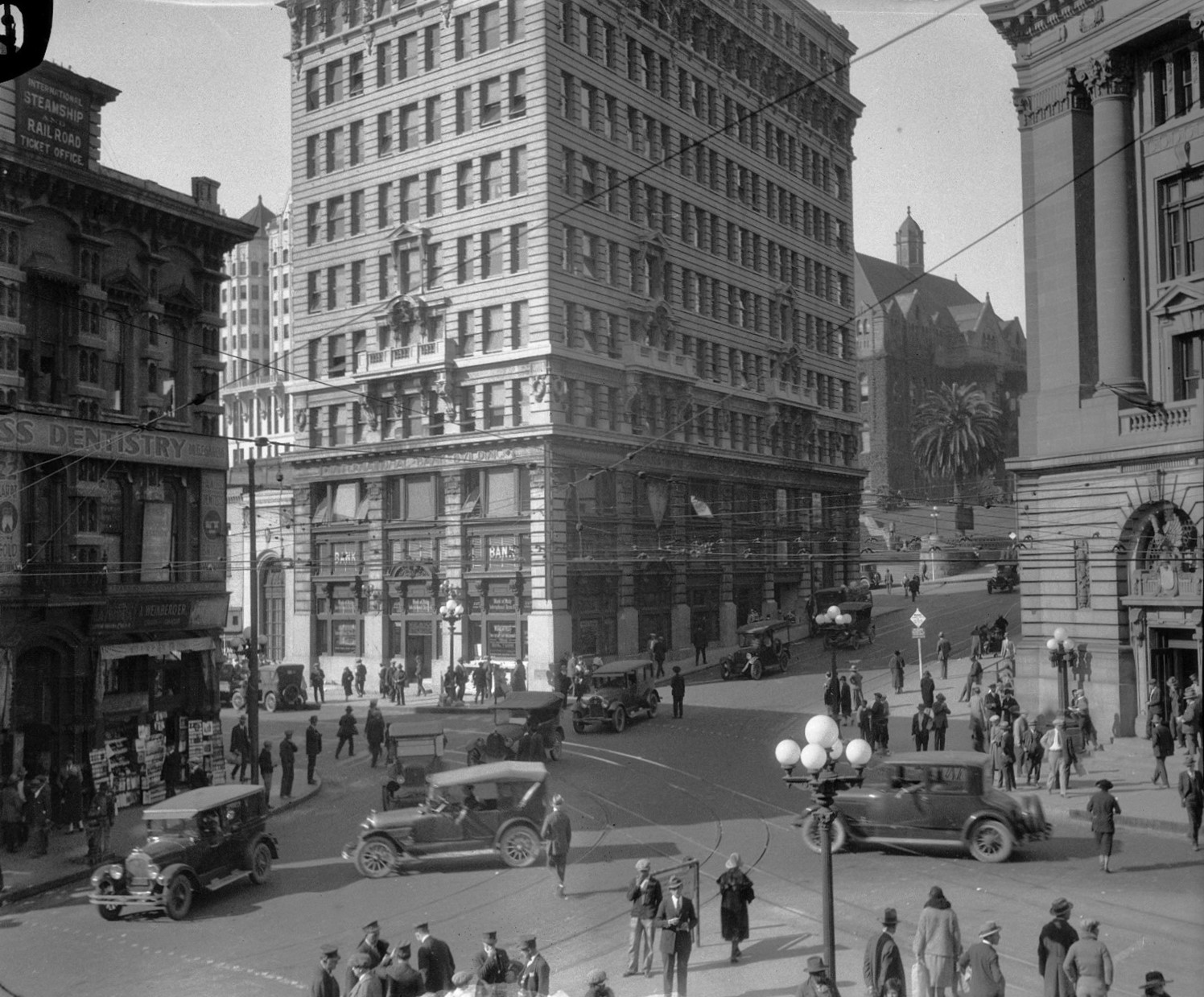 |
|
| (ca. 1924)* - The Temple Block area in Downtown with the International Bank Building at center. Note the beautiful 5-lamp ornate streetlights throughout the area. |
Historical Notes Not a single building in the above photograph survived. The building on the left is the Temple Block, the old Hall of Records is background left, then the International Bank Building, the Sandstone Courthouse on the back right, and finally the Federal Post Office on the far right. |
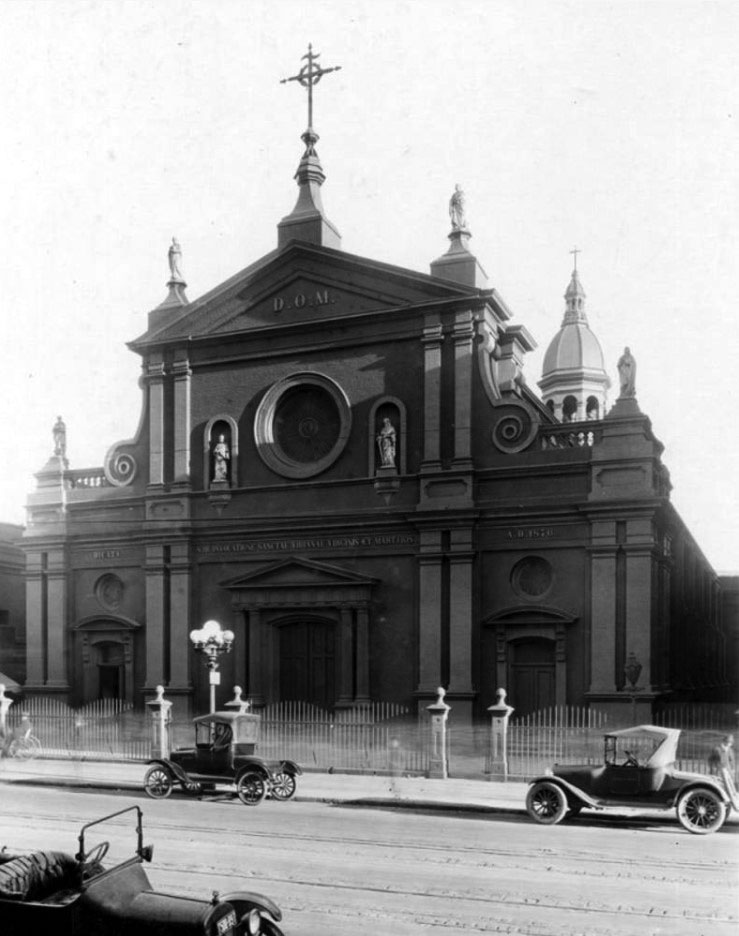 |
|
| (ca. 1920)* - The 5-globe Llewellyn Electrolier stands in front of the beautiful St. Viviana’s Cathedral near the SE corner of 2nd and Main streets. |
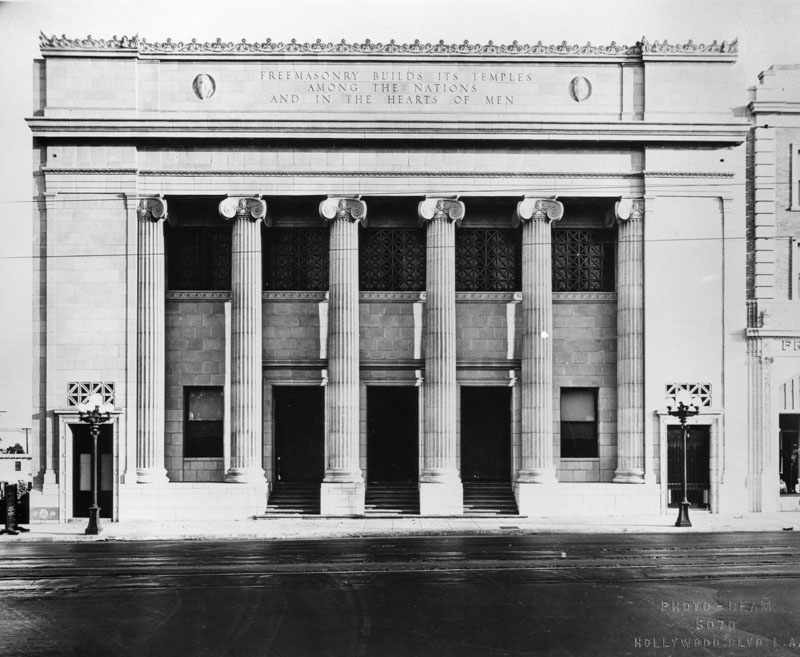 |
|
| (1922)^ - Two ornate 5-globe Llewellyn Electroliers stand guard in front of the Hollywood Masonic Temple located on the south side of Hollywood Boulevard between Highland and La Brea. |
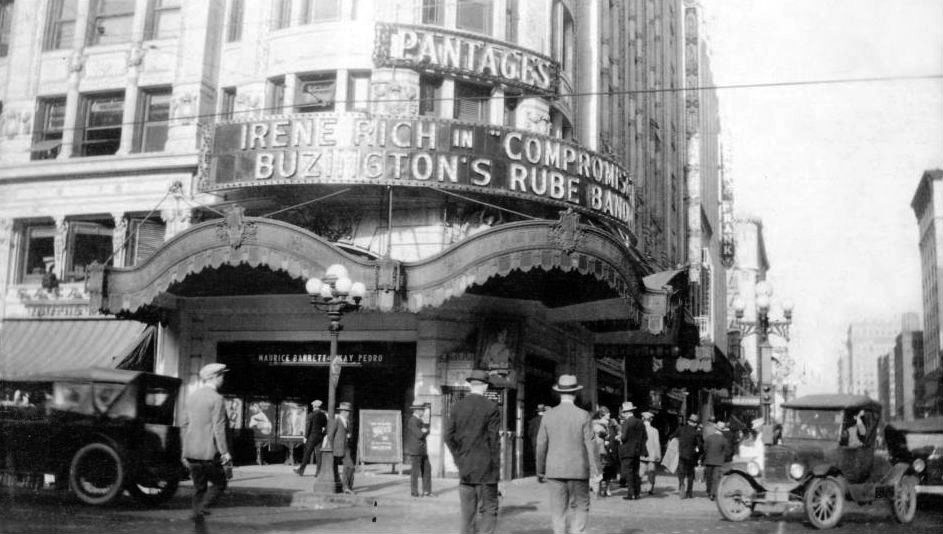 |
|
| (1925)^#* - Ornate 5-lamp streelight posts stand in front of entrance to the Pantages Theatre, NW corner of 7th and Hill streets. The curved marquee reads: Irene Rich in "Compromise" and Buzington's Rube Band. Note the more ornate 5-lamp Winslow streelight on HillStreet to the right. |
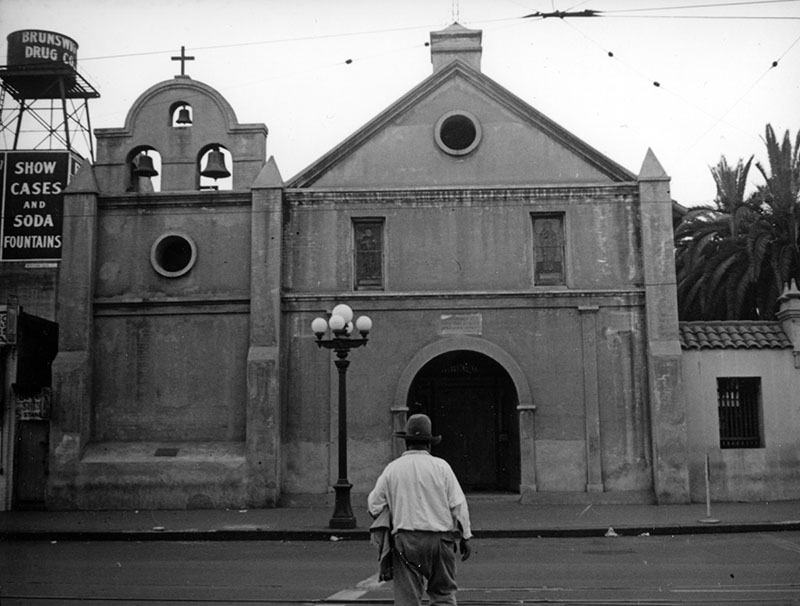 |
|
| (1930s)* - A man crosses Main Street heading toward the Old Plaza Church where a 5-lamp streelight post stands in front of the entrance. |
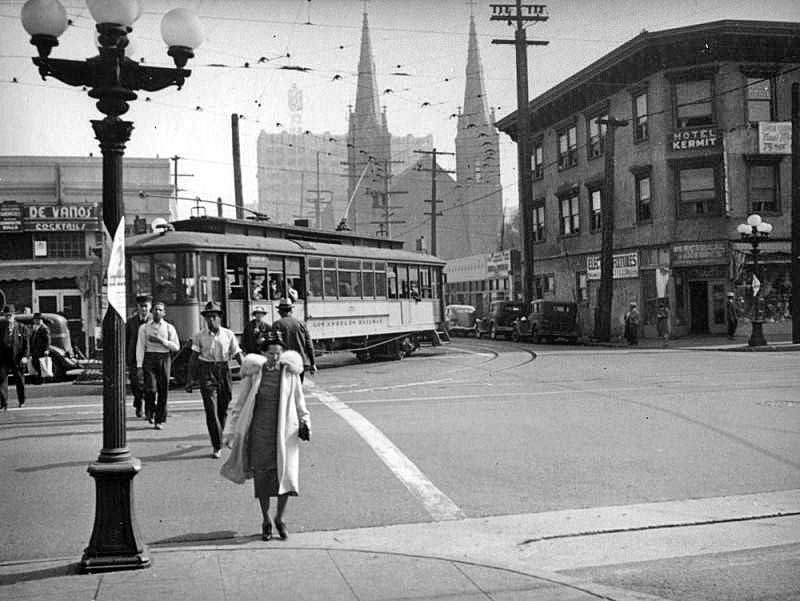 |
|
| (ca. 1937)* - A Five-Globe Standard Llewellyn Electrolier stands tall on the NW corner of Main and 12th streets. View is looking east on 12th Street showing pedestrians crossing Main with a streetcar turning north behind them. Also seen here is the Hotel Kermit (1206 1/2 South Main) and the Streamline Moderne De Vanos restaurant and cocktail on the corners. Further back in the distance can be seen the Gothic Revival St. Joseph Catholic Church and, further back, the Bendix Building with its iconic sign. |
* * * * * |
Streetlights of the San Fernando Valley
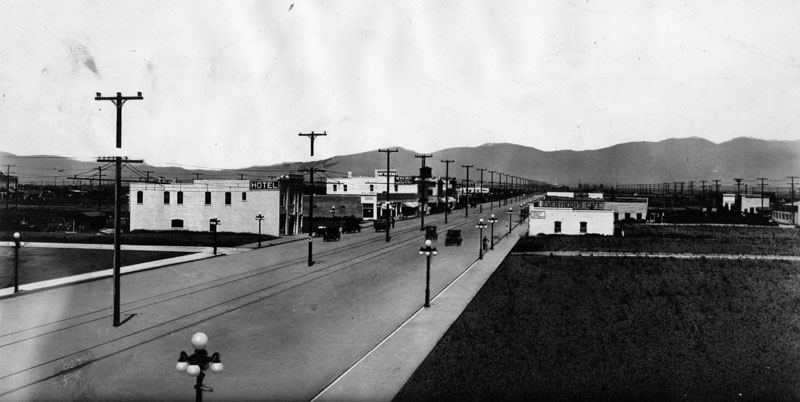 |
|
| (ca. 1912)^ - Early view of Van Nuys Boulevard (at the time known as Sherman Way), looking north. Note the ornate 5-lamp light posts along the sidewalks. These lamps were also installed in front of most of the old mansions in Downtown LA. |
Historical Notes The Van Nuys Highway Lighting District was organized August 10, 1912, under the California act providing for the highway lighting of unincorporated towns and villages and country sections. The Van Nuys District, which is 16 miles long and 8 miles wide, embraces about 52,000 acres in the southwestern part of the San Fernando Valley (at the time). The votes creating the district came from the new settlers. Sixty votes were recorded for and eighteen against. The small vote was due to the fact that the majority of people living in the tract came from other states and were not eligible to vote on account of not having been in California the required year. The first lighting undertaken by the district was along Sherman Way, the 16 mile boulevard extending thru the tract. A sum of $75,000 was recommended for this purpose, which was included in the 1912 taxes of the district, and the entire amount was raised in that year.* |
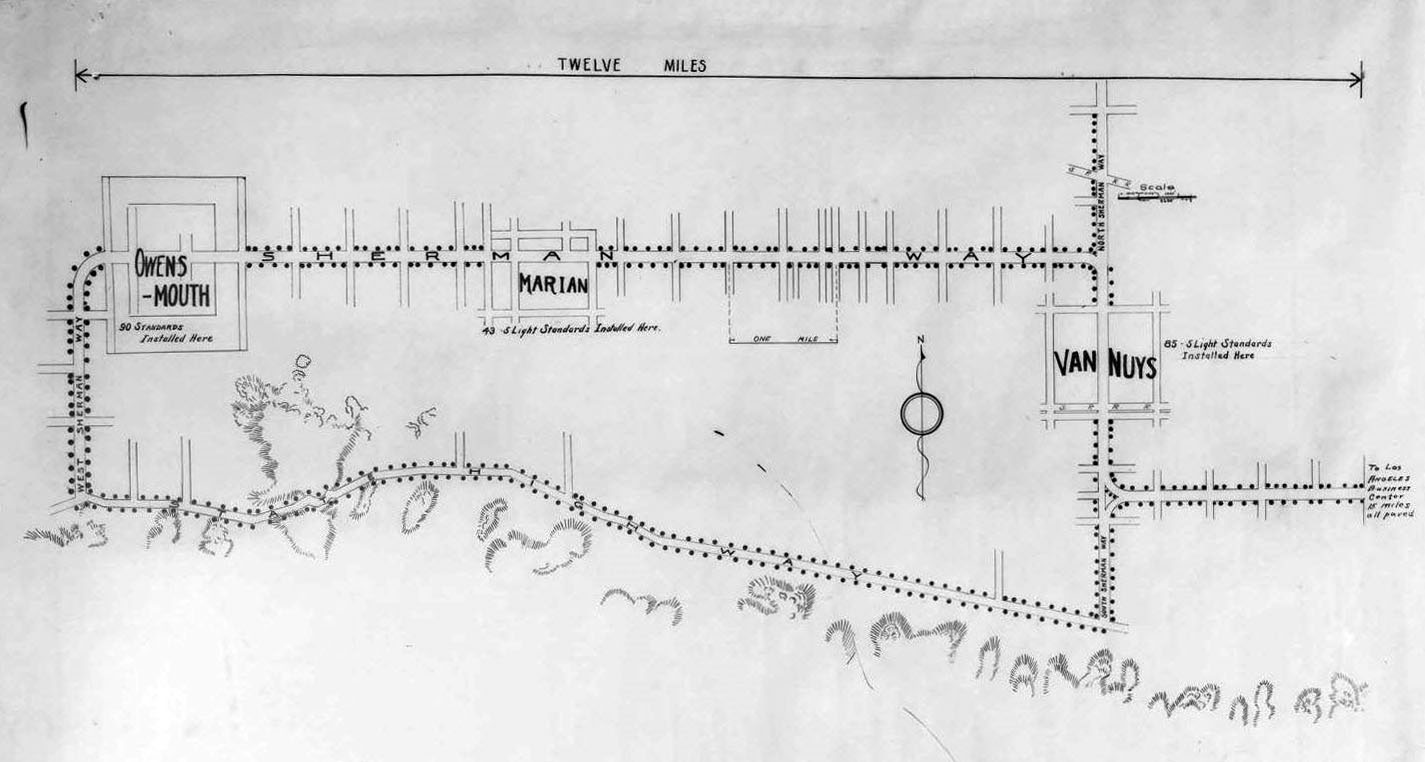 |
|
| (1913)* - Map showing the proposed streetlights for the Van Nuys/Marian/Owensmouth Lighting District. Photo courtesy of Dean Fields. |
Historical Notes This was the first Lighting District the County of Los Angeles created. When completed the lighting system had 484 three-light posts (electroliers) and 129 five-light posts (electroliers). Streetlight "Electroliers" are defined as free-standing streetlights generally on their own posts. The town of Marian became Reseda and Owensmouth is now Canoga Park. The above map shows the original route of Sherman Way, which today is west on Chandler, north on Van Nuys Blvd, and west on Sherman Way. The other sections of today's Van Nuys Blvd were known as South Sherman Way and North Sherman Way. |
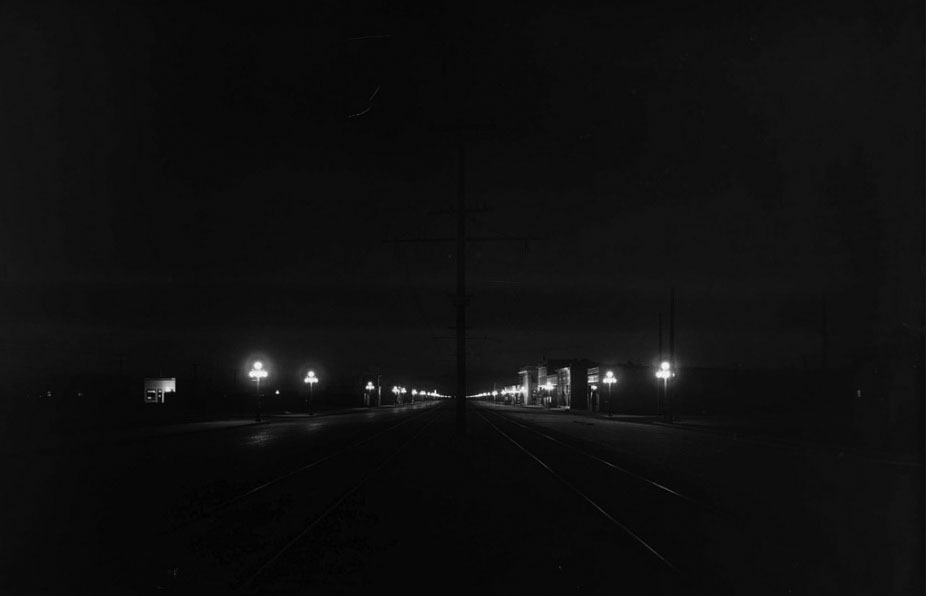 |
|
| (1913)* – Night view looking south on Sherman Way (later Van Nuys Boulevard). Two rows of 5-lamp electroliers illuminate the area showing two sets of tracks and an electrical pole line running down the commercial center of town. |
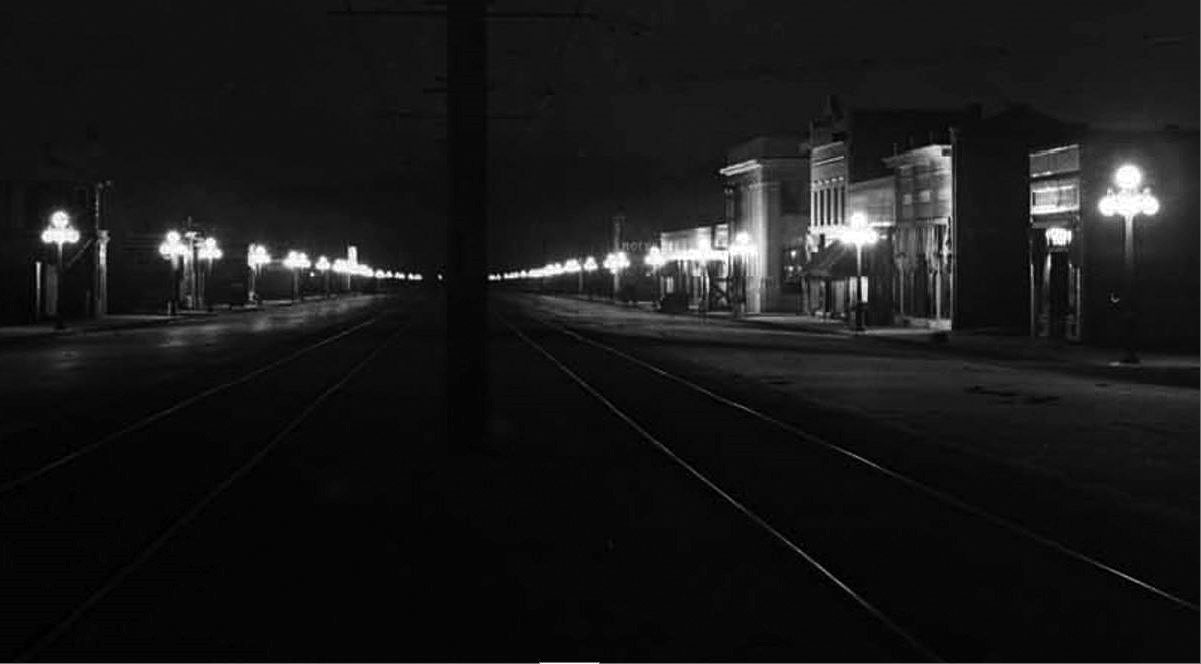 |
|
| (1913)* – Closer view of Sherman Way (later Van Nuys Boulevard) showing the multitude of 5-lamp streetlights lining both sides of the street. Also seen are streetcar tracks and and an electrical pole line running down the center of the Boulevard. This is a blow-up of the previous photo. |
.jpg) |
|
| (1913)* – Close-up detailed view showing a five light ornamental lamp. Street sign on lamp post reads: SHERMAN WAY. Sign on left reads: “Electroliers Wired & Installed by Llewellyn Iron Works”. Sign at right reads: “Private Road – Exclusively for Autos”. |
Historical Notes In the three townsites of Van Nuys, Marian, and Owensmouth, five-light clusters were used thru the main parts, four electroliers to every street intersection. On these five-light posts, one 60-watt lamp was upright and four 40-watt lamps pendant, and they were placed through the main parts of the towns, four electroliers to every street intersection.* The most common of the incandescent multiple globe electroliers of the early 1900s were those manufactured by the Llewellyn Iron Works of Los Angeles. The firm became so identified with this style of street light that any multiple globe electrolier became commonly known as a Llewellyn. The Llewellyn Iron Works, founded in 1889‐1890, was one of the largest metal working facilities in Los Angeles. It manufactured structural steel – including that for the Bradbury Building.^ |
 |
|
| (ca. 1913)* – View looking down on an unpaved Sherman Way showing an ornate Llewellyn Iron Works 3-lamp electrolier. |
Historical Notes Cast-iron electroliers (made by Llewellyn Iron Works of Los Angeles) were used with three-light clusters for use along the boulevard outside the townsites, one 60-watt lamp upright and two 40-watt lamps pendant. The electroliers were located 330 feet apart staggered, or 660 feet apart on each side of the boulevard, which is about 100 feet wide.* These same type of streetlight electroliers can be found today on Carroll Avenue. |
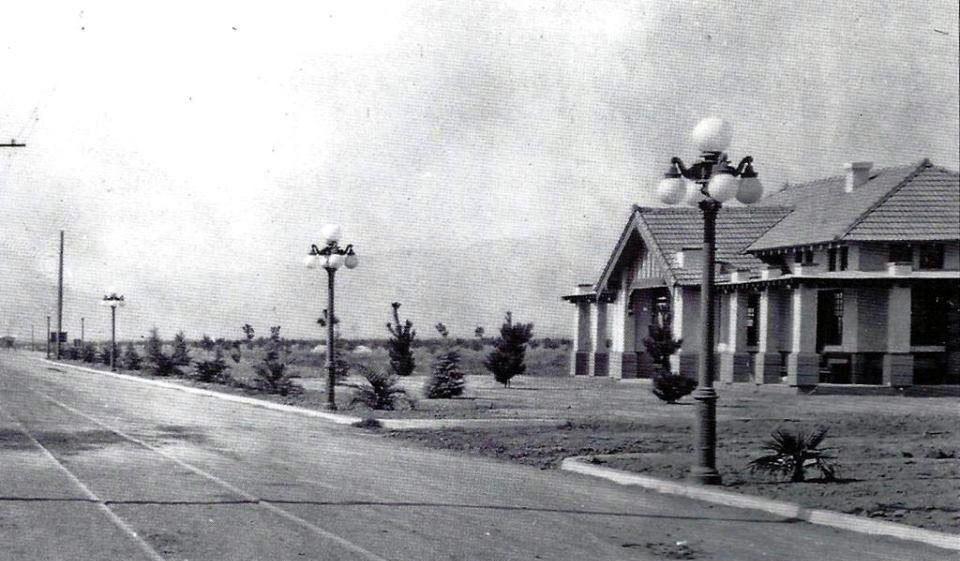 |
|
| (ca. 1913)* - View showing the Owensmouth PE station looking west along Sherman Way. Park Ave [now Vassar Ave] enters at right; behind the Simi Hills can be dimly seen. Note the five-lamp ornamental streetlights along Sherman Way. |
Historical Notes Sherman Way became the first paved boulevard across the valley. Following this was the paving of the state highway aka the Ventura Road, from the Cahuenga Pass to Newbury Park. Eventually, the road ran all the way to Ventura, and was renamed Ventura Boulevard. |
* * * * * |
Windsor Square
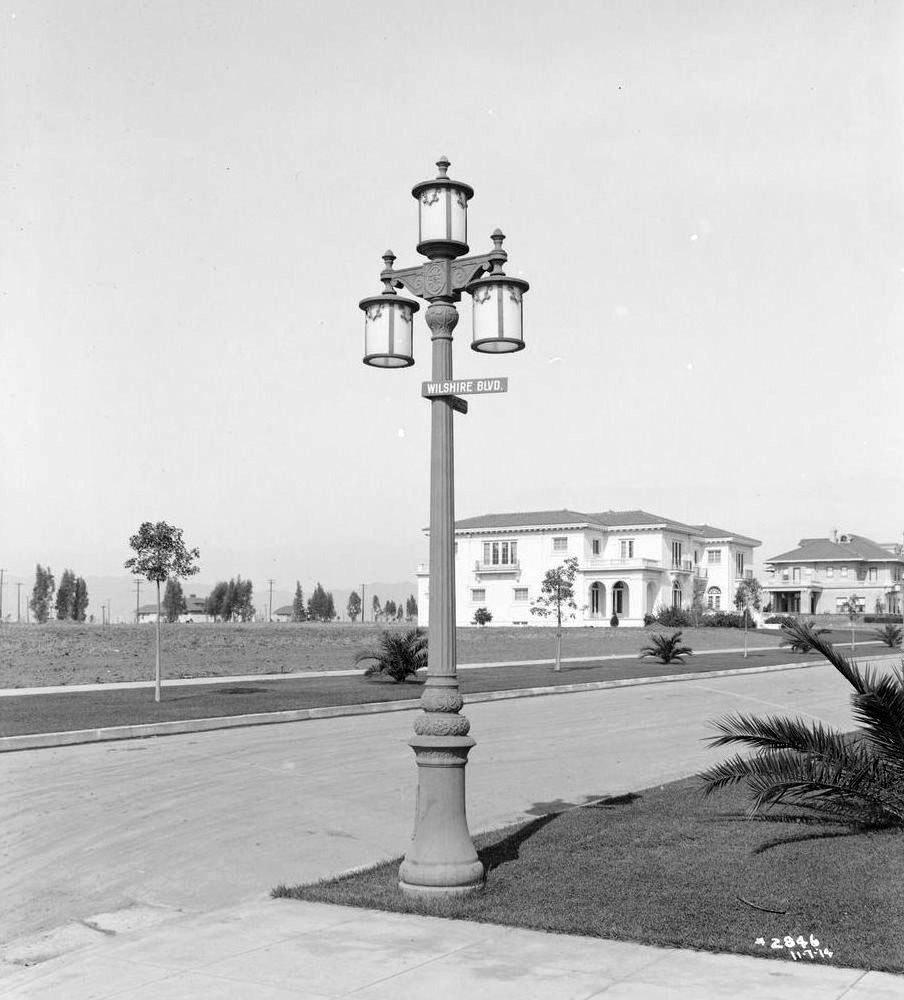 |
|
| (1914)* - View of a 3-lamp electrolier on the corner of Wilshire and Windsor boulevards. This is the west side of the 600 south block of Windsor Blvd. in Windsor Square. Both houses in the photo amazingly resemble some of the homes built today. However, the house on the left was built in 1911 and the house on the right in 1914. |
* * * * * |
Llewellyn "Chester" Lamps
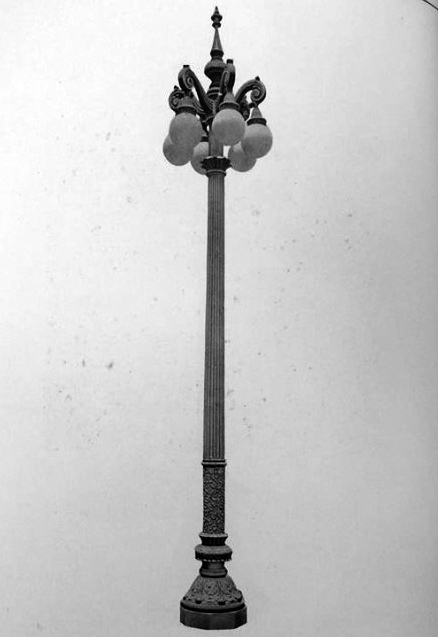 |
|
| (1928)^.^ - The "Chester" electrolier shown here in the 1928 Llewellyn Iron Works Catalog. Height: 14’ 3½”; Size of base: 18”; Largest dimension of column: 7½”. These were installed in the West Adams district. |
Historical Notes The most common of the incandescent multiple globe electroliers of the early 1900s were those manufactured by the Llewellyn Iron Works of Los Angeles. The firm became so identified with this style of street light that any multiple globe electrolier became commonly known as a Llewellyn. The Llewellyn Iron Works, founded in 1889‐1890, was one of the largest metal working facilities in Los Angeles. It manufactured structural steel – including that for the Bradbury Building.^ |
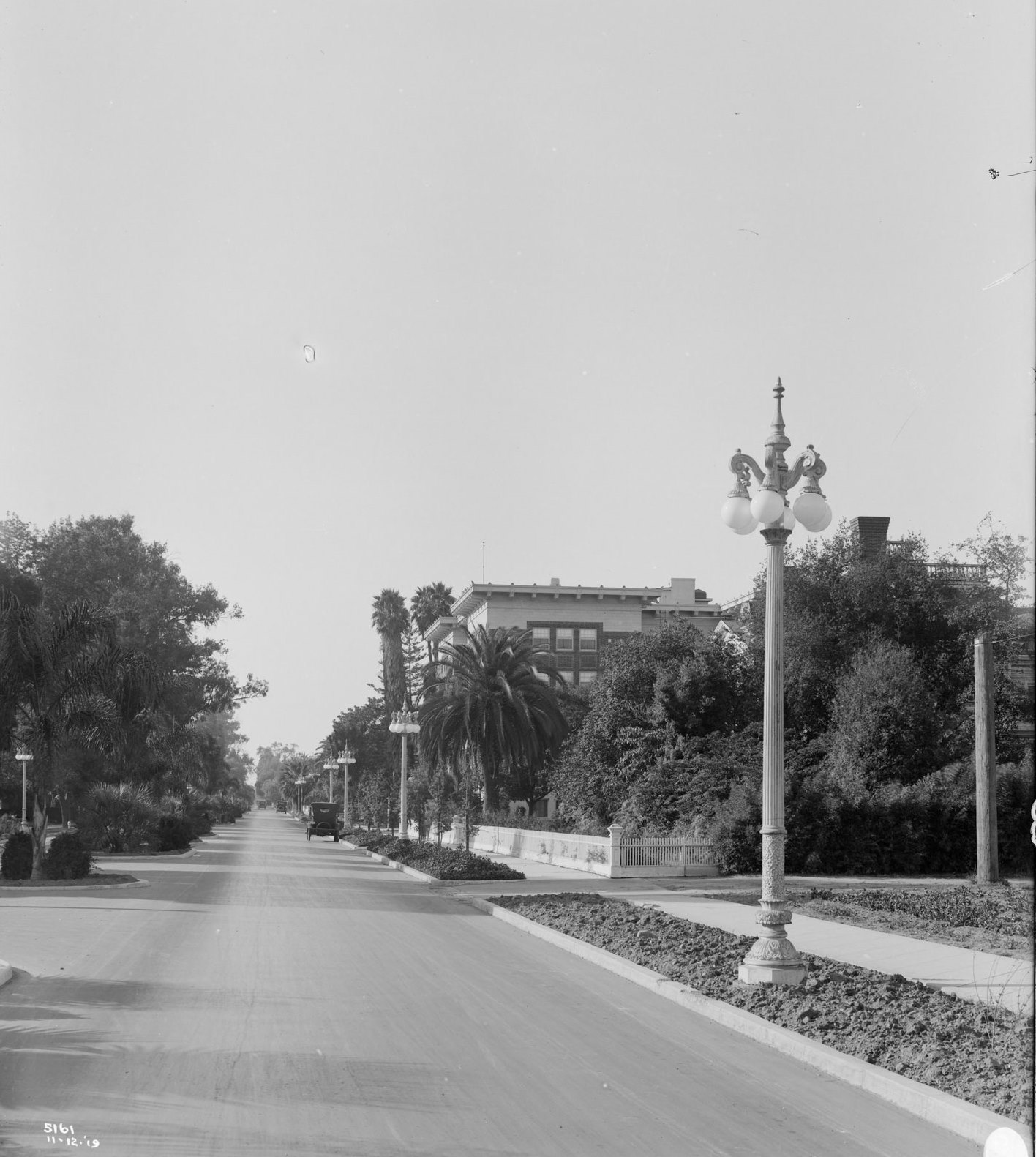 |
|
| (1919)^^* - View of Adams Street in 1919 showing inverted six-globe 'Chester' lighting posts along the parkway. |
Historical Notes Called Llewellyn “Chester” lamps, these six-globe streetlights were installed in the West Adams district beginning in 1903 (Named for Chester Place, one of the first gated communities in Los Angeles). |
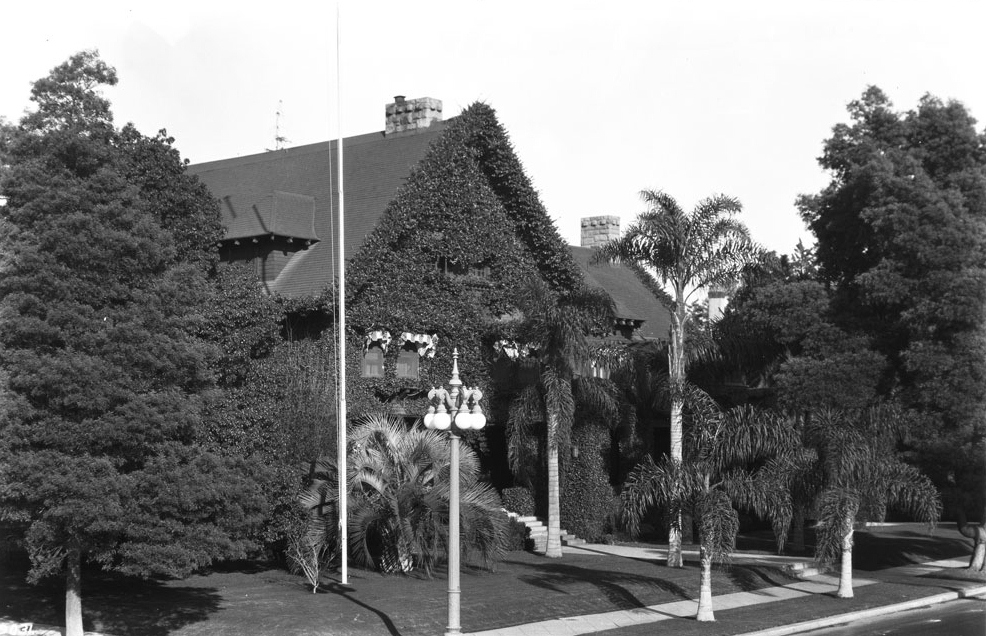 |
|
| (ca. 1924)*^ - A close-up view showing one of the six-globe 'Chester' electroliers in front of a Craftsman three story home on Adams Street, west of Figueroa Street. |
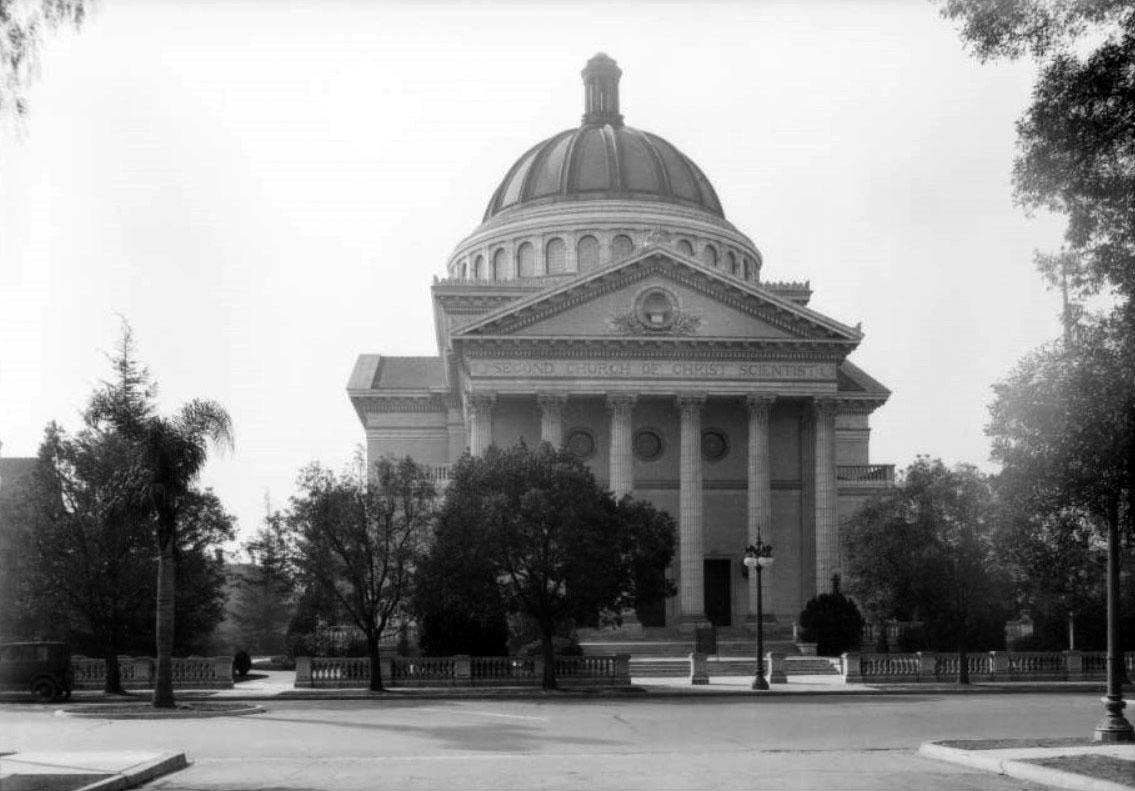 |
|
| (ca. 1928)*^ - View looking south on Portland Street toward Adams Boulevard. A six-globe streetlight stands in front of The Second Church of Christ Scientist (today the Art of Living Foundation) at 946 W. Adams Blvd. |
 |
|
| (1935)*^ - Two different style streetlights stand at the corner of West Adams Boulevard and Hoover Street, with an Art-Deco Union 76 station in the background. Click HERE to see more Early LA Gas Stations. |
Historical Notes The "Chesters" can still be found along Chester Place, now a private street bisecting the campus of Mount St. Mary's College. But only the tops of the survivors match the catalog image seen in previous photo. The shafts and bases are different. |
* * * * * |
Early Street Lights - Bureau of Power and Light
 |
|
| (Early 1920s)* - Bureau of Power and Light crew working on an ornamental street light. |
LADWP Historical Archive (1973) Despite the variety of designs, street lights are known as either electrolier or utilitarian types, according to Harvard Johnson, engineer in charge of Street Light Design. Customers own the electroliers --- lamps affixed to concrete or metal posts. The customer-owners of these are most likely the Department of Public Works or residents who form a private street lighting district. |
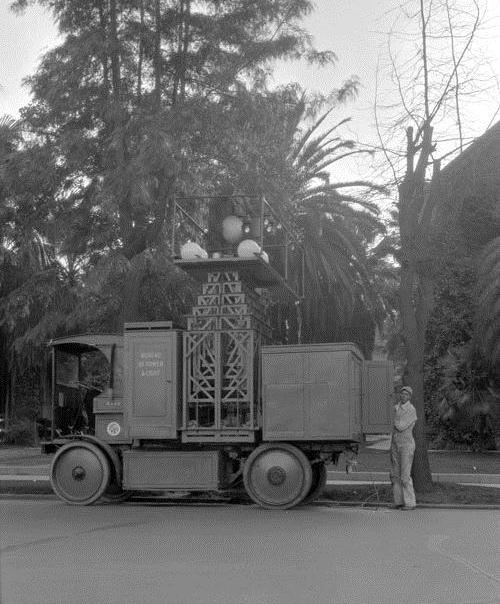 |
|
| (Early 1920s)* - An electric powered street light truck used by the Bureau of Power and Light in the 1920s. |
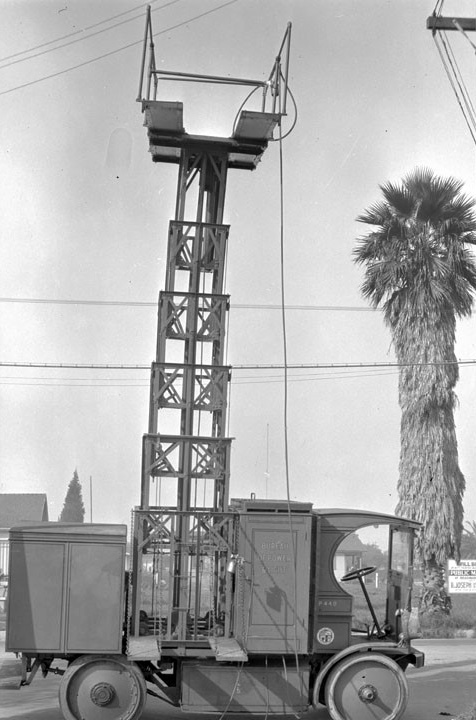 |
(Early 1920s)* - Electric-powered street light truck with platform fully extended.
|
Dual-lamp UM (Union Metal) 1906 Electroliers
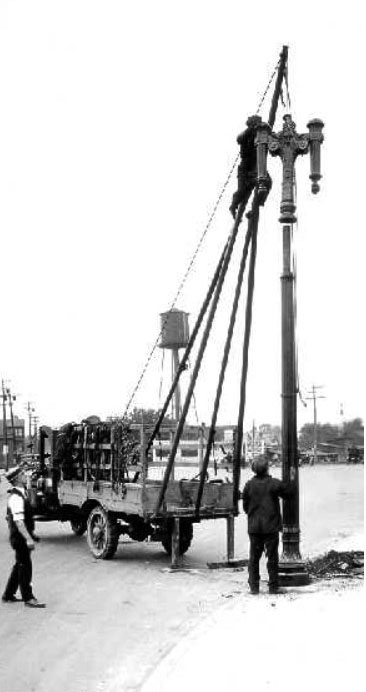 |
(1920s)^^ - A worker is perched at the end of a crane while installing a new two-lamp UM (Union Metal) 1906 streetlight assembly as two men watch below. |
Historical Notes Replacing the five-globe Llewellyn in Downtown Los Angeles and extending outward along several major streets, hundreds of dual-lamp electroliers (UM 1906's) were installed in the mid 1920's. The UM-1906 was manufactured by the Union Metal Company of Canton, Ohio. The company was founded in 1906 to produce ornamental porch columns and pergolas. By 1909 it began marketing ornamental street lighting, with its first major catalog of electroliers issued in 1915. Union Metal eventually supplied more than 4400 towns and cities with street lights. The UM-1906 is currently offered by the Bureau of Street Lighting as an option for roadway street lighting.* One of the most significant variations of the UM-1906 dual-lamp streetlight was the UM-2502, which contained an extended center pole from which trolley wires could be suspended. Click HERE to see more. |
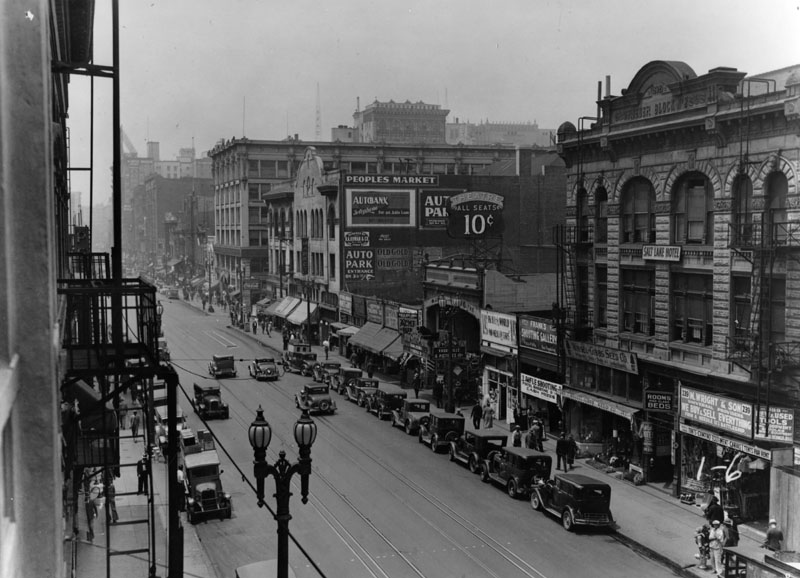 |
|
| (ca. 1920s)* - A dual-lamp UM-1906 electrolier is seen in the foreground on Spring St. between 2nd and 3rd Streets. |
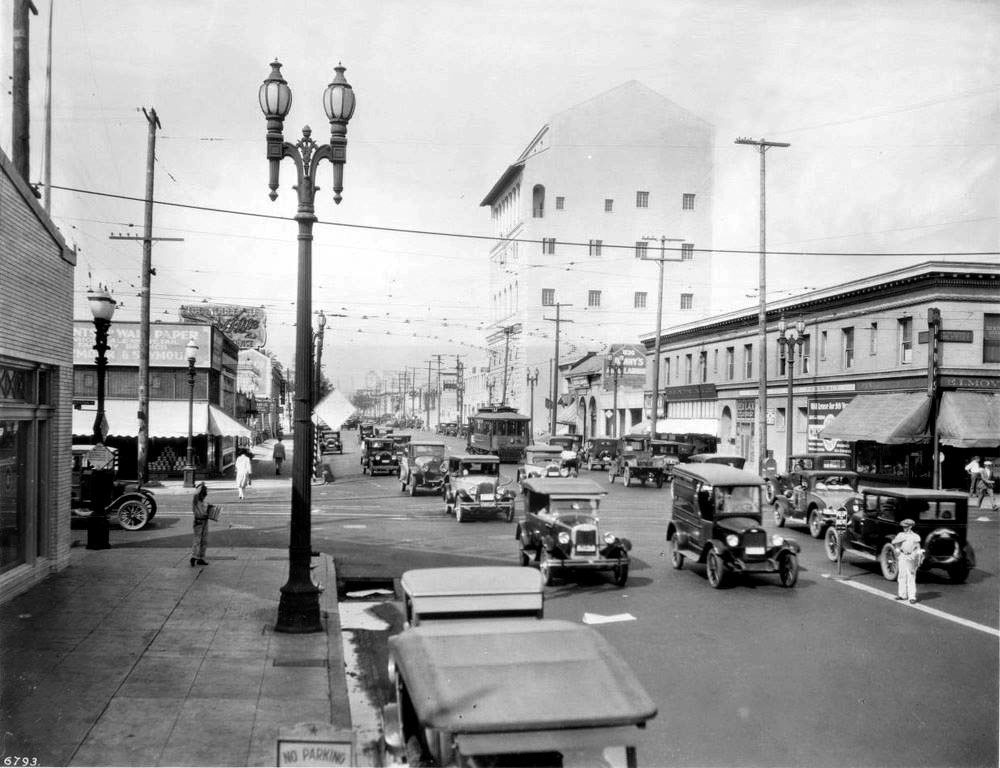 |
|
| (ca. 1927)*^ - View looking north on Figueroa from just south of Washington Boulevard. A paperboy dressed in light-colored clothing stands at the center of the street to the right hawking papers while cars pass him on either side. A dual-lamp UM-1906 electrolier stands in the foreground. The tall building in the background is the Patriotic Hall. |
Historical Notes Many of these dual-lamp UM-1906's still exist today in select areas of Downtown L.A., although most are refurbished. Click HERE to see contemporary views of dual-lamp 1906's. |
Broadway Special
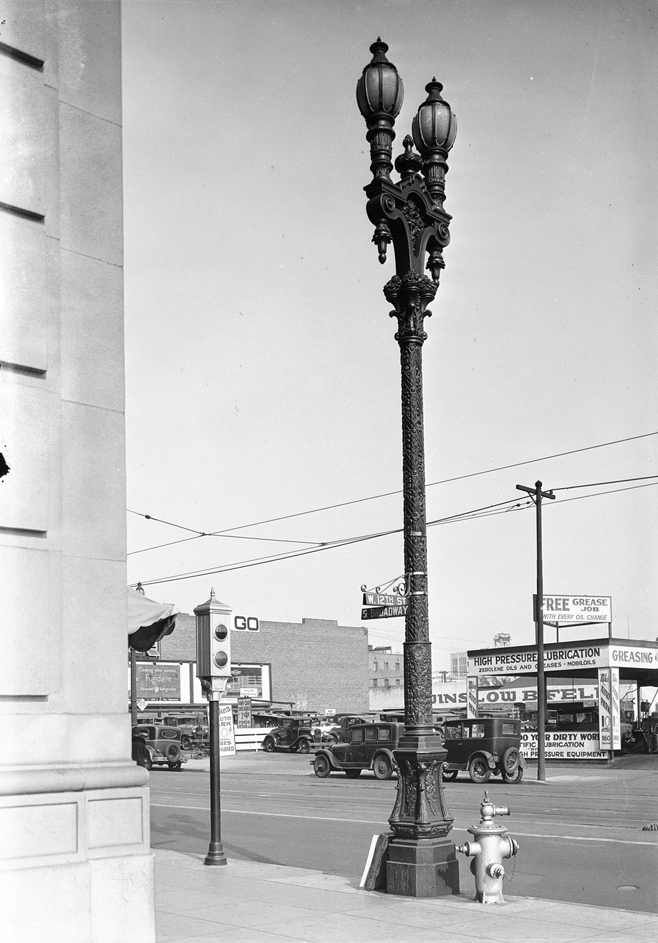 |
|
| (ca. 1920s)*^ - A two-lamp Keystone electrolier ('Broadway Special') stands on the corner of West 12th Street and South Broadway with an early traffic signal (Acme Semaphore), with sign reading "Go", to its left. Adjacent to the ornate streetlight base stands a fire hydrant. |
Historical Notes To get cars and commerce moving through the downtown business district, Los Angeles installed its first automated traffic signals in October 1920 at five locations on Broadway. These early signals, manufactured by the Acme Traffic Signal Co., paired “Stop” and “Go” semaphore arms with small red and green lights. Bells played the role of today’s amber or yellow lights, ringing when the flags changed—a process that took five seconds. By 1923 the city had installed 31 Acme traffic control devices.* |
Broadway Rose and Broadway Special
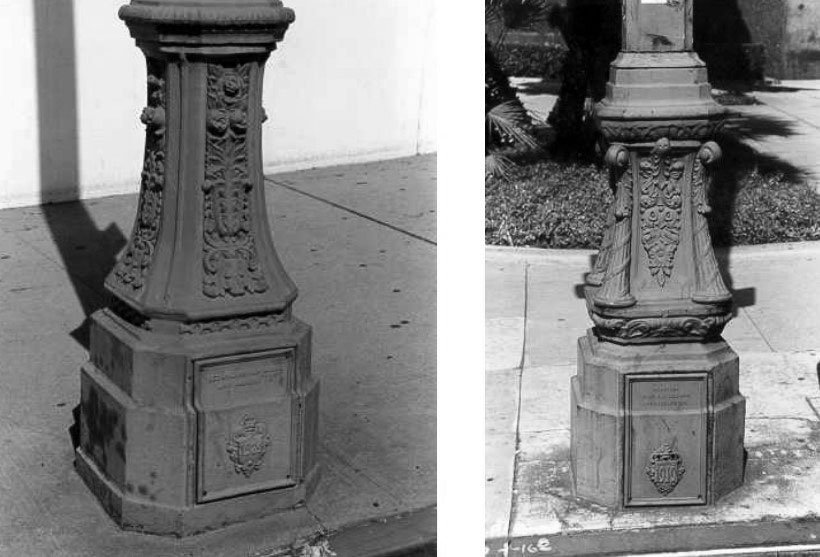 |
|
| (n.d.)^^ - There were two distinctive pole bases used on Broadway in 1920 through 1930, one ornamental with rosebuds known as the 'Rose' (left photo) another adorned with a cypress leaf and other known filigree known as the 'Broadway Special' (right photo). |
Historical Notes Manufactured by Keystone Iron & Steel Works of Los Angeles, the "Roses" were found mid-block, and the "Specials" were at the intersections. When the shafts and luminaires were changed in 1948, the bases of both designs were left in place. But, because the "Specials" were at the intersections, they were the most vulnerable to updates to the traffic light and intersection improvements. So, all the "Special" bases eventually vanished, while the "Rose" bases are still quite plentiful. |
Broadway Roses
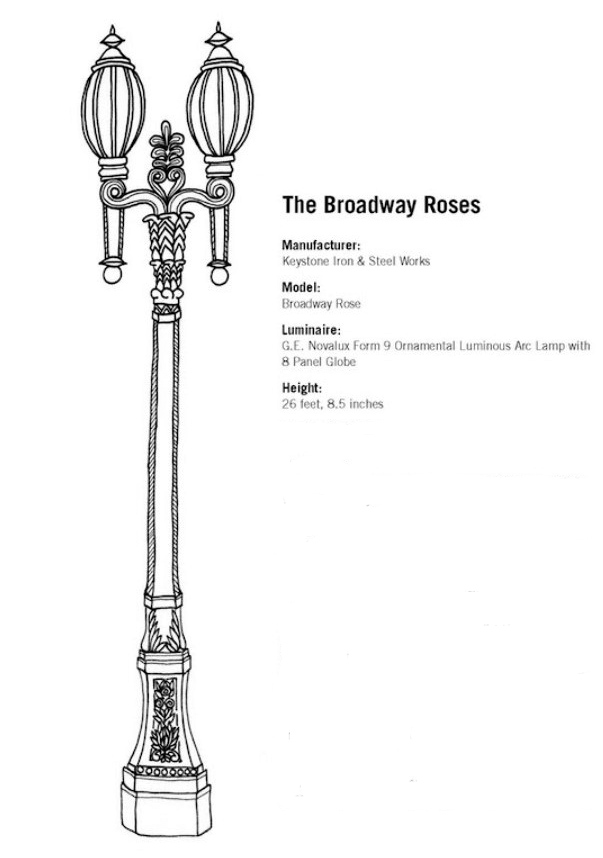 |
|
| (n.d.)^.^ - Sketch showing the Broadway Rose with specifications. Drawing by Didi Beck |
Historical Notes Marked by three ornate ribbons of roses climbing up their safts, the eponymous Broadway Roses, designed by a General Electric engineer and originally installed in 1919, used to extend from Aliso Street to Pico Boulevard. Given that Broadway was the first L.A. street to have ornamental lights, hailed in the papers as “the radiant way,” this lamp’s lavish design should come as no surprise. (In fact, the Roses originally shared Broadway with an even grander, more filigreed type of post—the Spanish Renaissance-inspired Broadway Special, designed by the same engineer.) The response was overwhelming: “This is one of the most elaborate jobs of ornamental electroliers ever made on the coast,” the Los Angeles Times observed, “and is a 100 percent home product.” Unfortunately, the excitement didn’t last. During the 1950s, the shafts and luminaires of the Broadway Roses were replaced with more functional, higher intensity, yet decidedly more somber CD-913 overheads, leaving only the original bases intact. Today there are only a handful of complete models remaining in Los Angeles, which can be found running down Sixth Street between Olvie and Flower Streets. The Broadway Specials, incidentally, have vanished altogether.* |
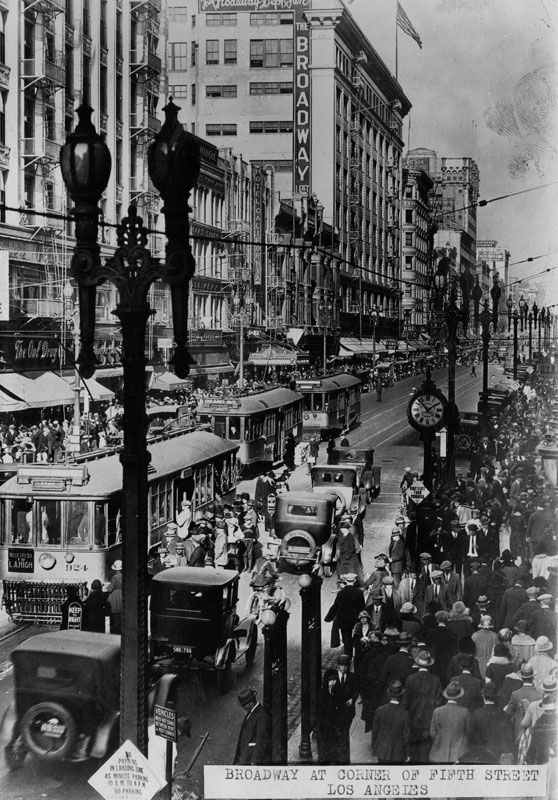 |
|
| (ca. 1920s)* - A busy scene with pedestrians and city traffic in this view of Broadway and 5th looking north, showing, as far as the eye can see, the new two-lamp electroliers nicknamed "Broadway Roses"(left) and "Broadway Specials". The "Roses" were found mid-block, and the "Specials" were at the intersections. |
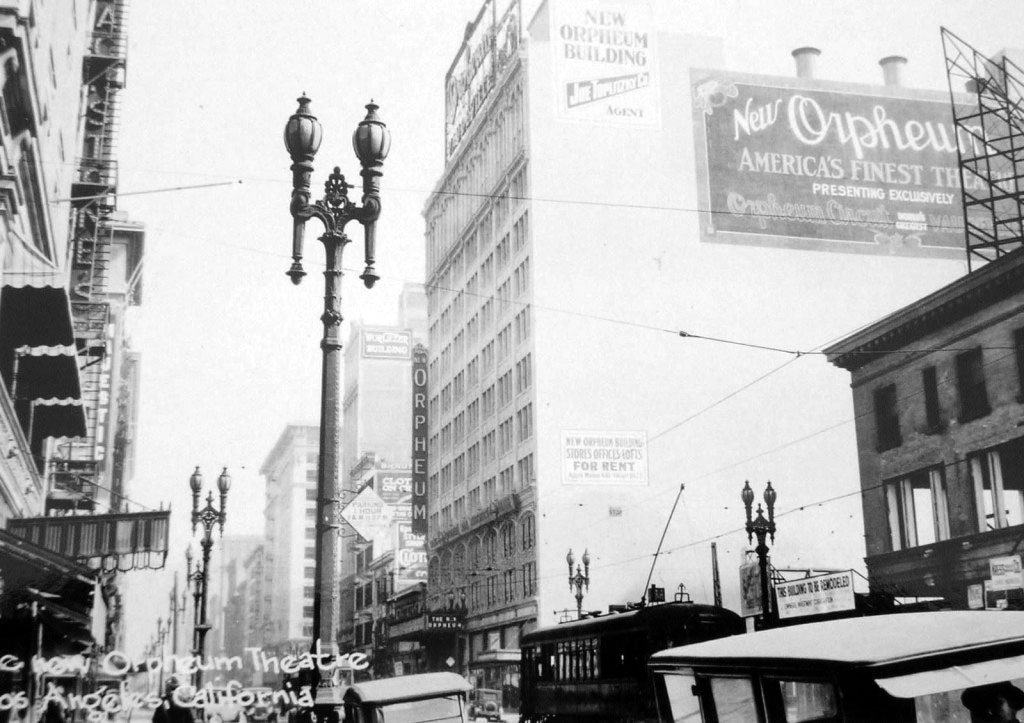 |
|
| (ca. 1926)^^* – View looking north on Broadway showing dual-lamp Broadway Roses lining both sides of the street. The Orpheum Building is seen on the east side of Boradway with a sign on its side that reads: ‘New Orpheum – America’s Finest Theatre – Presenting Exclusively – Orpheum Circuit Vaudeville’ |
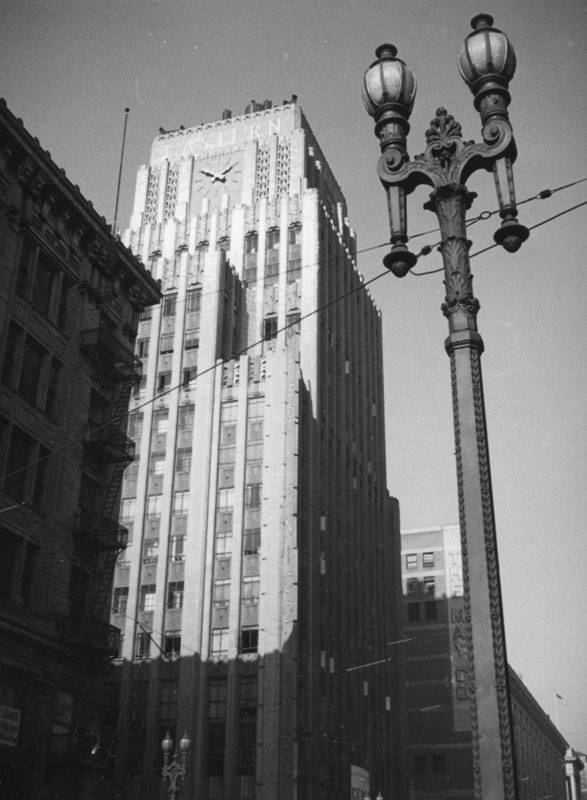 |
|
| (1937)^ - Detailed close-up view of a dual lamp Broadway Rose located near 9th and Broadway. In the background is the sunlit Eastern Columbia Building (849 South Broadway) and further down the block the May Company (800 South Hill Street). |
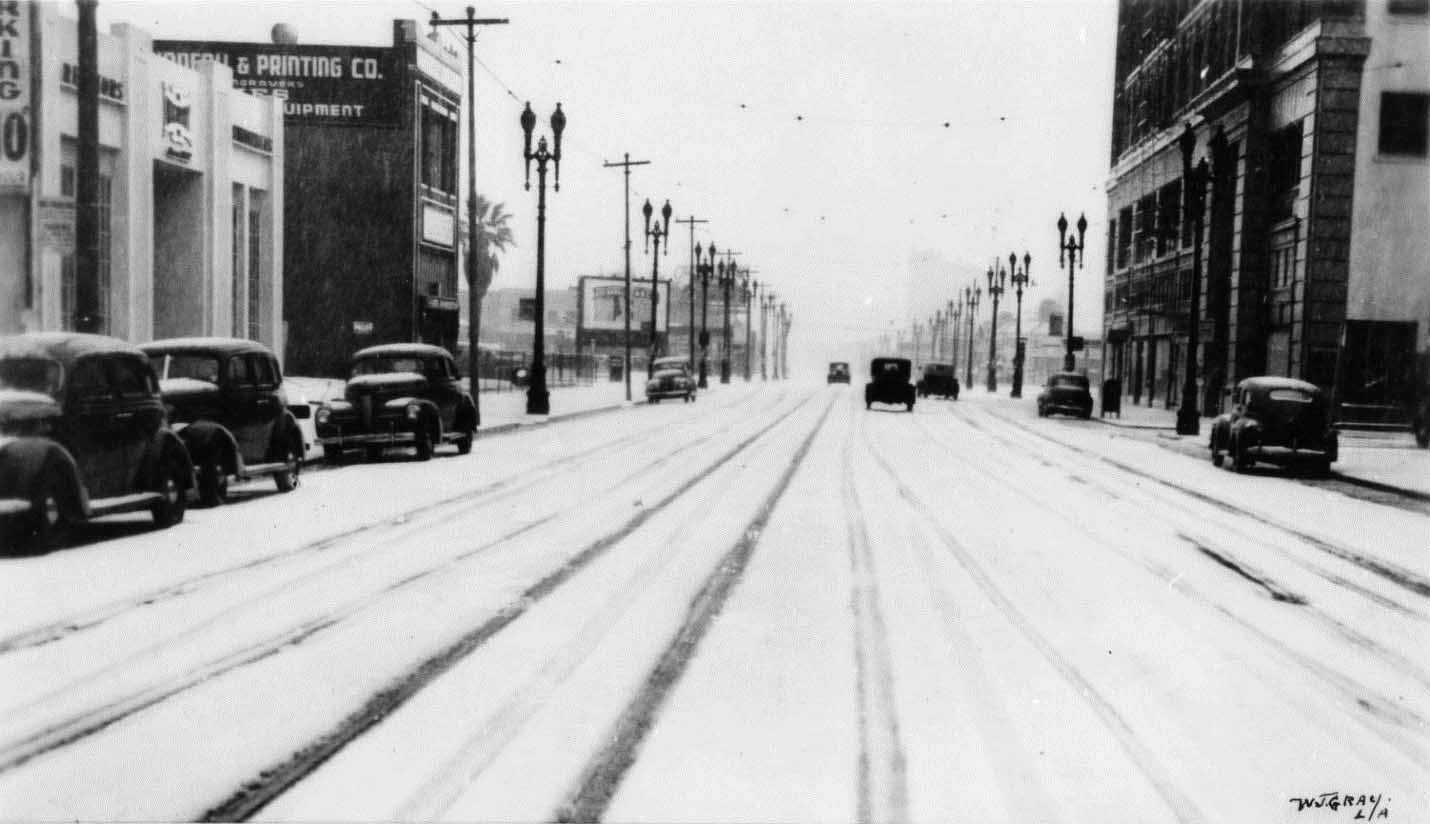 |
|
| (1944)* - Snow in DTLA! Looking south on Broadway from 12th Street after a snow storm. The Chamber of Commerce Building is seen on the right (demolished in 1968, today Public Works building). Note the beautiful dual-lamp Broadway Roses running up and down both sides of Broadway. |
Broadway Specials
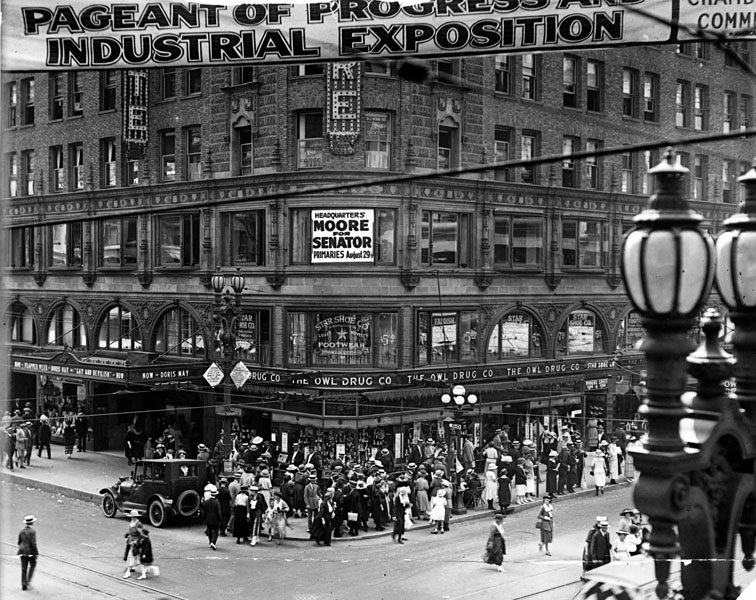 |
|
| (1922)* - View of the Loew's State Theatre building located at the intersection of Broadway and 7th Streets. On the right is a close-up view of the dual-lamp Broadway Special that was so prevalent on Broadway in downtown LA starting in the 1920s. |
Historical Notes The 'Specials' were placed at the intersections of Broadway, while the 'Roses' were located at mid-block. |
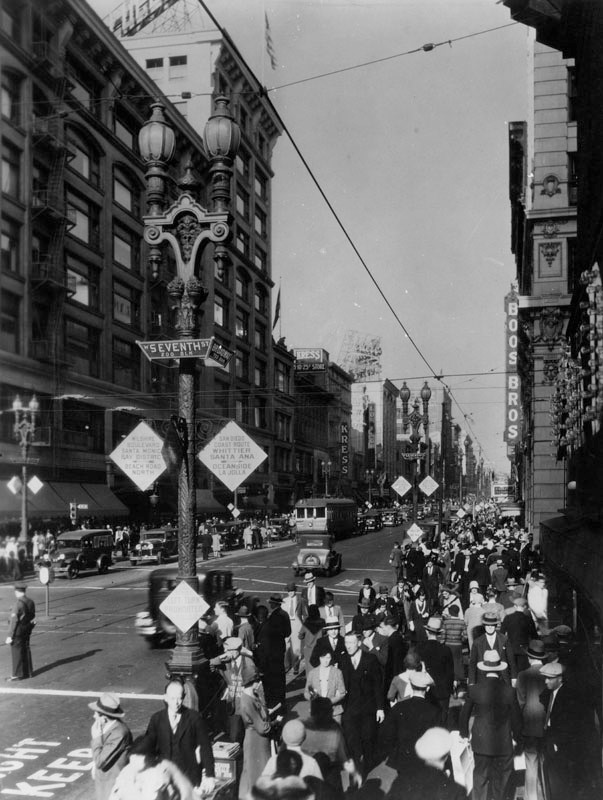 |
|
| (1926)* - View showing a 'Broadway Special' standing tall (26.5 feet) on the SE corner of 7th and Broadway, with hundreds of people walk by. |
Historical Notes The new Spanish Renaissance-inspired “Broadway Specials” and their efflorescent siblings, the “Broadway Roses,” were praised by the Journal of Electricity as “a new note in street lighting.” The Los Angeles Times hailed the installation as “one of the most elaborate jobs of ornamental electroliers ever made on the coast.” The Broadway Specials no longer exist, but the Broadway Roses still light up West Sixth Street between Olive and Flower Streets.* |
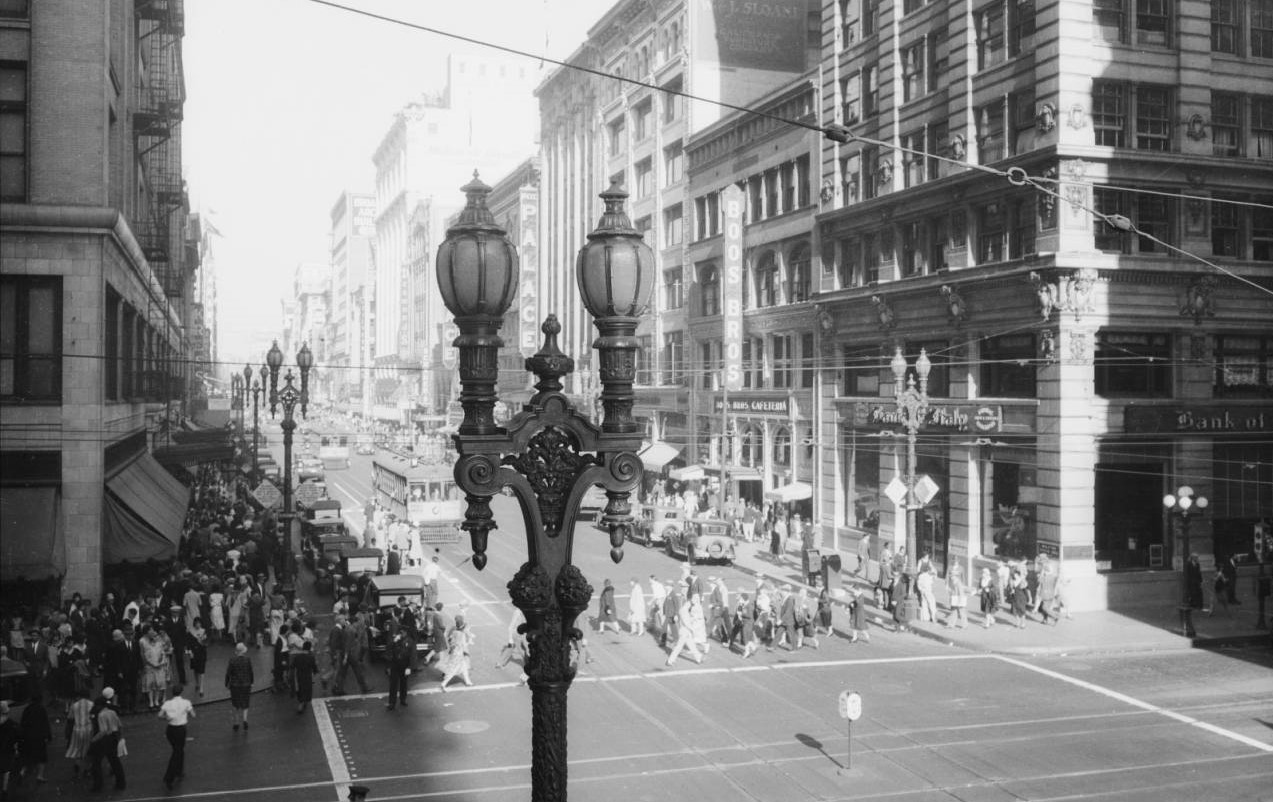 |
|
| (1930)*^ – Close-up view of a dual-lamp 'Broadway Special' on the southwest corner of Broadway and 7th Street. These electroliers are seen running up and down both sides of Broadway, with the 'Specials' at the intersections and the 'Roses' in mid-block. |
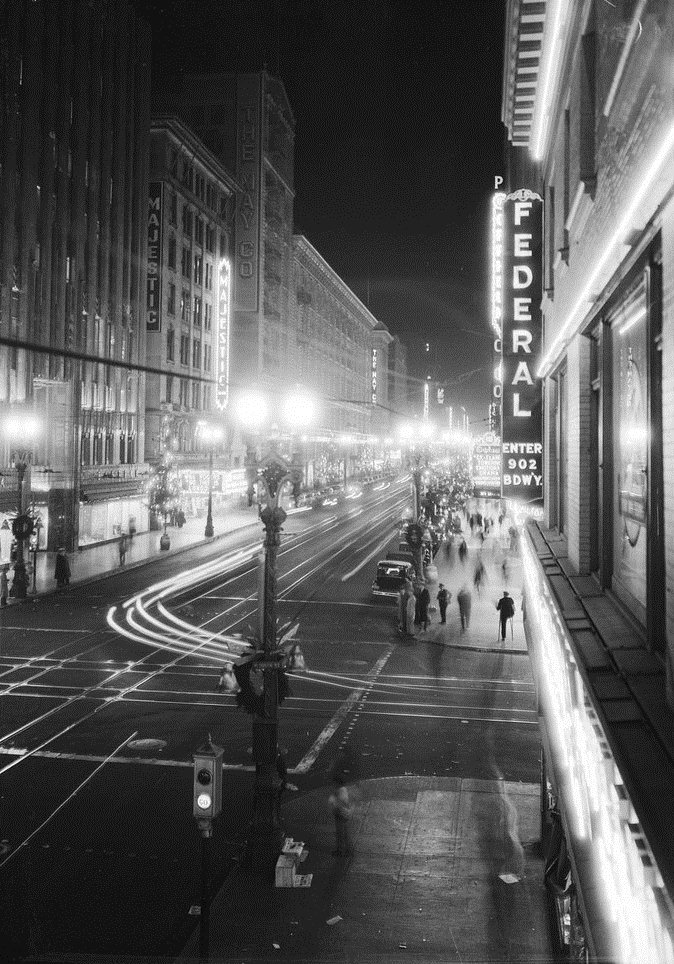 |
|
| (ca. 1938)*^ - Nightime view of Ninth Street and Broadway showing Cristmas decorations hanging from the dual-lamp Broadway Specials and Broadway Roses. Note the Semaphore Traffic Signal in the foreground. |
Historical Notes Los Angeles installed its first automated traffic signals in October 1920 at five locations on Broadway. These early signals, manufactured by the Acme Traffic Signal Co., paired "Stop" and "Go" semaphore arms with small red and green lights. Bells played the role of today's amber or yellow lights, ringing when the flags changed—a process that took five seconds. By 1923 the city had installed 31 Acme traffic control devices. ^* |
* * * * * |
Llewellyn 'Broadway' Dual-lamp Electrolier
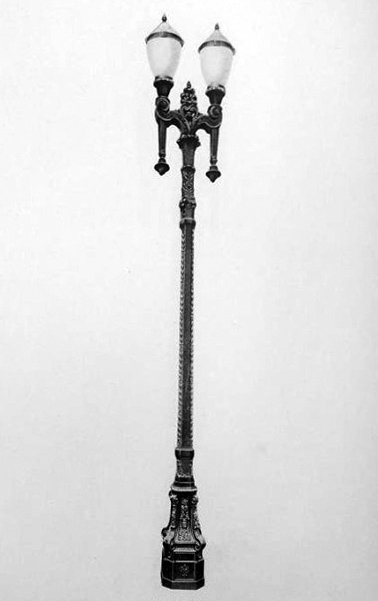 |
|
| (1928)^.^ – The “Broadway” two-lamp streetlight as seen in the Llewellyn Catalog. Similar to the dual-lamp streelight manufactured by Keystone Iron & Steel Works. It had the top of a "Broadway Rose" with a base similar to "Broadway Special." |
Historical Notes Llewellyn's 'Broadway' dual-lamp streetlight was last seen on 5th Street in downtown Los Angeles (see next photo). |
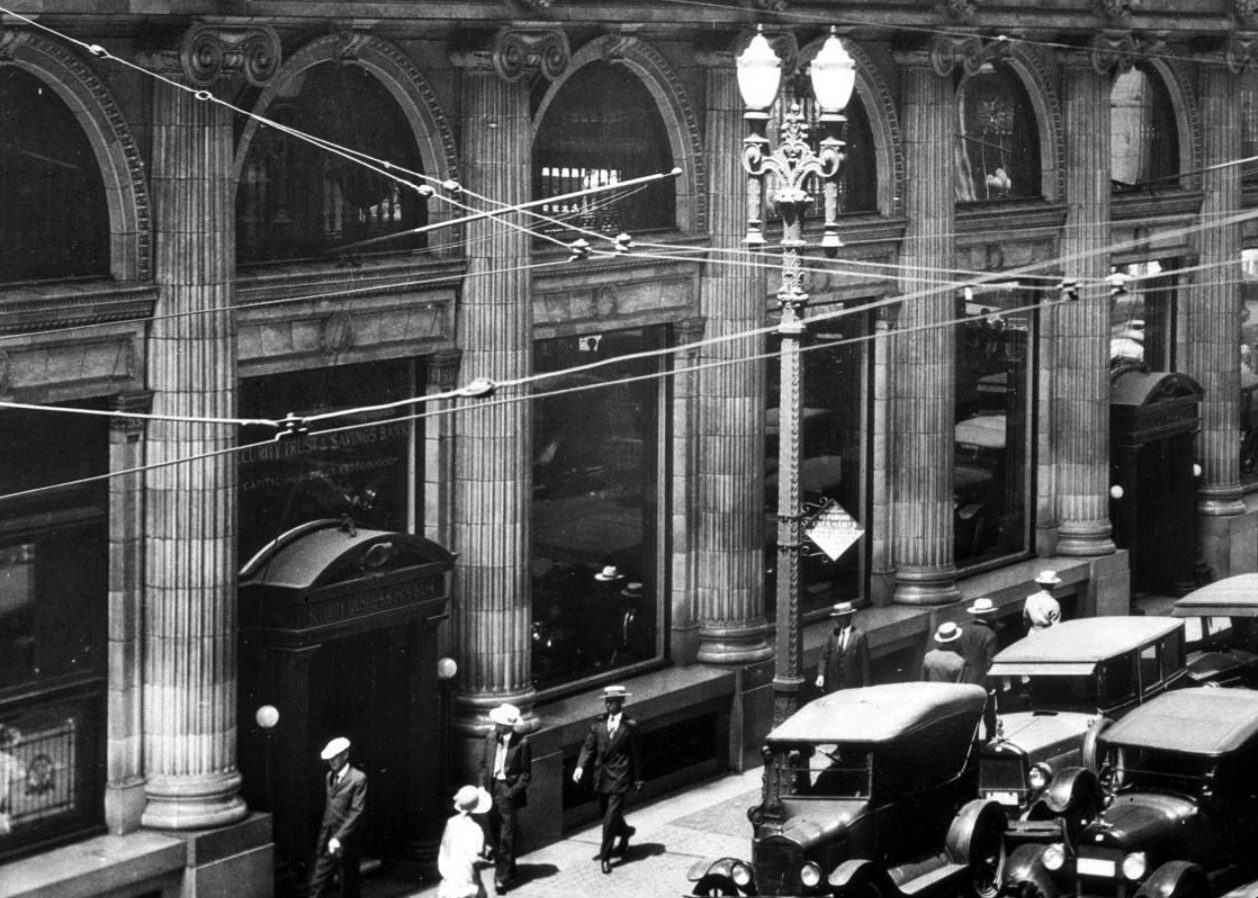 |
|
| (1924)^^ – An ornate two-lamp Llewellyn 'Broadway' streetlight stands near the front entrance to the Security Building located on the SE corner of Spring and 5th streets in Downtown LA. This electrolier resembled the 'Broadway Rose' except for two things: 1) the lamp design was different and 2) it wasn’t located on Broadway. |
* * * * * |
Bridge Lighting
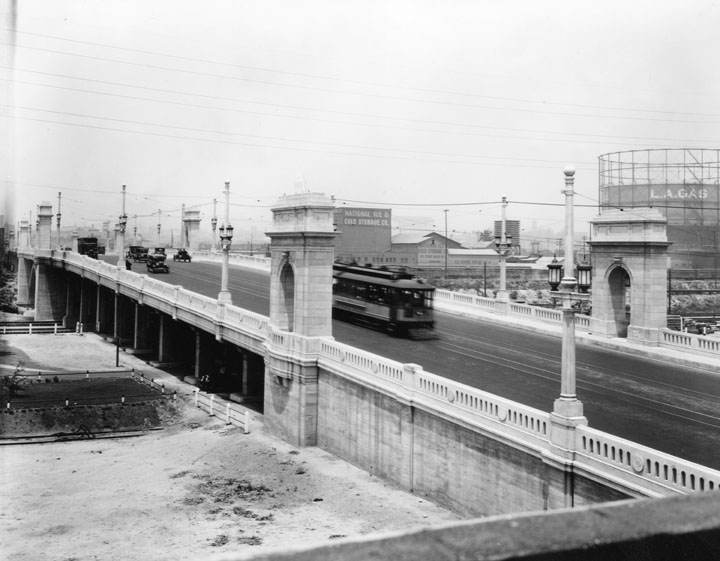 |
|
| (1920s)* - The 1st St. Bridge as viewed from across the street. A trolley and several cars can be seen driving across the bridge. Note the ornate streetlight design that consists of a three-prong configuration with the center bulb taking on a different shape than that of other two. |
Historical Notes Special ornamentation was common on bridges constructed between 1900 - 1928. These poles serve two purposes: 1) to hold the decorative streetlight lanterns and 2) to support the overhead for the Los Angeles Railway (LARy) streetcars that used the bridge. |
.jpg) |
|
| (1930s)^ - Looking up at the 1st Street Bridge showing the hybrid type streetlights along its siding. Note the trolley wire connected to the post just below the top lamp. |
Historical Notes See More Bridge Lighting (College Street Bridge; First Street Bridge; Fourth Street Viaduct; Fourth and Lorena Streets Bridge; Glendale-Hyperion Bridge; Macy Street Bridge; Mulholland Bridge; Sixth Street Bridge; Washington Blvd Bridge) |
* * * * * |
Downtown
.jpg) |
|
| (ca. 1923)*^ – View looking at the northeast corner of Hill and 12th streets showing the back side of the Examiner Building. An ornate 5-bulb streetlight stands on the corner with a line of billboards behind it. |
Historical Notes This five-globe streetlights were originally installed on all streets in Downtown Los Angeles in the early 1900s, (except for Broadway which had the seven-globe lights). Today, the last of these poles are still being used as architectural features in the gardens and malls adjacent to City Hall. |
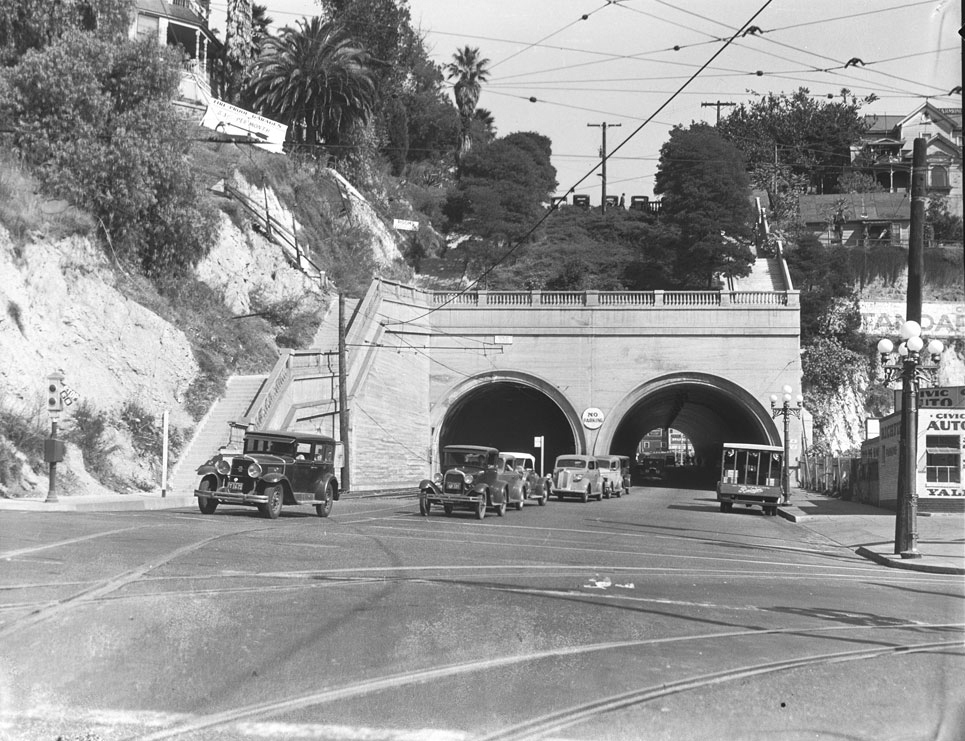 |
|
| (ca. 1923)*^ - Hill Street and 1st looking north toward the Hill Street Tunnel. Ornate 5-lamp electroliers appear on the east side of the Hill Street. |
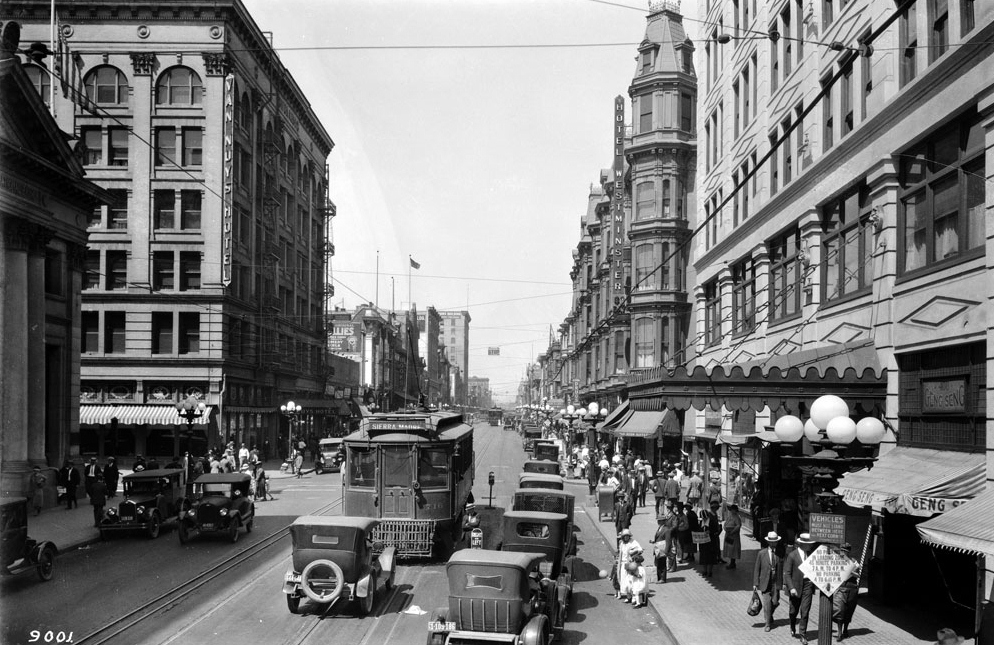 |
|
| (ca. 1924)*^ - Decorative 5-bulb streetlight lamps can be seen running down both sides of Main Street near 4th. |
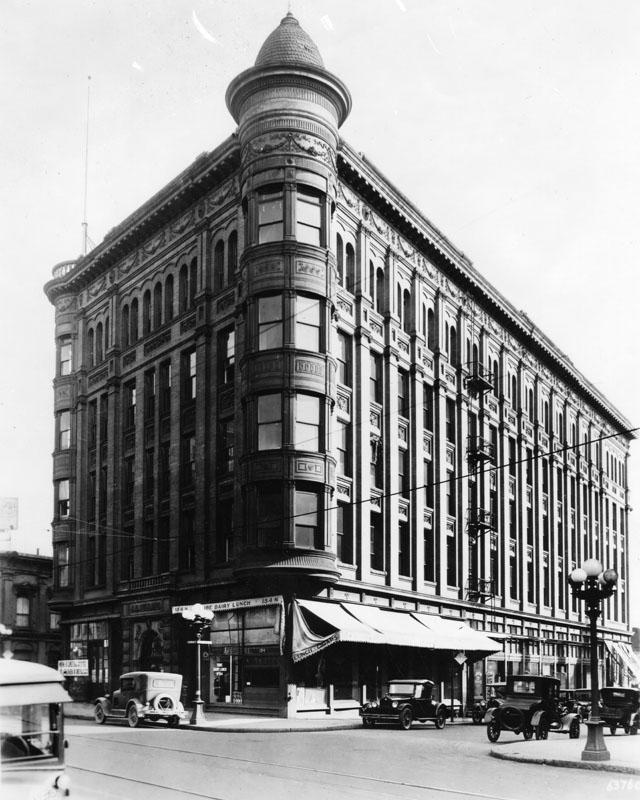 |
|
| (ca. 1925)^ - Exterior view of the Bullard Block located on the northeast corner of Spring and Court streets. At one time the building housed the courthouse. Note the ornate 5-bulb lamps on the corners. This will be the location of the current 1928-built City Hall. |
* * * * * |
Residential Lighting
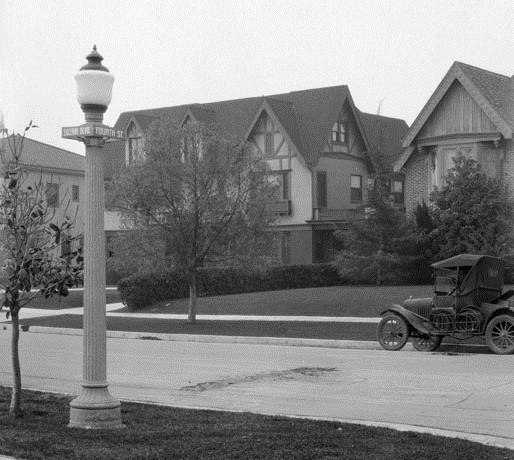 |
|
| (ca. 1920s)* - Residential streetlight lamp on Fourth Street. Note that the street sign is attached directly to the streetlight concrete post. |
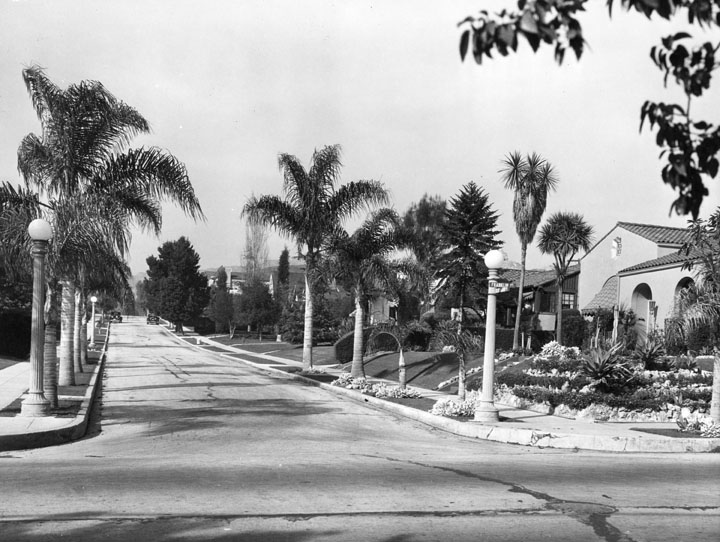 |
|
| (ca. 1925)* - Single-lamp streetlights in a residential area. View is south on Serrano Ave. from the corner of Franklin showing a tree-lined street with well-kept lawns in the Los Feliz district, built in the early 1920s. |
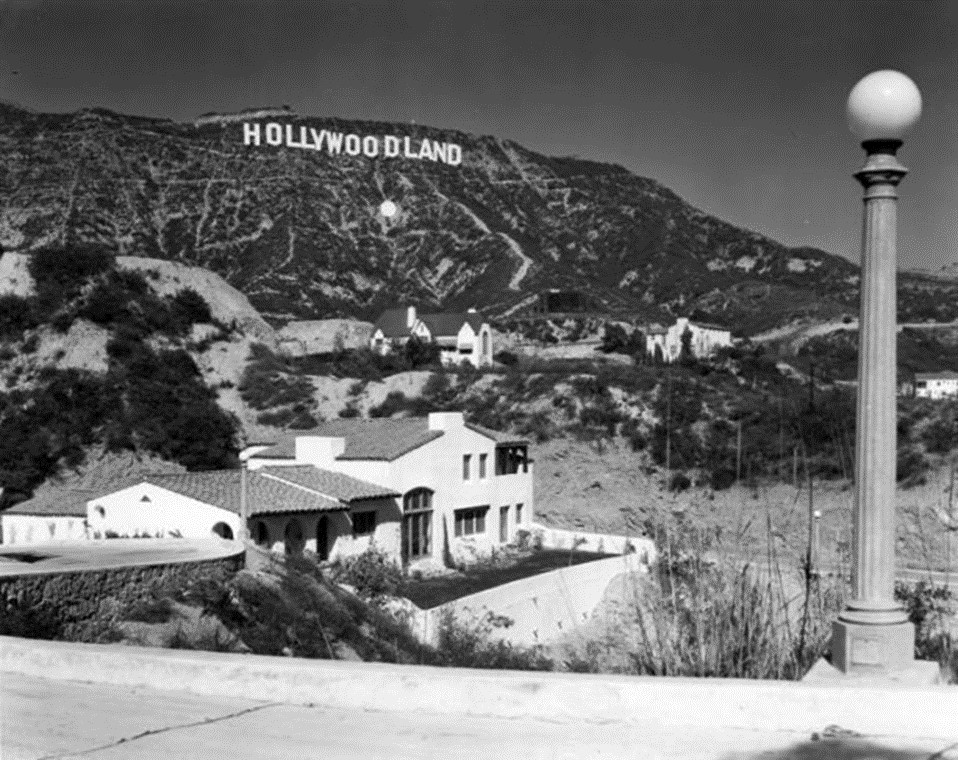 |
|
| (ca. 1926)^ - View of the HOLLYWOODLAND* sign with homes seen in the foothills. Note the single-bulb streetlight on the right. This was the type of lamp used in Hollywood's residential neighborhoods during this time period. |
Historical Notes The story behind the White Dot located under the Hollywoodland Sign: In 1920-21, the US Chamber of Commerce produced maps illustrating business conditions in areas of the country. Those shaded black were poor, white with black stripes (grey) were fair and white was good. Los Angeles was a “white spot” in a sea of black and grey on the map in the early 1920s. Los Angeles Times publisher, Harry Chandler adopted the catchprase, “White Spot Of America” as being a city free of crime, corruption and communism. Chandler, who was vehemently anti-union, was an influential proponent of developing a strong economic base in Los Angeles. It wasn’t long before the phrase “keep the white spot white” was being commonly used. The term “white spot” typically referred to LA”s relative prosperity and low unemployment, and was not intended to have racial overtones. So, for Los Angeles, the term, “keep the white spot white” meant keep L.A. prosperous. In late 1924, in order to demonstrate support for the “keep the white spot white”, campaign, Hollywoodland erected a 35 foot diameter “white dot” on the hillside, several feet below the Hollywoodland sign. The cost to erect the dot was $936.16. Contrary to popular belief, the white dot was not illuminated.* Click HERE to see more Early Views of 'Hollywoodland'. |
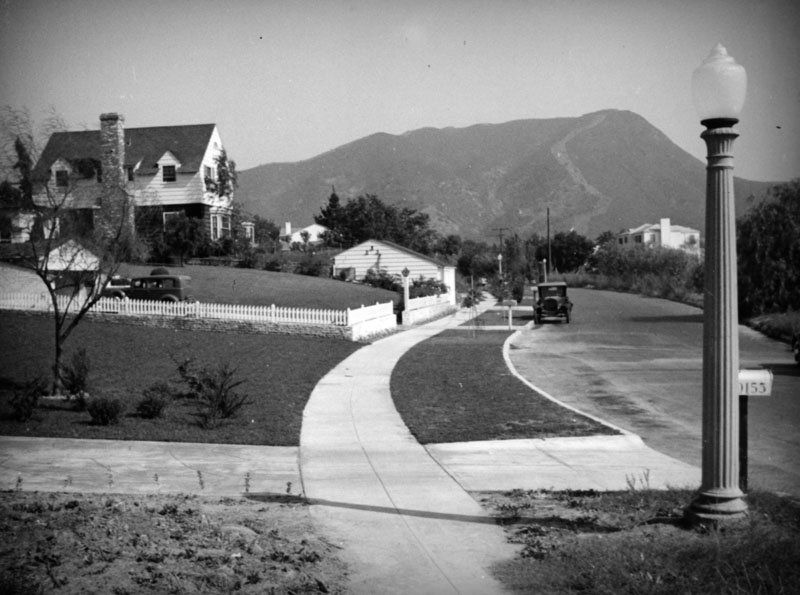 |
|
| (ca. 1936)^ - Single-post street lamp in Toluca Lake. This type of lamp was commonly installed in residential areas throughout the 1930s and 1940s. |
* * * * * |
'Western' Dual-Lamp Llewellyn Electrolier
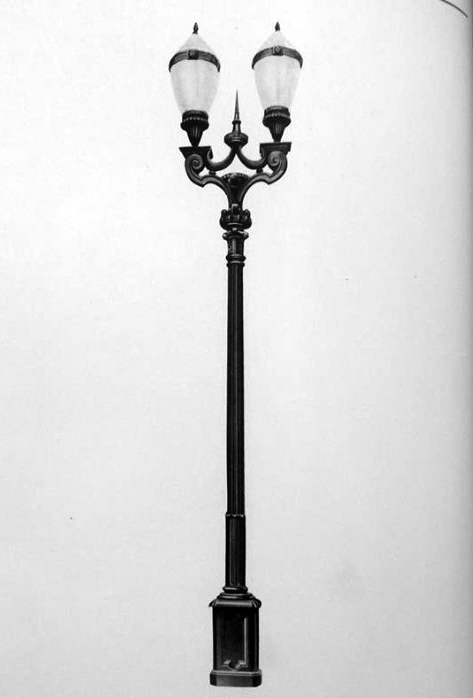 |
|
| (1928)^.^ - The ‘Western’ dual-lamp streetlight as seen in the Llewellyn Iron Works Catalog. |
Historical Notes The "Western" was once found on Western Avenue as well as Santa Monica Boulevard in Hollywood. There were also a few outliers along Sunset Boulevard. None of the ‘Western’ posts survived. Its look-alike cousin, the Llewellyn “Washington”, can still be found in Downtown LA. |
.jpg) |
|
| (1924)*^ – View looking south on Western Ave at Maplewood Ave showing “Western” dual-lamp Llewellyn electroliers standing at the corners of the intersection. |
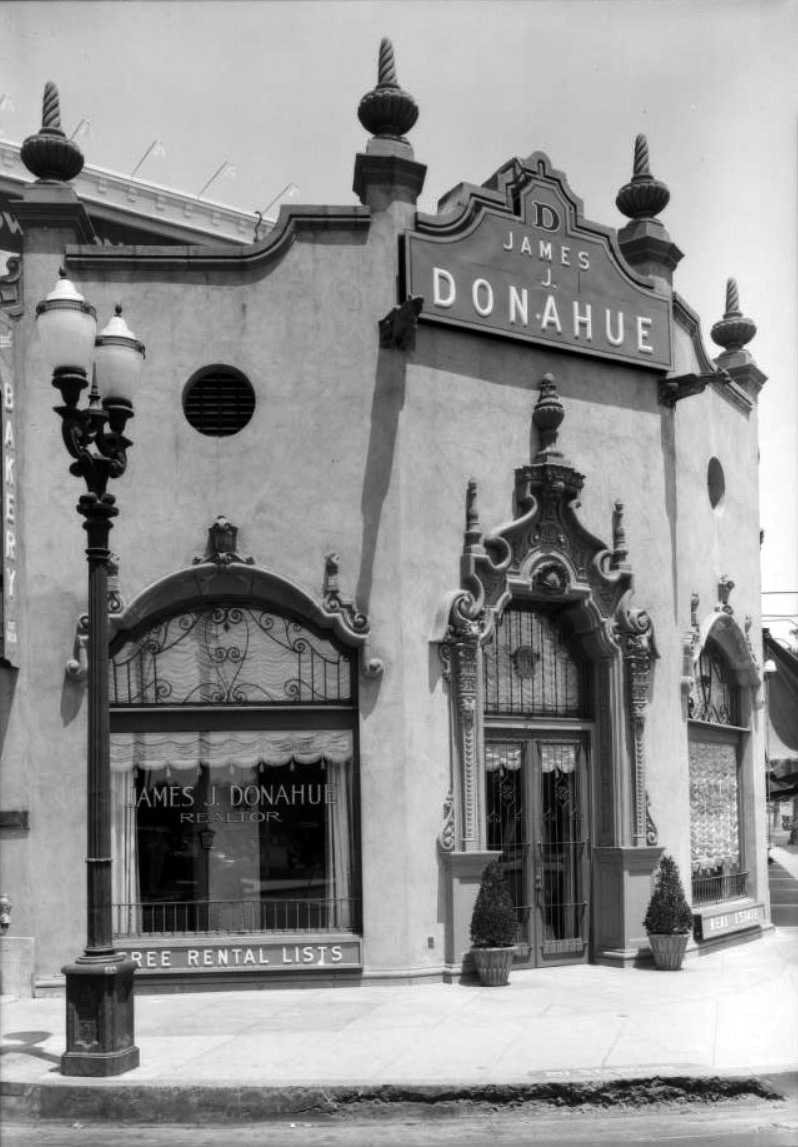 |
|
| (1925)*^ – View showing a ‘Western’ dual-lamp electrolier standing in front of the James J. Donahue Real Estate office on the corner of Wilshire Boulevard & South Western Avenue. |
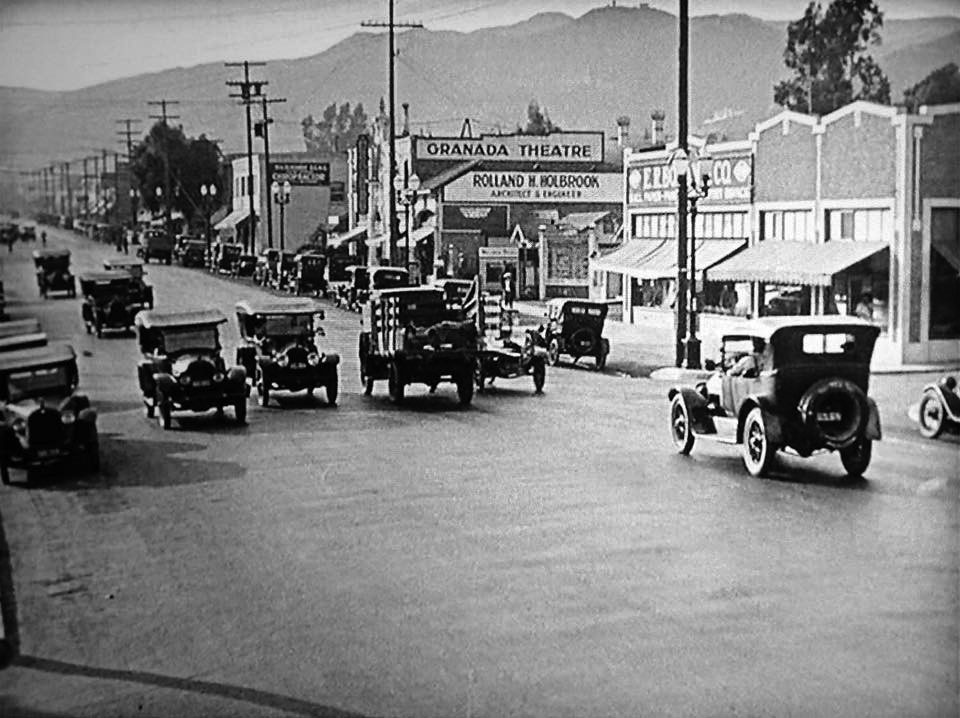 |
|
| (ca. 1921)^.^ – View looking west on Sunset Boulevard at Vista Street showing dual-lamp Western electroliers on the north side of the street, with the Granada Theatre (later Oriental Theatre seen at center of photo. |
.jpg) |
|
| (ca. 1932)*# - View of the north side of Sunset Boulevard showing a 'Western' dual-lamp electrolier in front of the Oriental Theatre (originally Granada Theatre). |
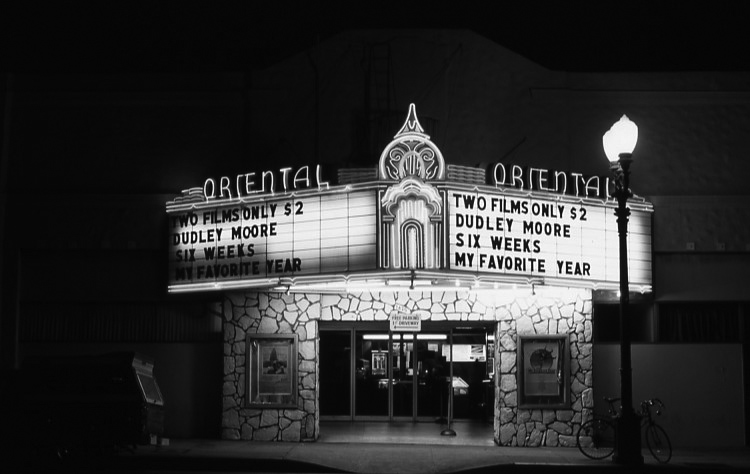 |
|
| (1983)^^ – A ‘Western’ dual-lamp lights up the street in front of the Oriental Theatre. |
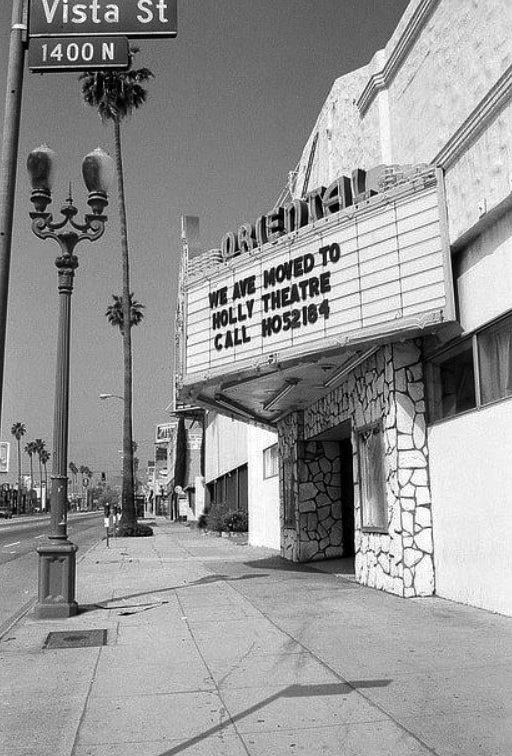 |
|
| (1985)^^ - "Western" Electrolier with painted-out globes located in front of the Oriental Theatre at 7425 Sunset Boulevard near Vista Street, Hollywood. |
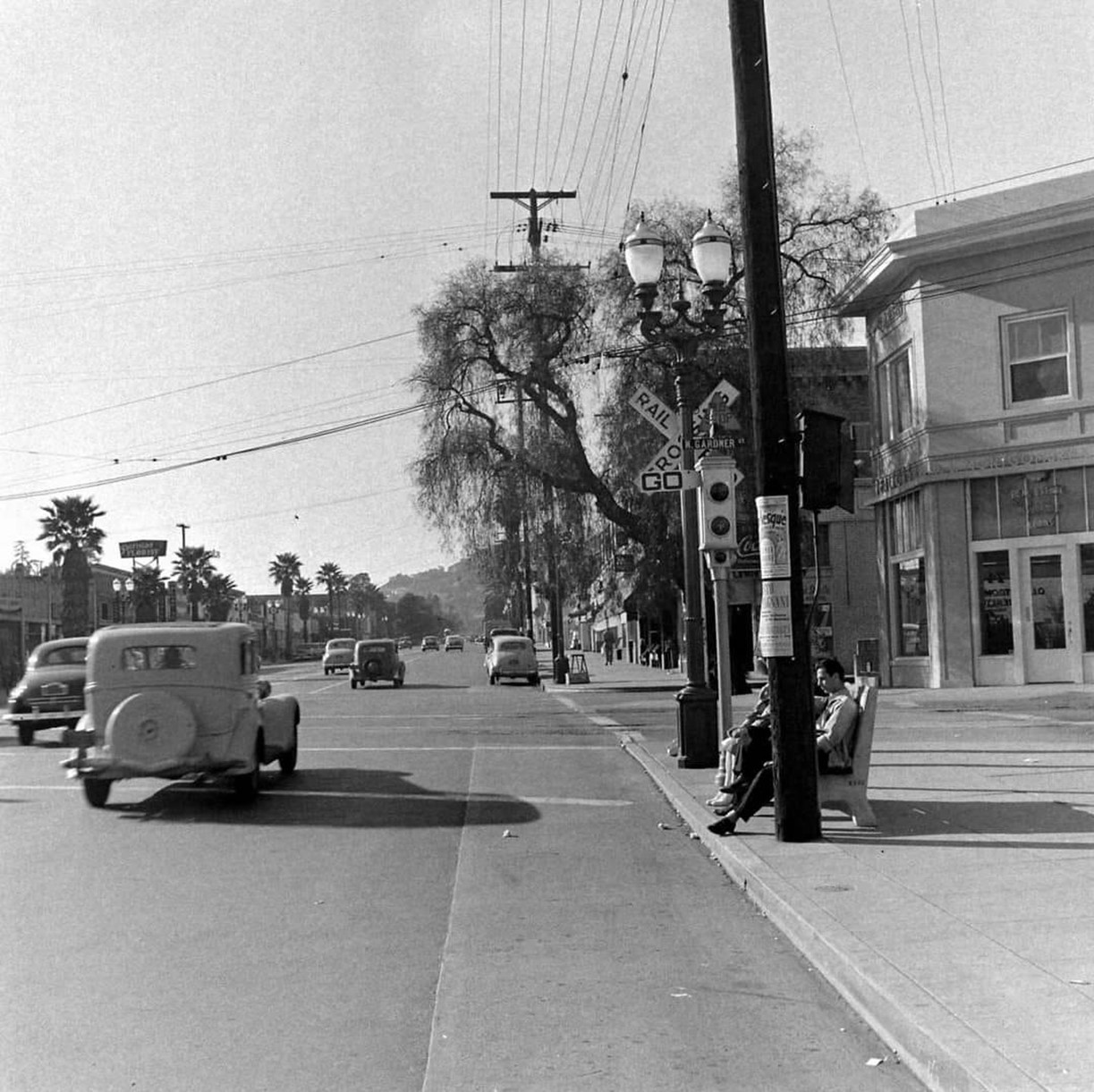 |
|
| (1948)* - Looking west on Sunset Boulevard at Gardner Street showing a 'Western' dual-lamp electrolier standing in between a rail crossing sign and a Semaphore traffic signal. This is at the Pacific Electric Red Car crossing known as Gardner Junction. |
* * * * * |
'Pico' Five-Globe Llewellyn Electrolier
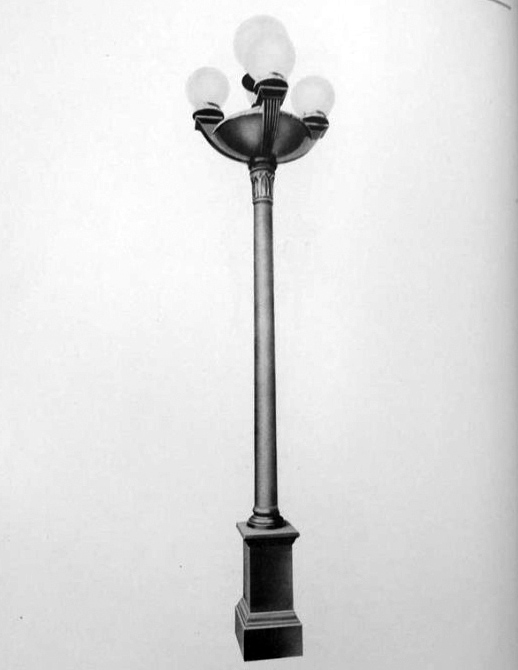 |
|
| (1928)^.^ - The "Pico" electrolier as seen in the 1928 Llewellyn Iron Works Catalog. |
Historical Notes This ornate 5-globe streetlight was found on Pico Boulevard from Main Street on the East to Vermont Avenue on the West. |
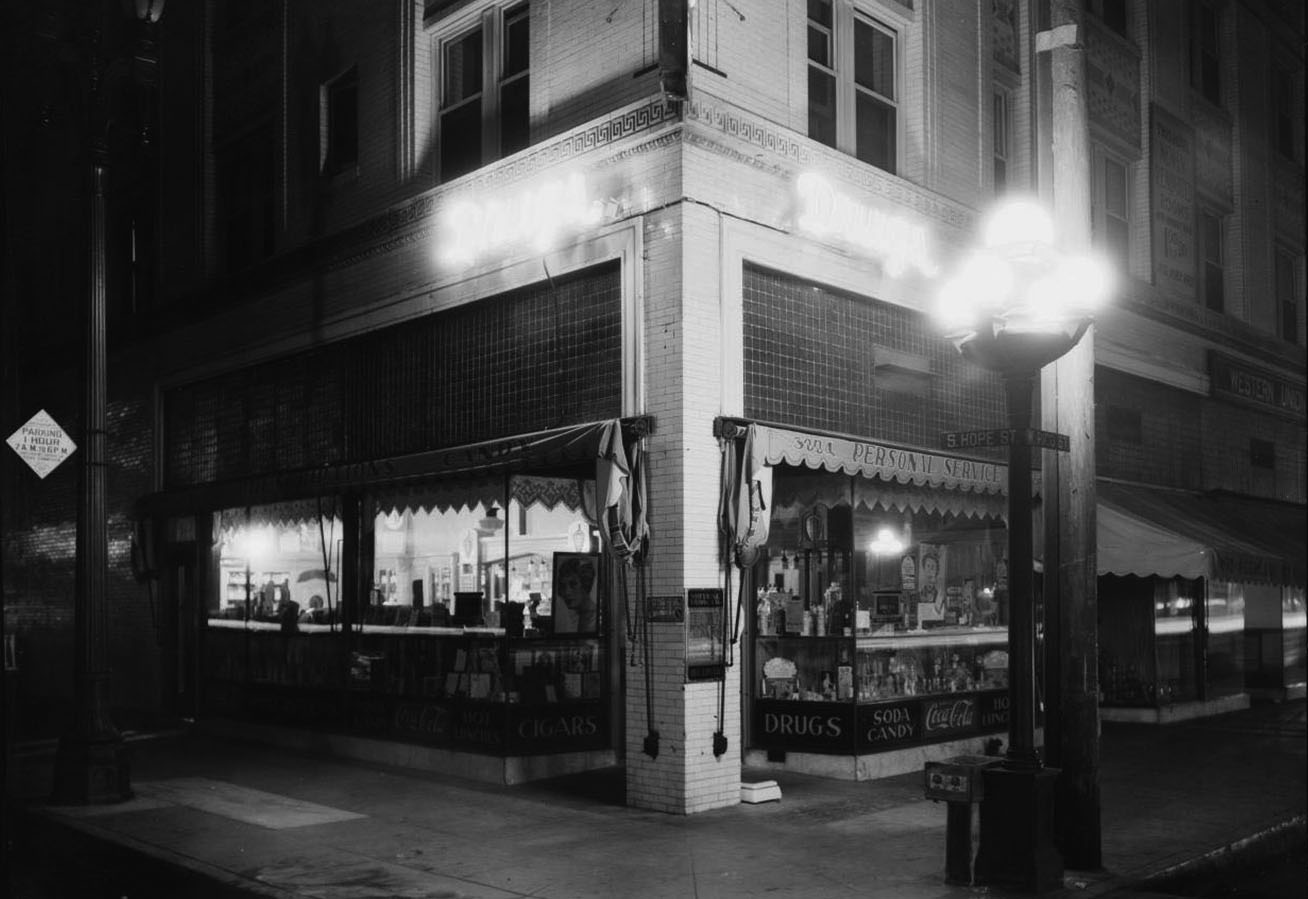 |
|
| (1926)* - A 5-globe Llewellyn "Pico" streetlight illuminates the sidewalk in front of a drug store located on the corner of Hope Street and West Pico Boulevard. |
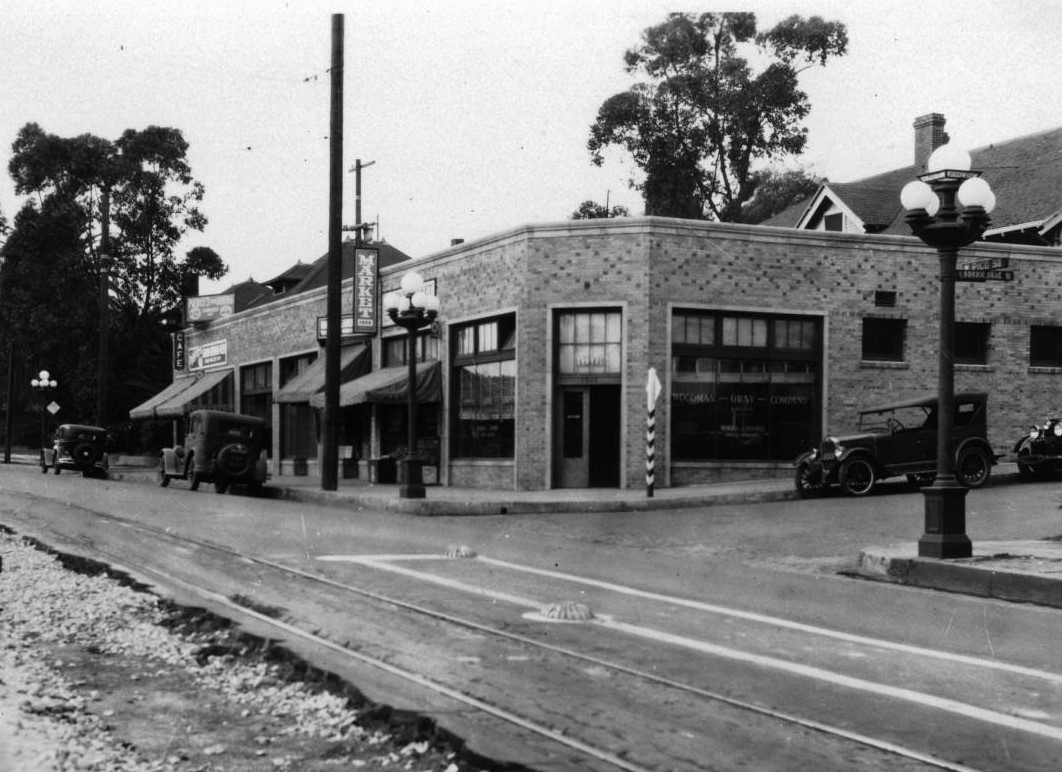 |
|
| (1928)*^ – View looking west on Pico Boulevard at Bonnie Brae Street with Pico Llewellyn Electroliers seen on the corners. The above building located on the NW corner (1901 W. Pico) still stands today. Click HERE for contemporary view. |
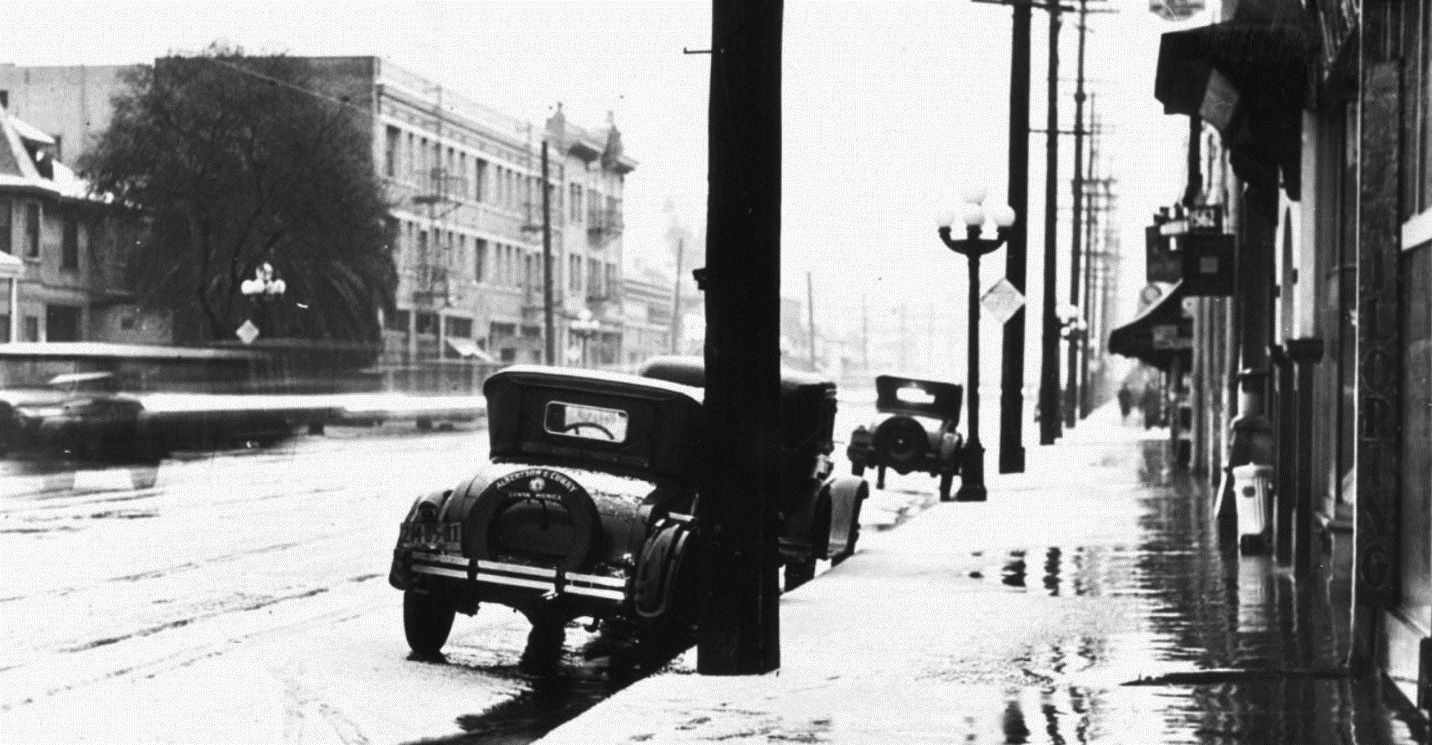 |
|
| (1930)*^ - Ornate 5-bulb Llewellyn Electroliers line both sides of the street in this view of Pico Boulevard east from Union Avenue. |
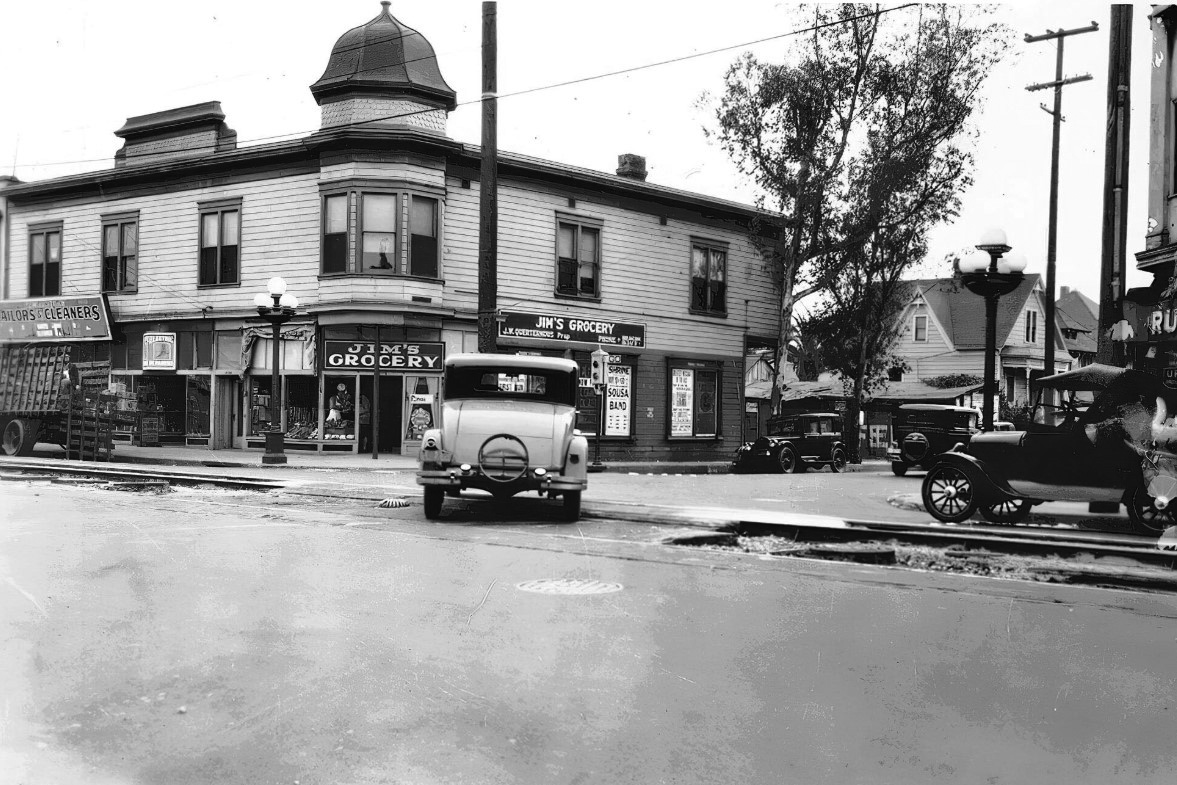 |
|
| (ca. 1932)^.^ – View showing two 5-bulb Pico Llewellyn Electroliers on the south side of Pico Boulevard at Union Avenue. |
* * * * * |
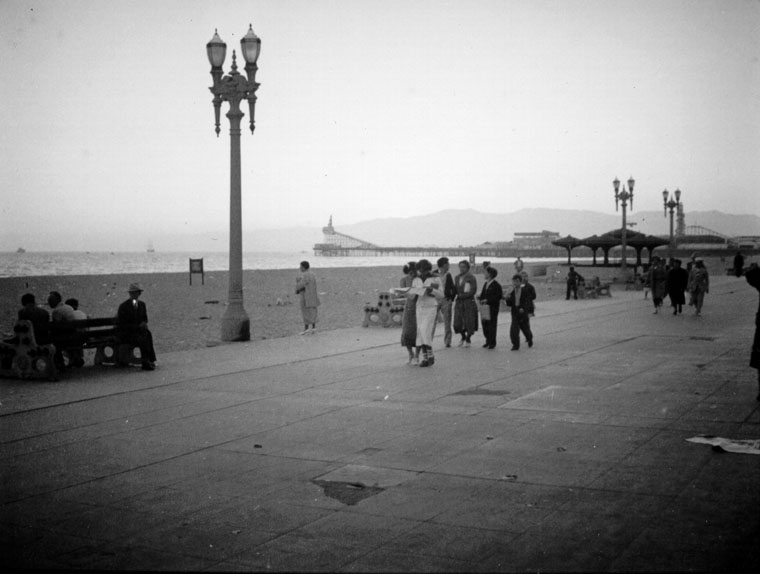 |
|
| (ca. 1926)^ - Two-lamp electroliers are seen along the side of the walkway at Venice Beach. |
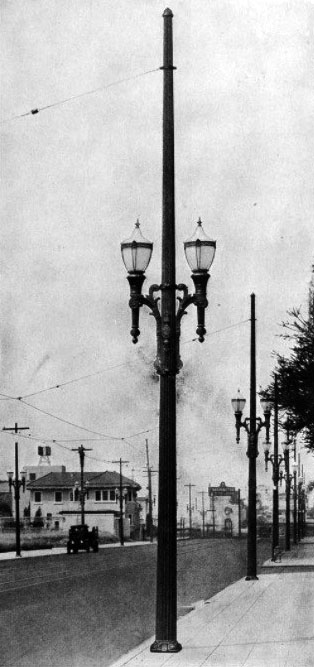 |
(1931)^x^ - View looking west on 8th Street toward Western Avenue showing dual-lamp electroliers running down both sides of the street. Also seen are power lines and streetcar wire attached to the top of the streetlight posts above the lamps. |
|
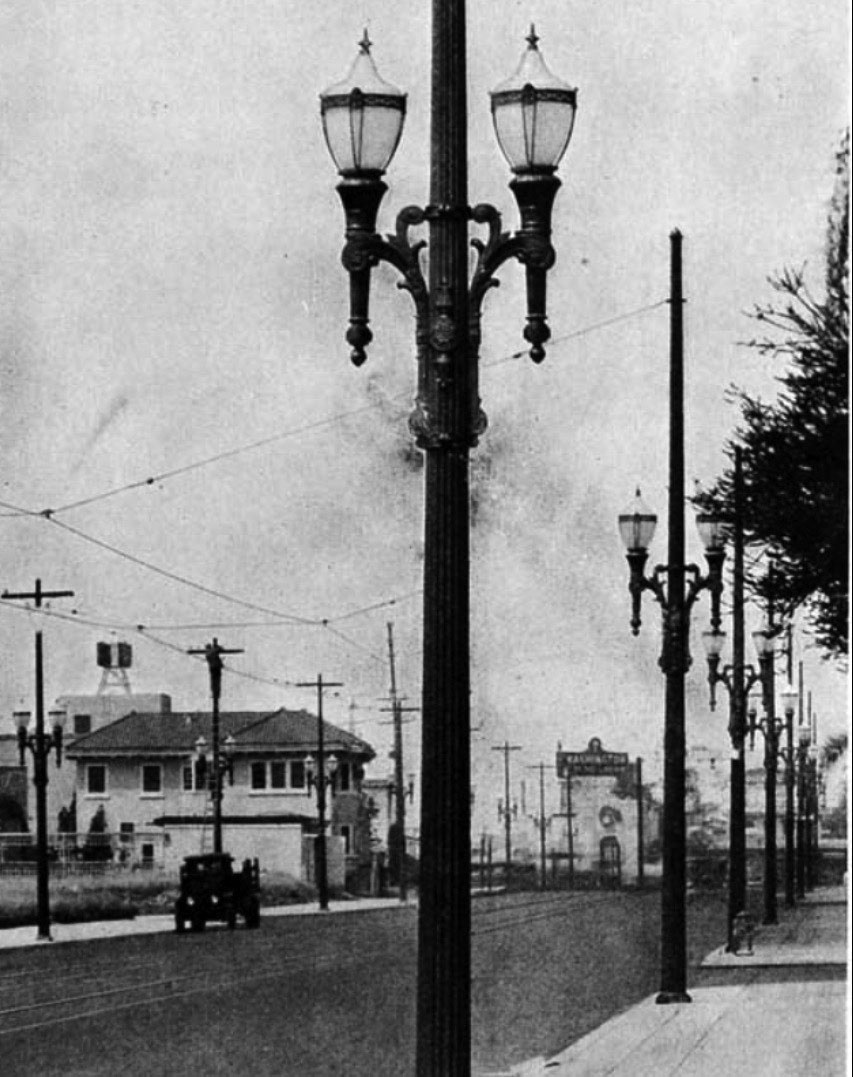 |
|
| (1931)^x^ – Close-up detailed view showing the ornate design of the dual-lamp electrolier. Note the utility worker high up on the streetlight post across the street, probably working on the streetcar cable. |
Please Support Our CauseWater and Power Associates, Inc. is a non-profit, public service organization dedicated to preserving historical records and photos. We are of the belief that this information should be made available to everyone—for free, without restriction, without limitation and without advertisements. Your generosity allows us to continue to disseminate knowledge of the rich and diverse multicultural history of the greater Los Angeles area; to serve as a resource of historical information; and to assist in the preservation of the city's historic records.
|
More Historical Early Views
Newest Additions
Early LA Buildings and City Views
History of Water and Electricity in Los Angeles
* * * * * |
References and Credits
* DWP - LA Public Library Image Archive
^ LA Public Library Image Archive
^^Bureau of Street Lighting Image Archive
#*Library of Congress: 4th and Lorena Street Bridge Light
#^San Fernando Valley History Digital Library - CSUN Oviatt
#+Facebook.com: Classic Hollywood/Los Angeles/SFV
***Huntington Digital Library Archive
*^^Nuestra Señora la Reina de los Ángeles - losangelespast.com
^^*Noirish Los Angeles - forum.skyscraperpage.com; Windsor-Wilshire
^^^California State Library Image Archive
^**Vintage Los Angeles: Trocadero Nightclub ; Hollywood and Vine
*^*Photo Ramblings - Garth Buckles
^*^Mail Online - Daily Mail Reporter
^#^LA Times: Amestory Building
*#*Flicker: smgerdes - 4th Street Bridge Lights
*#^LAPL-El Pueblo de Los Angeles Historical Monument Photo Archive
^#*Facebook.com - Los Angeles Theatres: Warner Bros. Downtown
**#San Fernando Valley Relics - Facebook.com: Van Nuys Blvd., Ca. 1940
^^#Flickr.com: Michael Ryerson
*^#Facebook.com - Bizarre Los Angeles
^*#California State Library Image Archive
^##Boyle Heights History Blog: Introduction of Electric Light to Boyle Heights
+##MartinTurnbull.com: Fairfax and Wilshire
#*^Facebook.com - San Pedro's Original Website, San Pedro.com
#^*Facebook.com: West San Fernando Valley Then And Now
#^^Facebook.com - Bizarre Los Angeles
^x^Facebook.com: So. Calif. Historic Arrchitecture
^* Wikipedia: Los Angeles Country Art Museum; Hollywood Playhouse (Avalon Hollywood); MacArthur Park
< Back
Menu
- Home
- Mission
- Museum
- Major Efforts
- Recent Newsletters
- Historical Op Ed Pieces
- Board Officers and Directors
- Mulholland/McCarthy Service Awards
- Positions on Owens Valley and the City of Los Angeles Issues
- Legislative Positions on
Water Issues
- Legislative Positions on
Energy Issues
- Membership
- Contact Us
- Search Index